- Kilimanjaro Besteigung
- Mt Meru Besteigung
- Mt Kenia Besteigung
- Gorilla Trekking
- Private Safaris
- Private Touren
- Flugsafaris
- Mobile Explorer Camp
- Afrika Reiseblog
- Self-Propelled

- Afrika - aus den Augen unserer Guides
- Hintergrundinfos
- Reiseberichte
- Afrikanische Küche
- Veranstaltungen
- Zur Blog Übersicht
Sie möchten sich für den Newsletter anmelden und mit Neuigkeiten zu spannenden Afrika-Reisen auf dem Laufenden gehalten werden?
Veröffentlicht am 11. September 2023 von Juan Proll

Wann ist die beste Reisezeit für eine Safari in Afrika?
Ob in Südafrika, Namibia, Botswana, Tansania, Kenia oder Uganda: Wann ist die beste Reisezeit für eine Safari in Afrika ? Antworten für das östliche und südliche Afrika findet ihr hier heute im Überblick.
Inhaltsverzeichnis
Zu den beliebtesten Fragen der Reisenden an mich als Guide gehört zweifelslos die Frage, was ich für die beste Reisezeit halte. Grundsätzlich bin ich der Überzeugung, dass die Antwort auf diese Frage sehr individuell sein kann. Es kommt eben auf die Interessen an, die man mit einer Reise nach Ostafrika oder ins südliche Afrika verbindet. Und ich sage das nicht, um mich vor der Antwort zu drücken. Im Gegenteil. Ich möchte damit sagen, dass Afrika ein ganzjähriger Reisespaß sein kann.
Wann ist die beste Reisezeit für eine Safari in Afrika – generelle Anmerkungen
Grundsätzlich lässt sich das Wetter im Süden und Osten Afrikas in Trockenzeit und Regenzeit unterteilen. Sie bringen unterschiedliche Temperaturen und landschaftliche Bedingungen mit sich, die das Leben der Tierwelt aber auch das Verhalten der Tourismusbranche und der Reisenden beeinflussen. Mit der folgenden Gegenüberstellung von Regen- und Trockenzeit habt ihr bereits eine erste Gelegenheit zu schauen, wo ihr euch eher wiederfindet.

- Mit dem Regen fällt so manche Planung ins Wasser, weil er nicht immer und überall in vergleichbarer Weise berechenbar ist. Wann er kommt und wie stark er fällt, ist zum Beispiel in Tansanias Hauptregenzeit einfacher vorherzusagen als in Namibias.
- Häufig begleiten heißere Temperaturen und schwülere Bedingungen die Regenzeit.
- Diese Bedingungen mögen Schlangen, Skorpione, Spinnen und Insekten wie Mücken und Malariamücken.
- Vögel mögen diese Bedingungen auch sehr. Und so migrieren viele von ihnen aus kälteren und trockenen Regionen in die Regenzeit-Domizile.
- Die Säugetiere sind nicht gerade Regenfans und suchen gerne Schutz, wenn es losgeht. Überhaupt werden sie „unsichtbarer“, weil sie jetzt auch Wasser überall finden und nicht extra zu Wasserstellen laufen müssen.
- Die Straßenbedingungen werden schwieriger. In einigen Gebieten ist entweder kein oder nur kaum ein Durchkommen möglich. 4×4 Fahrzeuge sind unvermeidlich. Ideal für Abenteuersuchende, die den extra Thrill haben möchten.
- Für Wanderfreunde bedeutet die Regenzeit in den Wandergebieten erschwerte Bedingungen. Die Wege weichen auf, werden matschig oder sind nicht passierbar.
- Da es anders als zum Beispiel in Deutschland eher nie endlos regnet, kann man sich viele Abende bei klarer warmer Luft noch lange auf die Veranda setzen.
- Mit einem bisschen Glück darf man in der Nacht aber mal ein deftiges tropisches Gewitter miterleben. Der Weltuntergang scheint nah und erhöht die Kuschellaune.
- Die Landschaft blüht auf, kleidet sich grün, blumt bald in allen Farben und schafft mit seinen Wolkenformationen dramatische Szenerien oder herrliche Wolken- und blauer-Himmel-Harmonien. Da freut sich die Fotolinse.
- Generell sind weniger Menschen unterwegs, Unterkünfte und Touren lassen sich schwieriger verkaufen und so fallen die Preise: Nebensaison. Bestens geeignet für vergünstigte Reisepreise und eine flexiblere Planung.
Zwei unserer Lieblingssafaris auch während der offiziellen Regenzeit:

Kenias Norden – Abgeschiedenheit erleben
Der Geheimtipp für Safariliebhaber: Abseits der regulären Touristenpfade erleben Sie auf dieser Privatsafari drei beeindruckende Naturschutzgebiete im Norden Kenias. Solio Game Reserve, Ol Pejeta Conservancy & Samburu Nature Reserve bieten unvergessliche Safarierlebnisse.

Faszination Südafrika
Erleben Sie die Highlights von Südafrika in drei Wochen: Blyde River Canyon, Krüger Nationalpark, Südafrikas Ostküste und Durban, Port Elizabeth und nicht zu vergessen die Fahrt entlang der Garden Route bis nach Kapstadt.
Trockenzeit
- Schlechtes Wetter und schlecht befahrbare Straßen entfallen weitestgehend und stehen den Urlaubsplanungen nicht mehr im Weg.
- Die kühleren Temperaturen und die trockenere Luft vereinfachen die Atmung, verhindern übermäßiges Schwitzen und machen den Schlaf angenehmer.
- Gleichzeitig halten die kühleren Temperaturen Schlangen, Skorpione und viele Spinnen davon ab, sich in der Öffentlichkeit zu zeigen. Den Malariamücken wird es vor allem zu trocken, um sich gut reproduzieren zu können. Damit fällt das Malariarisiko deutlich.
- Vielen Vögel wird es in dieser Zeit auch zu kalt. Sie migrieren dann gerne in die wärmeren Zonen des Kontinents oder in Übersee.
- Den Säugetieren trocknet mehr und mehr das Wasser weg und veranlasst sie, zentrale Wasserstellen aufzusuchen. Auch dörrt die Landschaft aus und sichtbehinderndes Strauch- und Blätterwerk verschwindet. Das führt in der Regel dazu, dass man die Tiere besser entdeckt.
- Je nachdem wie kalt es wird, kann man jetzt mit einem bisschen Glück sogar nachtaktive Tiere, wie zum Beispiel Aardvarks, noch vor Einbruch der Dunkelheit sehen, bevor es so richtig abkühlt.
- Die austrocknende Landschaft und der fehlende Wolkenkontrast mindern die Möglichkeiten der Landschaftsfotografie.
- Der freie Blick auf den Himmel ermöglicht aber beste Aussichten in die Sternenwelt.
- Warme Klamotten für den frühen Morgen und der Zeit nach Sonnenuntergang sollten im Gepäck enthalten sein.
- Viele haben genug vom Regen in der Heimat, wollen Sonne und strömen ins Land: Hauptsaison. Unterkünfte und Touren werden teurer, das Budget zuweilen stärker belastet. Früh buchen und damit frühes Festlegen gewinnen an Bedeutung.
Mit uns Afrika und die Wildnis entdecken. Melde dich bei uns !
Die beste Reisezeit in Afrika – Ein Überblick nach Ländern
Trotz der generellen Unterscheidung von Regen- und Trockenzeit lohnt es, sich die Länder im Einzelnen anzuschauen. Hier und da finden sich Besonderheiten, die auch noch einmal Einfluss auf die Frage „Wann ist die beste Reisezeit für eine Safari?“ nehmen können.
Uganda ist ein Binnenland ohne direkten Zugang zum Meer. Ein Meeresklima gibt es hier also nicht. Seine Lage am Äquator und leichte klimatische Unterschiede im Norden des Landes gegenüber dem Zentrum und Süden beeinflussen Ugandas Wetterlage. Die große Regenzeit ist von Ende März bis Anfang Juni. Im Norden aber – sieht man vom sehr hohen halbwüstenartigen Norden an der Grenze zum Sudan einmal ab – scheint es gefühlt ohne Trockenzeit bis in die zweite, kleinere Regenzeit vom September/Oktober bis November hinein weiterzuregnen. Im Zentrum und der Südhälfte, dort wo auch die beliebtesten Sehenswürdigkeiten für Safaris (z.B. Queen Elizabeth Nationalpark ) und Wanderungen (z.B. Rwenzori Mountains oder Mgahinga Gorilla Nationalpark) sind, ist die Haupttrockenzeit von Juni bis September . Eine weitere folgt von Dezember bis März .

Die äquatoriale Lage sichert im Jahresverlauf relativ geringe Temperaturschwankungen. Während die Temperaturen tagsüber meist nicht 30 Grad Celsius übersteigen, pendeln sie sich nachts auf durchschnittlich 17 Grad Celsius ein und fallen selten auf unter 7 Grad Celsius. In den Höhenlagen über 1300 Metern und vor allem über 5000 Metern kann es dagegen auch mal in Minusgrade abstürzen.
Wer speziell am Gorilla Trekking interessiert ist, kann das sowohl in den Virunga Mountains als auch im Bwindi Impenetrable Forest ganzjährig tun. Über den Berghängen regnen sich das ganze Jahr Regenwolken ab. Dennoch habt ihr hier in den Trockenmonaten eine größere Chance, dass die Tour nicht wegen zu starken Regens ausfällt. Die Hauptregenzeit hat dagegen vor allem den Vorteil, für dieses einzigartige Erlebnis einige hundert Dollar weniger zu bezahlen.
Wann ist die beste Reisezeit für eine Safari? Kenia
Auch Kenia ist ein Land am Äquator, aber noch stärker von Temperaturschwankungen verschont als Uganda. In den niederen Gebieten spielt sich das Tag-Nacht-Geschehen zwischen 20 und 33 Grad Celsius ab. Allerdings gibt es auch hier hohe Berge über 5000 Meter und Temperaturen bis weit unter Null Grad Celsius. Aber Wanderbegeisterte, die zum Beispiel den Mt Kenya besteigen wollen, schockt das sicher nicht. Wer lieber ein gemütliches Sommerklima haben möchte und nach einer Safari oder Wanderung gerne noch ans Meer will, kommt am besten während der langen Trockenzeit von Juni bis Oktober sowie der kurzen Trockenzeit von Januar bis Februar . Im März folgt bis Mai die lange Regenzeit. Eine Zugabe gibt es dann noch einmal im November und Dezember.

Wann die beste Reisezeit in Kenia ist, hängt auch hier von Interessen ab. Wer speziell die Große Tierwanderung im Land sehen möchte, ist in der Trockenzeit richtig aufgehoben. Es sind die Monate zwischen Juli und Oktober, wo sie den Marafluss überqueren, dass frische Gras in Kenia abkauen und wieder zurück nach Tansania verschwinden. Wann es genau passiert, lässt sich aber nicht exakt bestimmen. Der Grund dafür ist nicht ein unzuverlässiger Terminplan des millionengroßen Trecks. Vielmehr liegt es an der Eigensinnigkeit des Wetters und am Klimawandel, was Voraussagen immer schwieriger macht. Die Tiere folgen dem Regen, der das Gras wachsen lässt. Wenn der nicht kommt, kommen sie auch nicht.
Wann ist die beste Reisezeit für eine Safari? Tansania
Wer sich fragt, wann die beste Reisezeit in Tansania ist, hat auch dort die Qual der Wahl. Es gibt kleine, aber feine Unterschiede von Nord nach Süd. Die berühmten Safari-Gebiete des Nordens bis in den Nordosten hinein freuen sich über zwei Regenzeiten. Eine große zwischen März und Mai, mit besonders viel Niederschlägen im April. Und eine kleine zwischen Oktober/November und Dezember. Zwar prasselt es während der großen Regenzeit nicht ständig herunter, aber dafür konzentriert. In einigen Regionen führt dies zu Überschwemmungen und unpassierbaren Straßen. Dagegen bringt die kleine Regenzeit viele Schauern und Gewitter, zeigt sich aber gnädig, sodass die meisten Schotter- und Sandpisten befahrbar bleiben.

Im extremen Nordwesten, im Landeszentrum sowie vom Südwesten bis zum Südosten schlucken sie allerdings die kleine Trockenzeit, die in den anderen Regionen von Januar bis Februar/März anzutreffen ist. So gibt es landesweit nur eine weitestgehend sichere Trockenzeit von Juni bis Oktober . Die Temperaturunterschiede liegen je nach Jahreszeit zwischen 14 und 33 Grad Celsius. Wer zum Badeurlaub nach Sansibar fliegt, hat konstant Tagestemperaturen um die 25 Grad Celsius und mehr. Allerdings solltet ihr hier die Regenzeiten meiden. Wer will schon gerne am Strand liegen und lieber im Regen als in der Sonne baden. Außerdem tobt sich der Monsun in diesen Zeiten besonders gerne aus.
Die Safaris auf der nördlichen Safari-Route sind, wenn zuweilen auch mit Einschränkungen, ganzjährig machbar. In der Hauptregenzeit schließen einige Unterkünfte. Und wem das egal ist, weil er oder sie denkt, sowieso campen zu gehen, sollte sich das angesichts der Regenmengen noch einmal gut überlegen. Der Großen Tierwanderung in der Serengeti kann man in Tansania durch alle Jahreszeiten folgen. Für diejenigen, die den Kilimandscharo besteigen möchten, sind die Trockenzeitmonate die empfehlenswerteren. Die Wege sind rutschfester und vom „Dach Afrikas“ habt ihr oft die schöneren Aussichten in die Ferne.
Die verschiedenen Klimazonen der Regenbogennation am Kap machen die Frage „Wann ist die beste Reisezeit in Südafrika “ zu einer echten Herausforderung. Die verschiedenen Höhenlagen und zwei grundsätzlich unterschiedliche Meereseinflüsse haben ihren Anteil daran. Während der Indische Ozean entlang der Ostküste milde Meeresluft bringt, liefert der Atlantik im Süden und vor allem der atlantische Benguelastrom entlang der Westküste kühle Meeresströmungen. Man kann aber sagen: Irgendwo im Land ist für jeden die richtige Reisezeit dabei. Zumal Südafrika insgesamt ein sonniges, trockenes, warmes und im Sommer manchmal zu heißes Land ist.

Die Westküste, einschließlich Kapstadt, bezaubert ihre Gäste mit einem meist trockenen und mediterranen Klima. Der Vergleich mit Südeuropa liegt nahe, auch wenn hier die Meerestemperatur selten die 19 Grad Celsius Marke knackt. Wirklich trocken, sogar wüstenartig trocken, ist es in manchen nördlichen Regionen, darunter das Namaqualand, die Karoo und die Kalahari. Auf der Südseite sorgt das Aufeinandertreffen des kalten Atlantiks und des warmen Indischen Ozeans am Kap Agulhas für ein semiarides bis semihumides Klima. Dagegen dominiert im Osten bis hin zur Grenze zu Mosambik fast ganzjährig ein feucht-warmes subtropisches Klima die Wetterlage.
In Südafrika sind die Jahreszeiten auf den Kopf gestellt. In der europäischen Winterzeit laufen im Kruger Nationalpark nach einem Tag auf Safari die Grills heiß, denn hier ist schönster Sommer. Wenn im europäischen Herbst die Einheimischen Laub kehren, fahren die Menschen in Südafrika zu den prächtigen Wildblumenfeldern an der Westküste.
Namib, Namibia – und so könnte man denken, Namibia ist ein einziger Wüstenstaat. Die Kalahari im Osten des Landes verstärkt diesen Eindruck. Warum also überhaupt noch fragen: „Wann ist die beste Reisezeit in Namibia ?“ Wüste? Alles klar, alles trocken, tagsüber immer heiß, nachts schon mal sehr kalt. Aber nein, die Landschaft und das Klima sind vielfältiger als es auf den ersten Blick erscheint. Zugegeben: es ist tendenziell ein arides und subtropisch-kontinentales Klima, hauptsächlich trocken und vor allem in der sommerlichen Zeit von Oktober bis März sehr heiß. In dieser Zeit schaut von Dezember bis März die Regenzeit vorbei, die das zentrale Hochland – mit Ausnahme der südlichen Gebiete – und den Norden und Nordosten bis in den Sambesi-Streifen hinein mit Feuchtigkeit beglückt. Gerade diese Region bekommt auch sonst mal Niederschläge serviert und ist daher auffallend grün.

Anders verläuft es in den Wüstengegenden, die ganzjährig nur wenige Niederschläge erhalten, mit einem deutlichen mehr an Regen in der Kalahari. Doch sehr trocken bleibt es auch hier. Im Sommer können die Temperaturen tagsüber konstant auf über 30 Grad Celsius steigen. In Winternächten stürzen die Temperaturen ab bis auf 6 Grad Celsius, selten weniger, was aber auch vorkommen kann. An der Atlantikküste bestimmt der Benguelastrom mit seiner kalten Meeresströmung aus der Antarktis das Klima. Das sorgt für moderate, aber angenehme Temperaturen. Dennoch kann es sich in den winterlichen Monaten von April bis September schon mal sehr kalt anfühlen, vor allem wenn der Tag mit dichtem Nebel beginnt, was in Swakopmund und Umgebung häufig zu erleben ist.

Ein Besuch des Sandmeeres und seiner Dünen im Sossusvlei ist in den kühleren Wintermonaten deutlich vorzuziehen. Schatten findet ihr hier nur am Parkplatz und die Hitze macht einem schnell zu schaffen. Eine Mehrtageswanderung durch Afrikas größte Schlucht, dem Fish River Canyon , ist nur in den kühleren Monaten erlaubt. Und die meisten Wildtiere in Namibia findet ihr auch am besten in den Trockenzeit-Wintermonaten im Etosha Nationalpark . Vor allem zwischen Mai und Oktober/November ist es dort so regenarm und trocken, dass den Tieren nur noch wenige Wasserlöcher verbleiben, zu denen man als Besucher*in sehr gut hinkommt. Das macht Tierbeobachtungen extrem einfach.
Insgesamt ist die beliebteste Reisezeit in Namibia zwischen Juni und Oktober .
Bleibt die Frage: „Wann ist die beste Reisezeit in Botsuana ?“ Doch wer hier nicht gerade das Budget oder die Sorge zu vieler Menschen im Hinterkopf hat, ist mit der Trockenzeit von Mitte Mai / Anfang Juni bis Ende Oktober / Anfang November am besten beraten. Wer das Land kennt oder meine beratenden Kolleginnen und Kollegen bei Elefant-Tours fragt, kann auch problemlos das ganze Jahr reisen und tolle Begegnungen mit der Tierwelt haben. Doch wer an den Chobe Nationalpark und an das Okavangodelta denkt und beides in größter Wildtierblüte erleben möchte, kommt tatsächlich in den Monaten außerhalb der Regenzeit.

Du umgehst damit auch die besonders heißen Monate, die zwischen Januar und März locker die 30 Grad Celsius übersteigen und auch häufig genug die 40er Marke knacken. Dagegen geht es nachts seltener auf unter 20 Grad Celsius zurück. Der Vorteil in dieser Zeit sind allerdings die fruchtbaren, farbenfrohen Landschaften. Selbst die Kalahari blüht. Die sonst trockenen „Kalahari-Pfannen“ füllen sich mit Wasser und verwandeln den Makgadikgadi-Pan-Nationalpark und Nxai-Pans-Nationalpark in faszinierende Naturpanoramen.
Wer nach diesem Überblick zu der Frage, wann ist die beste Reisezeit für eine Safari in Afrika, noch Rückfragen hat oder Unterstützung bei der Planung einer Afrika-Reise braucht, egal ob auf einer geführten Gruppenreise , einer geführten Individualreise oder Selbstfahrer*in-Tour unterwegs, kann sich gerne an uns wenden. Dank unseres engen Kontaktes zu unseren Tochterfirmen in Afrika wissen wir über die aktuelle Lage immer gut Bescheid. Also melde dich bei uns ! Dein Traum, unsere Expertise – Dein ganz individuelles Afrika-Erlebnis.
Das könnte dich auch interessieren

Reisen war schon immer Juans große Leidenschaft: Drei Jahre in Lateinamerika, zwei Jahre in Südostasien und Ozeanien sowie „Kurzreisen“ bis zu neun Monaten in Europa und Nordafrika. 2010 entschied er sich, seinen Beruf in Deutschland als Lehrer der Erwachsenenbildung und Leiter eines Kompetenzzentrums für Migrationsfragen an den Nagel zu hängen und in Südafrika Ranger zu werden. Seit 2011 ist Juan nun im südlichen Afrika unterwegs. Zunächst machte er seine Nature-Guide-Ausbildung und arbeitete in einem ‚Big Five‘ Wildreservat, bevor er Mitte 2013 zu Elefant-Tours wechselte. Mit weiteren Ausbildungen und intensivem Selbststudium zum Cultural Guide in Südafrika und Namibia hat Juan seitdem sein Wirkungsfeld über die Tierwelt hinaus auf „Land & Leute“ in Südafrika und Namibia ausgedehnt. Juan ist Mitglied im Berufsverband „Field Guides Association of Southern Africa“. In unserem Blog schreibt er darüber hinaus über den afrikanischen Alltag in unseren Reiseländern, er informiert über Hintergründe, gibt Reisetipps und verrät kulinarische Besonderheiten.
Passende Schlagwörter
Beste Reisezeit Afrika Safari
Sie möchten während Ihrer Afrika Reise die einzigartige Tierwelt Afrikas entdecken? Eine Safari in Afrika ist sicherlich ein Must-Do während Ihres Afrika Urlaubs. Einmal einen Löwen in freier Wildbahn sehen? Neben den bekannten Big 5 leben in Afrika viele weitere Wildtiere wie Zebras , Antilopen, Dikdiks, Wildhunde, Giraffen und viele mehr. Kennen Sie schon folgende skurille Tiere ? Sei es in Form einer Walking Safari, eine Flug-Safari, per Boot oder eine klassische Safari-Tour mit dem Jeep – Afrika bietet Ihnen die Möglichkeit, die wilden Tiere mit eigenen Augen in ihrem natürlichem Lebensraum zu sehen. Wir zeigen Ihnen in diesem Blogbeitrag Wissenswertes zur besten Reisezeit für Ihre Afrika Safari!
Äquatorial-Ost-Afrika
Kenia , Tansania , Ruanda und Uganda haben ihre Haupt-Trockenzeit von Juni bis Oktober , eine weitere trockene Zeit beginnt Mitte Dezember und endet Mitte März. Die beste Reisezeit für eine Safari in Afrika ist meistens die Trockenzeit, da die Tiere sich dann gerne an den Wasserlöchern zum Trinken versammeln. Bei einer Durchschnittstemperatur von 20°C sind die sonnigen Tage in der Trockenzeit ideal für spannende Wildbeobachtungen . Der November ist geschichtlich bekannt für die Zeit der kurzen Regenfälle, obwohl der April und der Mai die regenreichsten Monate sind.
Regnen kann es in Ostafrika leider zu jeder Zeit des Jahres, was dafür sorgt dass sich die Saisons miteinander vermischen. Besonders im Dezember bis März ist es nur selten regenfrei, genauso wie in der Serengeti . Dies ist aber äußerst wichtig ist, um die Gnu Herden auf den südlichen Grasebenen zu halten, wo sie dann ihre Jungtiere bekommen.
Im südlichen Tansania , ist der Witterungsverlauf ein klein wenig anders, da die Breitengrade sich hier mit den Subtropen verbinden. Die ausgedehnte Regenperiode von November bis Mai ist für diese Region völlig normal. In den höheren Gebirgslagen und in den Küstenregionen gelten eigene Mikro-Klimata.
In Ostafrika können wir Ihnen für die Safari zum Beispiel folgende Orte empfehlen. das Masai Mara Schutzgebiet in Kenia, Murchison Falls in Uganda oder die Serengeti in Tansania.
Unsere Natur- und Erlebnisreisen in Äquatorial-Ost-Afrika
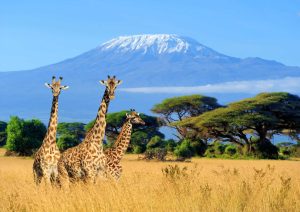
Kenia – Rundreisen
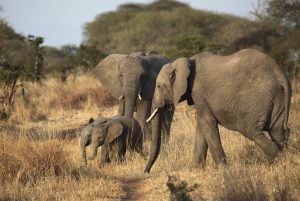
Tansania – Rundreisen
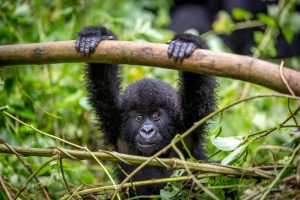
Uganda – Rundreisen
Das subtropische südafrika.
Sambia, Malawi, Mosambik , Simbabwe , Botswana , Namibia und Südafrika haben nur eine Trockenperiode welche von April bis durch den Oktober verläuft, sowie eine Regenzeit von November bis März. Allerdings variiert diese jedes Jahr in der Startzeit und an der Regenmenge, die fällt. Namibia beispielsweise ist bekannt als regenarmes Land, in dem höchstens an ein paar Tagen Regen fällt. Für eine Safari ist der namibische Winter zwischen den Monaten Mai bis September ideal. In Namibia können Sie sich den Etosha Nationalpark ansehen, der zu den schönsten Orten unserer Welt für Tierbeobachtungen gehört.
Die ganzjährigen Witterungsbedingungen sind jedoch beständiger als in Ostafrika. Die Orkanzeit im südlichen Indischen Ozean, betrifft vor allem Mauritius, Madagaskar , und die potenziellen Küstenregionen des nördlichen Südafrikas und Mosambik. Sie gilt von Januar bis März.
Die südliche Hälfte von Südafrika, und besonders die Kapregion, fallen in das Mediterrane Klima mit Regenfällen im Winter von April bis Oktober und trockenere Sommer von November bis März. Für eine Safari im wildreichen Krüger Nationalpark eignen sich am besten die Monate von November bis März, da die grüne Vegetation und die Aufzucht der jungen Tiere ein einmaliges Erlebnis sind. Besonders in Südafrika gibt es viele luxuriöse Lodges, die auch deutschsprachige Safaris anbieten.
Unsere Natur- und Erlebnisreisen im subtropischen Südafrika
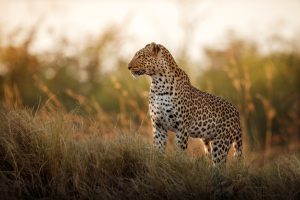
Sambia – Rundreisen
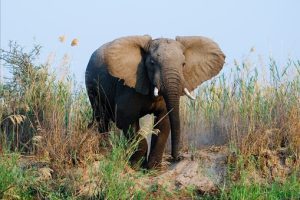
Malawi – Rundreisen
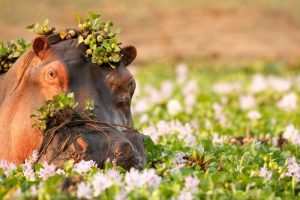
Simbabwe – Rundreisen
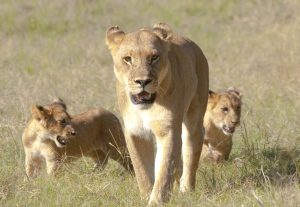
Botswana – Rundreisen
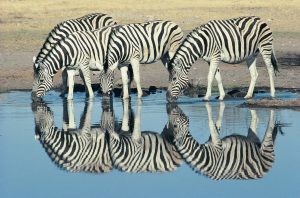
Namibia – Rundreisen
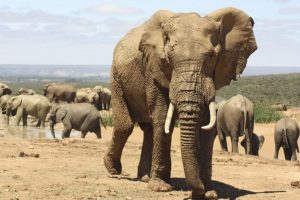
Südafrika – Rundreisen
Allgemeine bedingungen für safaris in afrika.
- Obwohl Afrika Safaris am besten in der Trockenzeit durchgeführt werden sollten, ist das nicht ausschließlich immer der Fall. In einigen Regionen ist es nicht möglich in der trockensten Zeit Safari Reisen zu machen, und sollten besser in der Green Season besucht werden, wenn das Land grün ist und ausreichend Wasserstellen verfügbar sind.
- Vogelbeobachtungen sind meistens besser während der Regenzeit, dann wenn die Brut-und Nistzeit startet und die Zugvögel meist überwintern.
- Die Temperaturen beeinflussen Safaris in Afrika nicht. Jedoch beeinflusst die Höhenlage die jeweiligen Min./Max- Temperaturen mehr als die Jahreszeit. Während im subtropischen Südafrika und am Kap, mehr die festgelegten Jahreszeiten Winter und Sommer die Temperaturen bestimmen.
- Einige Regionen und Nationalparks sind so bekannt für ihre Safaris, dass sogar in der wettertechnischen „falschen“ Zeit (z.B. während der Regensaison) die Safari Angebote immer noch attraktiv sind. Häufig werden zum Beispiel auch Gruppenreisen in Afrika zu unterschiedlichen Zeiten angeboten.
- Wenn es schwerer wird die Wetterbedingungen voraus zu sagen, und die Preise in der Hauptsaison nehmen vermehrt zu, werden die meisten Reisenden flexibler in der Planung ihrer Reisezeit und Reisedauer.
- Ganz abgesehen vom Preis, gibt es deutlich mehr Vorteile, für einen Afrika Urlaub in der Nebensaison.
Beste Reisezeiten für einen Safari Urlaub in Afrika
- Januar bis März: Trockenzeit, die Tiere sind einfach an den wenigen Wasserstellen zu finden
- Juli bis Oktober: Trockenzeit, Tierwanderungen durch das Maasai Mara Gebiet
- April, Mai und November: Zwischensaison, günstige Reisezeit
- Oktober bis November: Vogelbeobachtungen an den Seen Kenias
- Januar und Juni bis Oktober: Trockene Monate, wenig Pflanzenbestand, stark frequentierte Wasserstellen, besonders der Januar zählt zu den heißen Monaten
- Januar bis März und September bis Oktober: Beste Zeit, um den Mount Kilimanjaro zu besteigen
- November bis Mai: Zwischen Dezember und März ist Geburtensaison
- März: Sommerende, weniger Touristen befinden sich in den Safari Parks
- Mai bis August: Durch den nur geringen Pflanzenbewuchs eignet sich diese Zeit besonders für Safaris, warme Temperaturen und nur wenig Regen
- Mai bis November: Walbeobachtungen in den Küstengebieten
- Mai bis November: Trockenzeit, der Oktober ist der heißeste Monat
- September bis Oktober: Elefanten- und Büffelherden rotten sich im Chobe Nationalpark zusammen
- Dezember bis März: Regenzeit, wenige Besucher in den Nationalparks, Zwischensaison sind Dezember und März
- Mai bis September: Beste Zeit für Sossusvlei und Etosha Nationalpark , Temperaturen sind angenehm und die Tiere sind auf der Suche nach Wasserstellen
- Oktober bis März: Namib Naukluft Nationalpark, die Küstengebiete sind meist kühler als Innerlands gelegene Gebiete
- Oktober bis April: Vogelbeobachtungen im Etosha Nationalpark, Temperaturen können sehr heiß werden
- April bis Mai: Victoria Falls Ausflüge
- Juni bis Oktober: Trockenzeit
- Dezember bis April: Vogelbeobachtungen
- Juni bis September und Dezember bis Februar: Trockenzeit, tropisches Klima durch die ganzjährigen, leichten Regenfälle
- Januar bis März und September bis Oktober: Regenzeit, Moskitozeit, Gute Zeit für Fotografen und besonders klare Luft
Die schönste Orte für Safaris in Afrika
Was wäre eine Afrika Reise ohne eine Safari-Tour, um sich auf die Suche nach den bekannten Big 5 Afrikas zu machen? Viele Abenteurer kommen nach Afrika, um die beeindruckende afrikanische Tierwelt auf aufregenden Safaris mit eigenen Augen zu sehen. Um Ihnen die Qual der Wahl nach dem besten Reiseziel für Ihren Safari-Urlaub in Afrika zu erleichtern, geben wir Ihnen hier eine Übersicht der Top 5 Safari-Zielen in Afrika!
- Serengeti in Tansania
- Kruger Nationalpark in Südafrika
- Etosha Nationalpark in Namibia
- Okavango Delta in Botswana
- Masai Mara in Kenia
Ein Highlight auf Safaris in Afrika ist sicherlich, die Great Migration, wenn Millionen von Gnus und Zebras die Steppe Afrika auf der Suche nach Beute durchziehen.
Beste Reisemonate für eine Afrika Safari
Dezember/Januar bis März: Die Gnuwanderungen konzentrieren sich auf die Grasebenen der Serengeti in Tansania. Von Ende Januar bis Anfang Februar suchen die Tiere einen Platz um Jungtiere zu gebären. Um eine Safari durch Botswanas Kalahari und die Makgadikgadi Pfannen zu machen ist jetzt die beste Reisezeit. Brütende Schildkröten findet man nun an den Meeresufern des Indischen Ozeans. Südafrika eignet sich in dieser Zeit besonders gut für Vogelbeobachtungen.
April & Mai: Botswanas Okavango Delta wird in diesen Monaten überflutet. Die Victoria Falls erreichen nun auch ihre Hochwasserspitze. Besonders in Südafrika, Botswana und Simbabwe werden jetzt die besten Safari-Reisen angeboten. Auch die am Indischen Ozean gelegenen Länder Mosambik, Mauritius und die Seychellen kann man jetzt am besten bereisen.
Juni & Juli: Der Wasserstand im Okavango Delta hat nun seinen Höchststand erreicht. Die Wanderung der Gnuherden bewegt sich in die westliche Serengeti wohin es von dort aus weiter nach Kenia ins Maasai Mara Gebiet geht. Wale erobern die südliche Küste Südafrikas. Namibia, Sambia, Tansania und Kenia haben bieten nun Safaris an mit den besten Konditionen.
August bis Oktober: In den Monaten August bis Oktober startet die Hochsaison für Afrika Safaris. Die Wanderungen der Gnuherden verweilen im Maasai-Mara und in Tansanias Serengeti. An der Ostküste Afrikas kann man nun Buckelwale beobachten. Am südlichen Kap kann man jetzt besonders gut Meerestouren unternehmen.
September & Oktober: Die Schildkröten kommen nun an die Strände des südlichen Südafrikas um Eier zu legen und zu nisten. Europäische und Asiatische Zugvögel ziehen nun südwärts weiter durch Ostafrika hindurch bis nach Südafrika. In Botswanas Okavango Delta ist nun die aktive Zeit der Fischreiher erreicht. Auch im September und Oktober ist noch einmal mit die beste Reisezeit für Mosambik, Seychellen und Mauritius. Besonders geeignet wenn man eine Afrika Safari mit Badeurlaub plant.
November & Dezember: In den Küstengebieten Südafrikas kann man immer noch nistende Landschildkröten beobachten. An Malawis Nyika Plateau blüht nach dem Einsetzen des Regens die Orchidee. Die Gnuwanderung reist weiter in Richtung Süden durch die Serengeti. In Südafrika kann man jetzt besonders gut Vogelbeobachtungen durchführen
Wie Sie sehen, gibt es zu jeder Jahreszeit, die passenden Möglichkeiten für eine Safari in Afrika . Je nachdem zu welcher Zeit, Sie in welchem Land sind, werden Sie unterschiedliche Erlebnisse haben. Lassen Sie Ihren Traum wahr werden und wagen Sie das Abenteuer Afrika!
Warum wir Afrika lieben
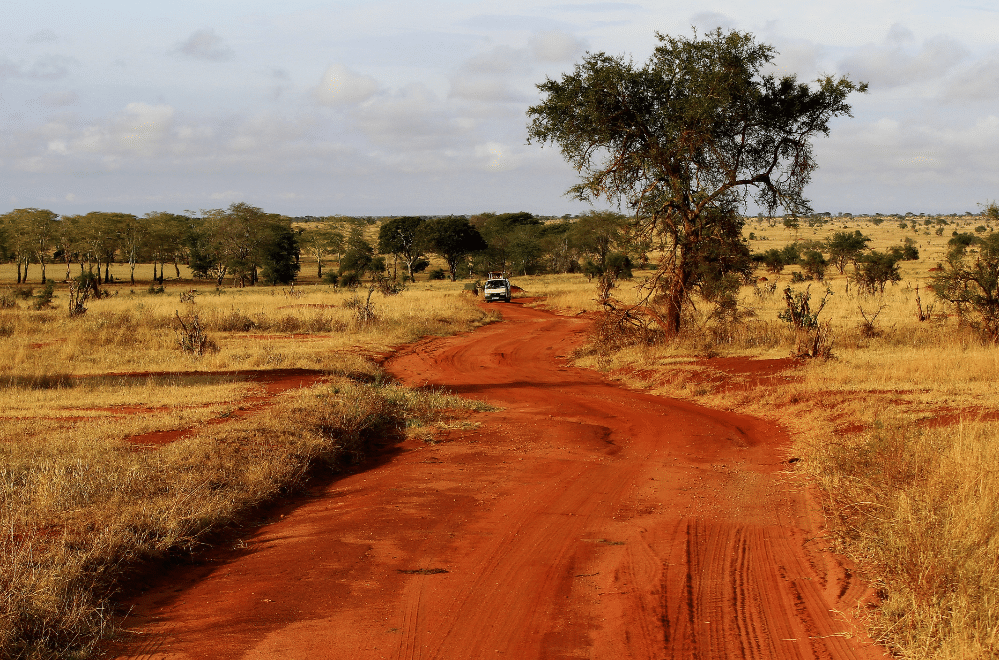
Tiere in natürlicher Umgebung
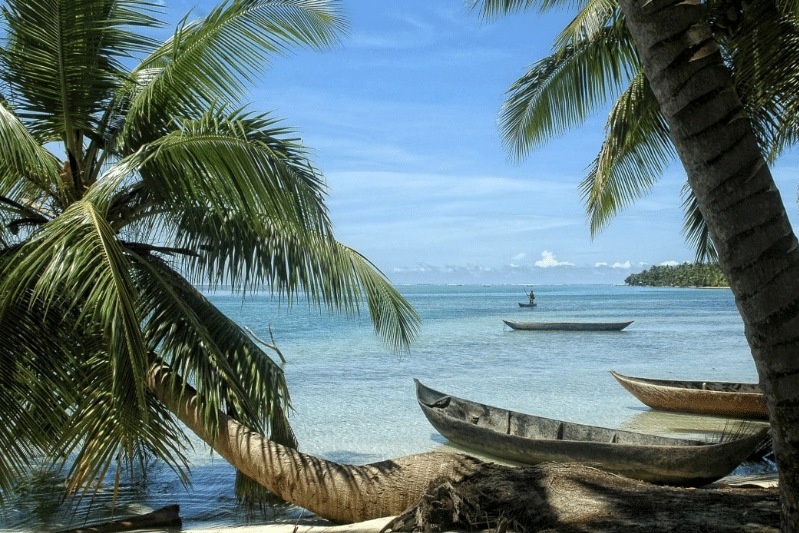
Rundreise mit Badeaufenthalt
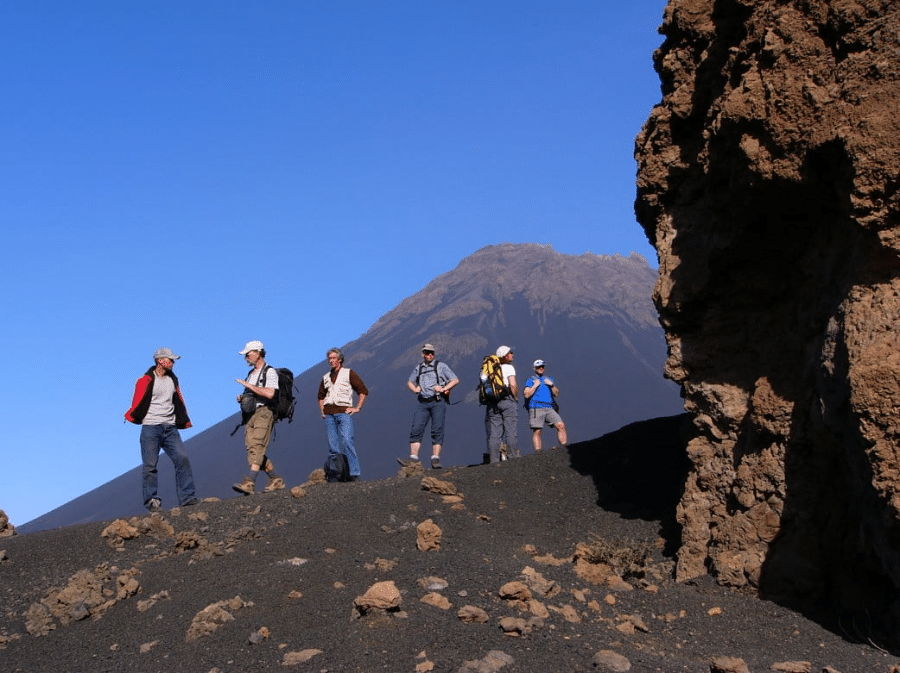
Afrikas Wanderparadise
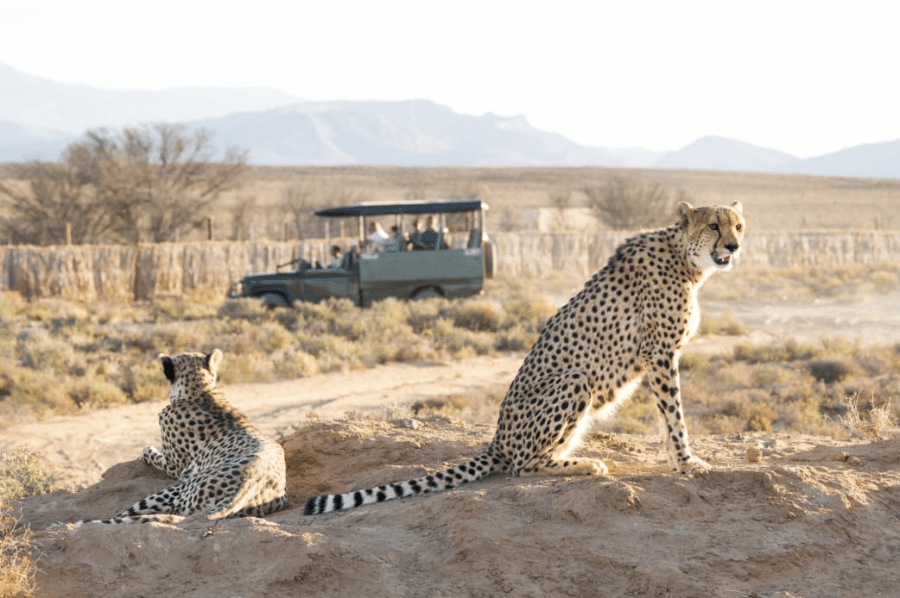
Spektakuläre Safaris
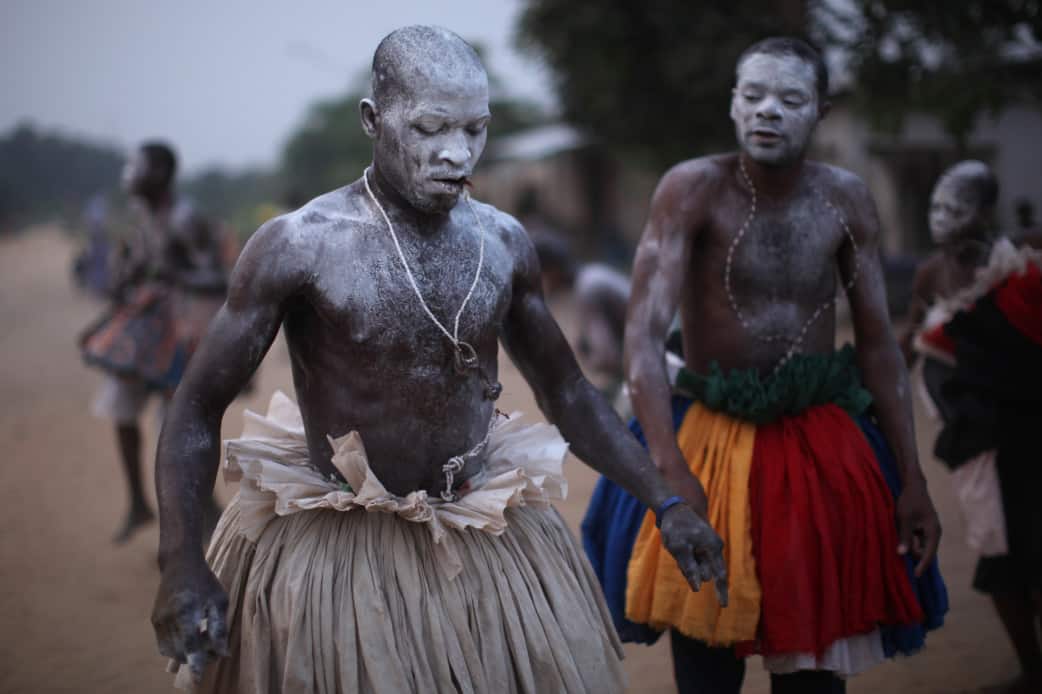
Kultur- und Begegnungsreisen
Natur hautnah erleben, das ist der Luxus unserer Reisen. In kleinen Gruppen von 4 bis maximal 12 Gästen oder individuell und ganz privat. Kommen Sie mit auf eine Reise durch das magische Afrika. Unsere Experten beraten Sie gerne persönlich.
Unsere Afrika Reisen
Ihr spezialist für natur- und erlebnisreisen.
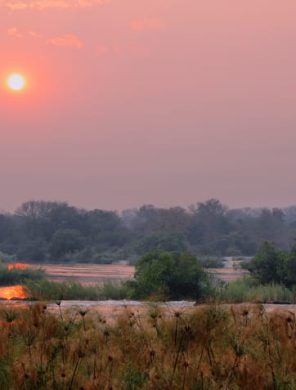
- Das Farbenspiel der Wüste erleben
- Spaziergänge auf Namibias höchsten Dünen
- Buntes Treiben am Wasserloch im Etosha Nationalpark
- Grünes Namibia, der Caprivi-Zipfel
- Ein Besuch bei den Mafwe, die Könige des Caprivi
- Bootssafari mit Hippos
- Die Victoria Fälle - ein einzigartiges Erlebnis
- Gruppenreise (12 max.)
- Flug inklusive
- Mittelklasse
- Weinprobe im Weingebiet am Kap
- 360° Aussichten auf Kapstadt – Gondelfahrt auf den Tafenberg
- Einsame Buchten in Plettenberg Bay auf der Garden Route
- Besuch einer Straußenfarm in Oudtshoorn
- Pirschfahrten im Dickhäuterparadies Addo Elephant Nationalpark
- BIG 5 Löwe, Leopard, Elefant, Büffel und Nashorn im Kariega Game Reserve
- Die schönsten Inseln intensiv bereisen
- Feuervulkan, lebendige Kultur, tropische Täler und Zeit am Meer
- Ausgesuchte moderate Wanderungen, mitreißende Musik und herzliche Menschen
- Landestypische Unterkünfte und gute 4-Sterne-Hotels
- Gruppenreise (14 max.)
- Ursprünglichkeit: Aufenthalte in vollkommen abgeschiedenen Landschaften und Naturparks Afrikas wie dem Lower Zambezi, South Luangwa und Liwonde Nationalpark. Besuch authentischer Dörfer, in denen das Leben läuft wie eh und je.
- Afrikanische Tierwelt: Am Malawi-See und entlang der Flussufer in Nationalparks treffen Sie auf Schreiseeadler, Flusspferde, Krokodile, Löwen – eine herrliche Vielfalt fast aller Arten afrikanischen Großwilds.
- Malawi-See und Flusswelten: Mumbo Island inmitten der endlosen Oberfläche des Malawisees mit türkisklarem Wasser. Wundervolle Tierbeobachtungen an den Ufern des Shire Flusses, des träge fließenden Luangwa Flusses und des gewaltigen Sambesi.
- Gruppenreise (9 max.)
- Fahrradtour zum Kratersee Tritriva eines erloschenen Vulkans
- Fahrt zu der berühmten Baobab Avenue, mit herrlichem Sonnenuntergang
- Wanderung im Isalo-Nationalpark mit seinen bizarren Gesteinsformationen
- Spektakuläre Zugfahrt über 163 km vom Hochplateau durch den Regenwald bis hinunter zum Indischen Ozean
- Individualreise
Neueste Beiträge
- Kulinarische Reise – Gerichte aus aller Welt
- Nationalgetränke rund um die Welt
- Unser Teamtag – ein Bericht
- Island im richtigen Licht: Wann die beste Reisezeit anbricht!
- Namibia vs Südafrika: Welches Reiseland passt zu Ihnen?
- Tierportrait Puma: Der Größte der Kleinkatzen
Natürlich.Reisen
- Unser Reiseblog
- Die Entstehungsgeschichte
- Warum beim Reiseveranstalter buchen
- Unser Reisemagazin
Unsere Destinationen
- Lateinamerika
Unsere Naturhelden Reisen
- Außergewöhnliche Naturreisen
- Hohe Beiträge für den Natur- und Artenschutz
- CO2 kompensiert
- Ganz nah rankommen
- Qualifizierte Reiseleitung & Expertengespräche
Jetzt Naturheld werden

TOP DESTINATIONS
- Kruger Park
- Okavango Delta
- Serengeti National Park
- Victoria Falls
TOP COUNTRIES
- South Africa
TRAVEL DEALS
View All Travel Deals
SOUTHERN AFRICA
East africa, indian ocean islands, top experiences.
- Beach Holidays
- Family Safaris
- Honeymoon Safaris
- Desert Safaris
- Luxury Rail Safaris
- Multi-Generational Safaris
- Positive Impact Safaris
- Photographic Safaris
- Walking Safaris
WILDLIFE SAFARI
- Big Five Safaris
- Birding Safaris
- Gorilla Trekking Safaris
- Migration Safaris
- Mobile Camping Safaris
- Horseback Safaris
FEATURED EXPERIENCES
Comfort levels, property types.
- Tented Camps
- Boutique Hotels
Featured Safari Collections
- Red Carnation
- The Safari Collection
- Elewana Collection
- African Anthology
GET TO KNOW US
- Meet The Team
- Pricing Explained
- Traveller Reviews
- Traveller Stories
- Why Book With Us?
- HerdTracker
- Safari Cost Calculator
- South Africa In 360
- Trusted Safari Partners
What are you looking for?
- Safaris & Tours
- Destinations
- Experiences
- Accommodations
- Why book with us?
Hello traveller!
It's in Cape Town now.
We're sorry. Our safari planners aren't available now. Our office hours are 08:00 - 19:00 (GMT+2).
Call us to speak to an experienced safari planner.
Alternatively, we recommend...
Schedule a phone or Zoom call with one of our safari planners
Complete our travel enquiry form to connect with a safari planner
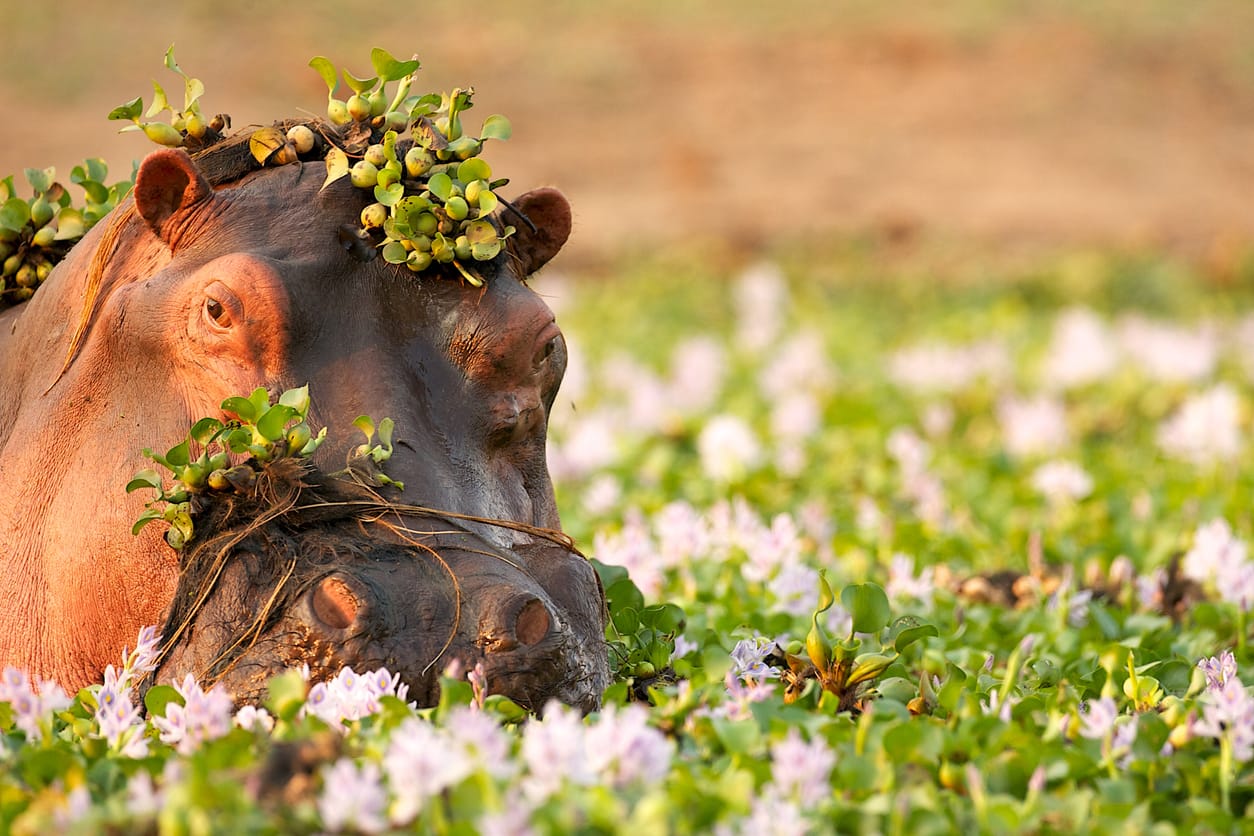
Best Time To Go On Safari In Africa (Calendar)

Author: Susan Swanepoel - 28 August 2023
Last Update: 30 January 2024
Part of the African Safari Collection
With the “best time for an African safari” being a common query, this article delves into the monthly breakdown of safari experiences across Africa , providing insights on what to expect from January to December.
Embarking on an African safari is a dream for many, offering a unique blend of adventure, natural beauty, and unforgettable wildlife encounters. However, the experience can vastly differ depending on the time of year you choose to visit.
Whether it’s witnessing the majestic wildebeest migration in Tanzania, partaking in thrilling gorilla trekking in Rwanda, or exploring the lush landscapes of South Africa, timing plays a pivotal role. This guide aims to equip you with the knowledge to choose the perfect time for your African safari adventure.
Safaris in January
January marks the onset of the ‘ Green Season ‘ across much of Africa, as the landscapes transform with the rains, rejuvenating the terrain and filling the once barren land with fresh grazing. As waterholes become ever-present, animals disperse far and wide, making the spectacle of wildlife movement a sight to behold.
However, for those with a keen interest in big game viewing, Tanzania and Kenya stand out as top choices for safari in January due to their prevailing dry conditions. Similarly, Rwanda, nestled in East Africa, offers excellent opportunities for gorilla trekking during its dry spell.
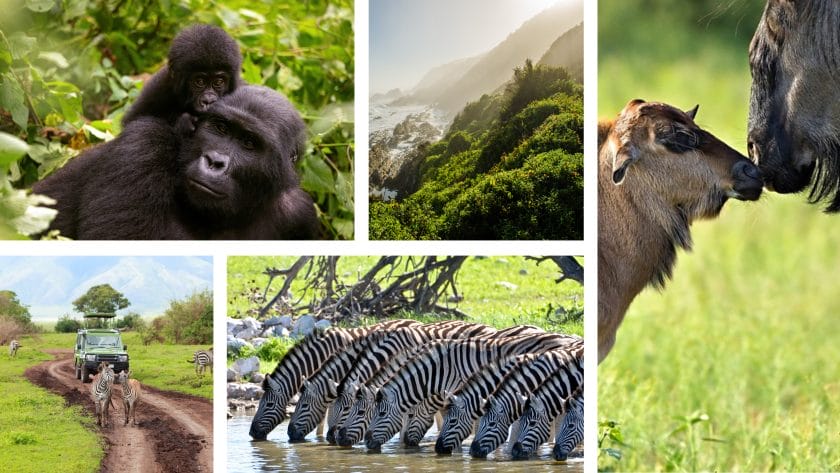
Despite being the rainy season in South Africa, destinations like the Cape and the Garden Route remain popular and delightful.
Moreover, January is a special month in Tanzania’s Southern Serengeti, with the wildebeest migration’s calving season in full swing, luring numerous predators, and offering breathtaking scenes of nature’s cycle.
Highlights on a safari in January
- Big game viewing in Tanzania and Kenya, still in their dry seasons.
- Gorilla trekking in Rwanda during its dry season.
- South Africa’s Cape and Garden Route are at their best, even in the rainy season.
- Lush vegetation, spectacular scenery, and fewer visitors in many safari countries.
- Wildebeest calving season in Southern Serengeti, Tanzania, attracting numerous predators.
- Zebra migration in Makgadikgadi Salt Pans, Botswana.
- Ideal gorilla trekking conditions in Uganda during its drier period in January to February.
Best destinations to visit in January
Book A Safari
Safaris in February
February is one of the best times for big game viewing in Africa, with Tanzania and Kenya offering exceptional safari tours as they escape the heavy rains. A dry spell brings prime gorilla trekking opportunities and abundant wildlife sightings, with adorable baby animals making their debut to steal your heart.
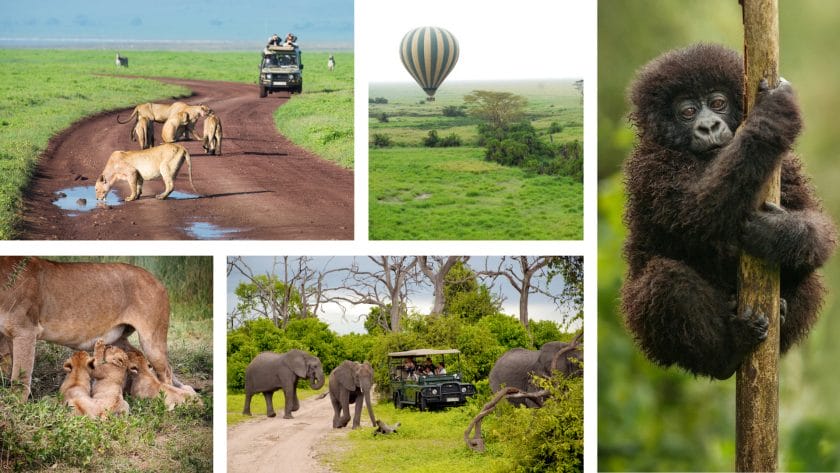
The Southern Serengeti comes alive with the wildebeest calving season , where massive herds gather and predators prowl, creating unforgettable wildlife encounters.
Highlights on a safari in February
- Exceptional big game viewing in Tanzania and Kenya, escaping the heavy rains of other regions.
- Thrilling predator action in the Southern Serengeti during the wildebeest calving season.
- Ideal gorilla trekking conditions in East Africa during a dry spell between the long and short rains.
- Botswana’s salt pans filling up and attracting an array of wildlife.
- Cuteness overload with the presence of numerous baby animals in various regions.
Best destinations to visit in February
Book Your Holiday
Safaris in March
March is an exciting time to visit Tanzania , with the Great Migration in full swing and a multitude of newborn wildebeest joining the herds. Witness the captivating spectacle of large wildebeest groups traversing northward from their breeding grounds in the Southern Serengeti, with adorable calves in tow.
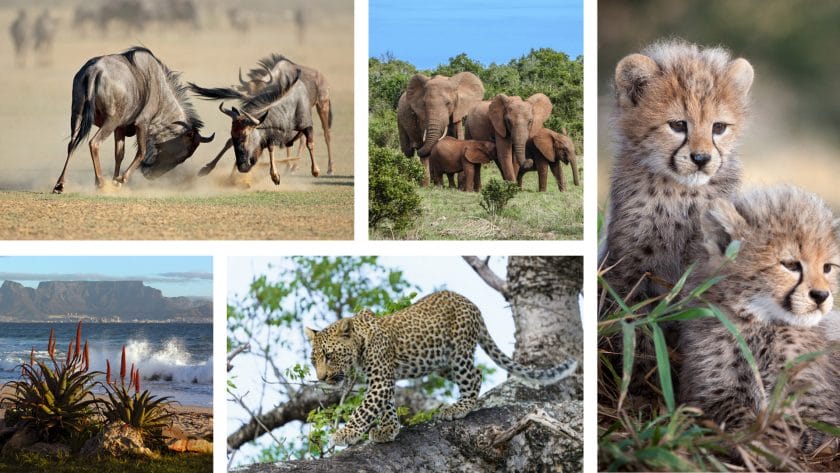
A South African safari is also a great choice this month, offering milder weather, fewer visitors, and excellent wildlife sightings in places like Sabi Sands Game Reserve.
Highlights on a safari in March
- The Great Migration in Tanzania, with huge herds of wildebeest on the move.
- Newborn wildebeest calves joining the migration in the Southern Serengeti.
- Excellent wildlife viewing in Sabi Sands Game Reserve, South Africa.
- Fewer visitors in South Africa, providing a more exclusive experience.
Best destinations to visit in March
Book a Holiday
Safaris in April
April brings an extraordinary transformation to Africa’s wilderness, with the Serengeti buzzing with the activity of the Great Migration and the southern landscapes bathed in the lushness of the rainy season.
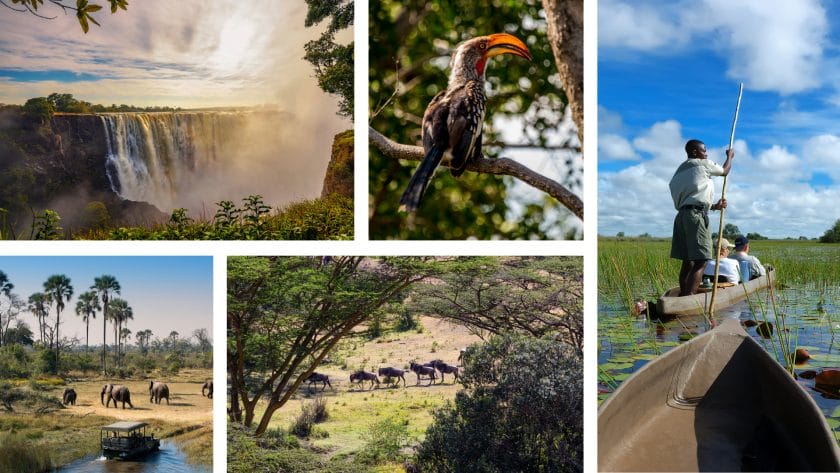
Botswana’s Okavango Delta transforms into a water paradise, offering unforgettable mokoro adventures and spectacular wildlife retreats on Chief’s Island. The awe-inspiring sight of Victoria Falls in peak flow is a must-see, a humbling experience that highlights the power and majesty of nature.
Highlights on a safari in April
- Witness the peak of the Great Migration’s activity in the Serengeti despite East Africa’s unpredictable weather.
- Southern Africa’s safari areas thrive after the passing of the rains, offering lush green landscapes and exceptional birding opportunities.
- Explore Botswana’s Okavango Delta as floodwaters arrive, providing unique dugout canoe experiences and rewarding walking safaris.
- Victoria Falls reaches its peak flow , offering a humbling and awe-inspiring sight.
- Enjoy walking safaris and game drives on Chief’s Island as wildlife retreats due to rising water levels in the Okavango Delta.
Best destinations to visit in April
Book an April Safari
Safaris in May
May emerges as a captivating month for safari enthusiasts, particularly in the realms of Botswana, Zambia, Zimbabwe, and the picturesque landscapes of Namibia . As East Africa, including Kenya, Uganda, Rwanda, and Tanzania, is engulfed by the climax of its heavy rains, the predictability of each day becomes an exciting gamble. Conversely, in southern Africa, the curtain falls on the green season, gradually thinning out the bush and drawing animals towards perennial water sources.
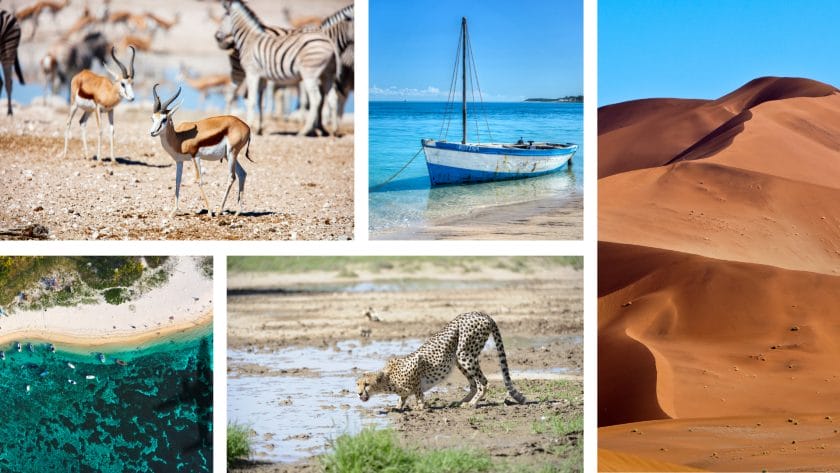
This shift to the dry winter season is complemented by mild weather, setting the stage for optimal wildlife viewing experiences. Furthermore, the allure of pristine beach holiday destinations such as Mauritius and Mozambique heightens, with dry days and cozy temperatures offering a serene backdrop. With the rains receding in East Africa, opportunistic travelers can seize low-season deals, making May a treasure trove of diverse experiences.
Highlights on a safari in May
- The end of the green season in southern Africa, leading to clearer views and animals congregating around permanent water sources.
- East Africa’s rainy crescendo: Kenya, Uganda, Rwanda, and Tanzania see their heaviest rainfall which presents a golden opportunity with low-season deals.
- Beach getaways beckon: Mauritius and Mozambique offer dry days with comfortable temperatures.
Best destinations to visit in May
Enquire Today
Safaris in June
June marks a pivotal moment in Africa’s safari calendar, transitioning from the rains into the iconic ‘dry season which is one of the best times to visit Africa. This shift drastically elevates game-viewing experiences across the continent. From the spectacular vistas of Tanzania’s Serengeti and Ngorongoro Crater to the mystique of gorilla trekking in Rwanda, East Africa paints a vivid canvas, albeit with a minor chance of rain. Meanwhile, southern Africa unfurls its splendor, with South Africa, Zambia, Botswana, and Zimbabwe showcasing prime safari encounters.
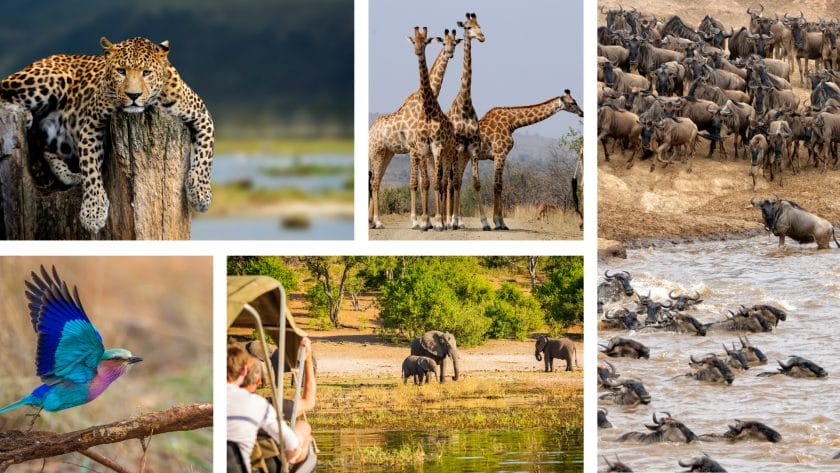
The subsequent dry months, spanning from June to September, become the apex for wildlife enthusiasts. During June and July, the Western Corridor of the Serengeti pulsates with the drama of the wildebeest migration , especially as these majestic herds attempt treacherous Grumeti River crossings.
Along South Africa’s eastern coastline, the marine world is in a frenzy with the awe-inspiring sardine run. This natural spectacle, featuring billions of migrating sardines pursued by an ensemble of sharks, dolphins, whales, and seabirds, is a visual feast for any visitor.
Highlights on a safari in June
- The transition from rainy to iconic ‘dry season’ across Africa.
- Exceptional game-viewing experiences in Tanzania’s Serengeti and Ngorongoro Crater .
- Mystical gorilla trekking opportunities in Rwanda.
- Prime safari encounters in southern Africa, notably in South Africa, Zambia, Botswana, and Zimbabwe.
- Perfect beach retreats with clear days in Mozambique.
- Dramatic wildebeest migration in the Western Corridor of the Serengeti, particularly the Grumeti River crossings in June and July.
- The unparalleled sardine run on South Africa’s east coast, with billions of sardines being trailed by sharks, dolphins, whales, and seabirds.
Best destinations to visit in June
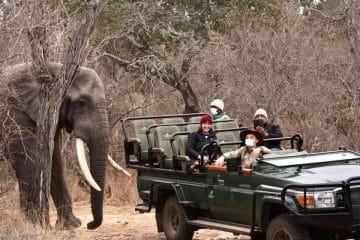
Greater Kruger Safari Short and Sweet
From $ 1360 /USD
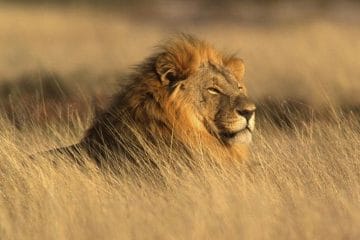
Sun City Adventure and Pilanesberg Safari
South Africa Johannesburg Sun City Pilanesberg
From $ 1490 /USD

Affordable Sabi Safari
Southern Africa South Africa Sabi Sands
Safaris in July
In July, the African landscape transforms as the dry season reaches its pinnacle, making it one of the most exceptional times to embark on a safari. Every park in each country showcases nature in its full splendor, making the decision on the best game destination quite challenging.
July heralds the peak season, with virtually all regions offering unparalleled safari experiences . Gorilla trekking in Rwanda becomes a treasured activity, with the conditions becoming ideal. Over in the Indian Ocean, the tranquil and warm waters of Mozambique beckon , although certain parts of Mauritius experience slightly gustier winds.
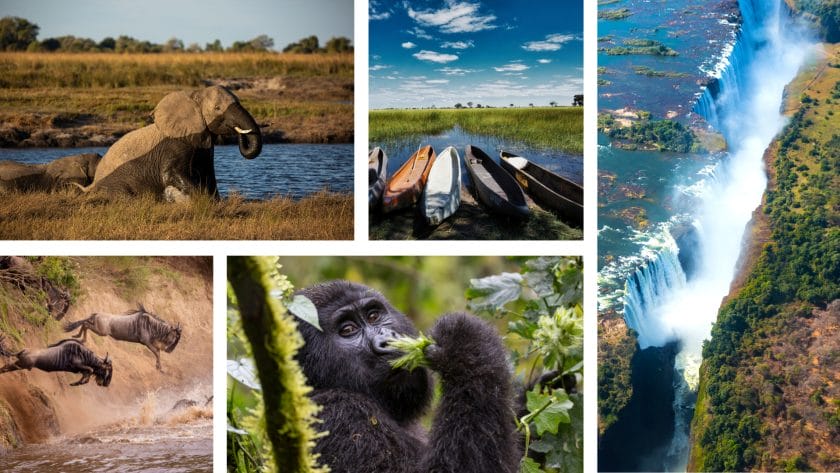
Uganda and Rwanda, although typically damp throughout the year, witness reduced rainfalls, further enhancing the gorilla trekking experience . However, South Africa’s winter chill sets in, making its sun-soaked beaches and attractions like Cape Town more suited for summer visits.
A standout during this month is the Okavango Delta in Botswana. Despite being the heart of the dry season, the delta boasts high water levels, ideal for dugout-canoe adventures. Victoria Falls presents itself in a photographer’s dream setting with moderate water volumes and minimal spray obstructions.
Highlights on a safari in July
- July is the optimal time for safaris across Africa, with every park in full swing.
- Ideal conditions in Rwanda make gorilla trekking a prime activity in July.
- The Indian Ocean boasts warm and calm waters in Mozambique
- The Okavango Delta in Botswana has high water levels in the dry season, perfect for dugout-canoe trips.
- Victoria Falls offers great photo opportunities with moderate water volumes
- Massive herds of elephants convene in Tanzania’s Tarangire National Park and around the Chobe River in Botswana.
Best destinations to visit in July
Book a Safari Experience
Safaris in August
August, sitting at the core of the dry season, is undeniably the pinnacle for African safaris, offering unparalleled experiences throughout Africa. As the Great Migration majestically progresses from the northern Serengeti into Kenya, it competes for the title of the continent’s most magnificent safari spectacle.
Meanwhile, the impeccable conditions in Rwanda pave the way for pristine gorilla trekking, with clear skies enhancing the experience. In the southern territories, notably in Botswana and Zambia , the safari offerings are world-class, becoming irresistibly enchanting in August.
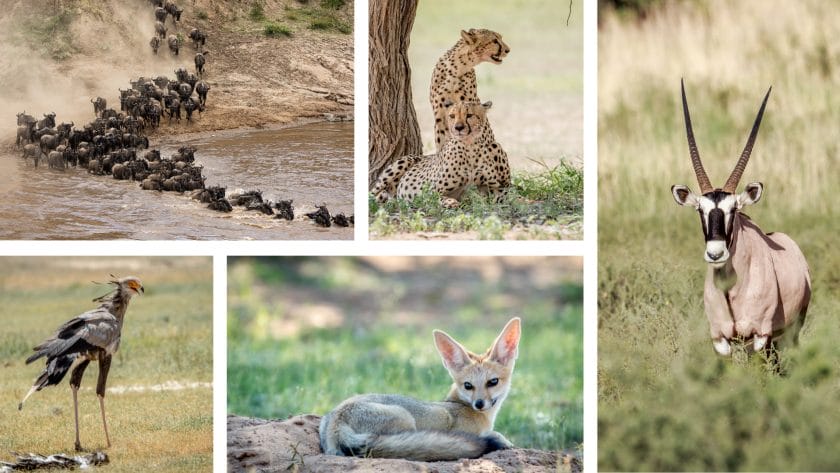
Zimbabwe’s Hwange National Park becomes a magnet for thousands of elephants, while the concluding phase of the Dry season transforms Mana Pools into an ideal backdrop for walking safaris. South Africa’s Namaqualand, typically a semi-desert, undergoes a breathtaking metamorphosis, blossoming into a vast expanse of vibrant flowers by the end of the season.
Highlights on a safari in August
- The Great Migration progresses from the northern Serengeti into Kenya, competing as the continent’s top safari spectacle.
- Rwanda offers pristine gorilla trekking conditions with clear skies.
- Southern territories, especially Botswana and Zambia, provide world-class safari experiences in August.
- Zimbabwe’s Hwange National Park attracts thousands of elephants.
- The end of the dry season in Mana Pools is perfect for walking safaris .
- South Africa’s Namaqualand transforms from a semi-desert into a vast expanse of vibrant flowers.
Best destinations to visit in August
Book your holiday
Safaris in September
September is an absolute safari treasure in Africa, with an abundance of wildlife and unforgettable experiences at every turn. Across the continent, the concentration of game is astonishing, making it challenging to choose a destination as virtually every park offers top-tier safari tours .
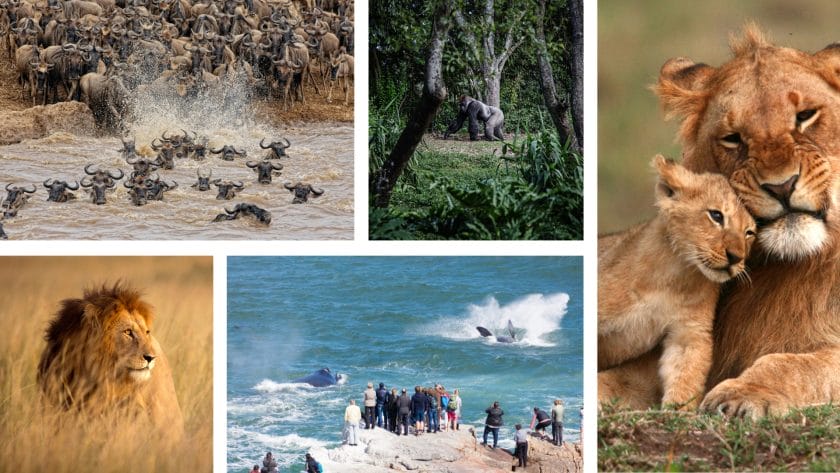
From the climax of the wildebeest migration with thrilling Mara River crossings in northern Tanzania and Kenya’s Masai Mara to the awe-inspiring sight of whales along South Africa’s southern coast, peaking in Hermanus during their annual whale festival.
Highlights on a safari in September
- Exceptional wildlife viewing across the continent due to high concentrations of game in many parks.
- Thrilling climax of the wildebeest migration, with epic river crossings in northern Tanzania and Kenya’s Masai Mara National Reserve.
- Experience the annual whale festival in Hermanus offering the best opportunities to see these majestic giants.
- Long dry season ending in Rwanda around mid-September, providing an optimal climate for various activities.
- Rising temperatures in the Indian Ocean as the region moves out of winter, making it a great time for beachside activities .
Best destinations to visit in September
Book a September Safari
Safaris in October
October in Africa is a thrilling time for safari enthusiasts, offering incredible wildlife encounters and picturesque landscapes. As animals search for water, witness magnificent elephant herds congregating along the Chobe River or a diverse array of species gathering at waterholes in Namibia’s Etosha National Park .
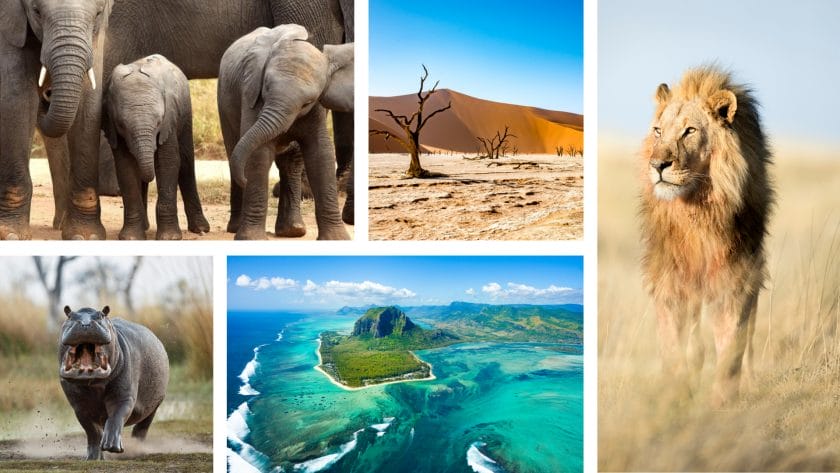
Despite the onset of the first rains, the majority of regions still provide excellent game-viewing opportunities, and the incoming showers are a refreshing respite from the soaring temperatures, enhancing the overall safari experience.
Highlights on a safari in October
- Exceptional wildlife viewing, with animals congregating at water sources.
- Massive elephant herds gathering along the Chobe River, offering incredible sightings.
- Diverse species sharing waterholes in Namibia’s Etosha National Park, creating unique photo opportunities.
- Thousands of hippos crowding the remaining river pools in Tanzania’s Katavi National Park .
- Continuation of the wildebeest migration across the Masai Mara National Reserve.
- The first rains of the season provide a refreshing break from the high temperatures of the dry season.
- Rising temperatures in Mozambique and Mauritius as these countries move towards their summer months.
Best destinations to visit in October
Book a Safari
Safaris in November
November is a hidden gem in the African safari calendar. Despite the onset of rains, savvy travelers can enjoy low visitor numbers, discounted rates at lodges, and vibrant landscapes that come alive with migratory birds in their resplendent breeding plumage.
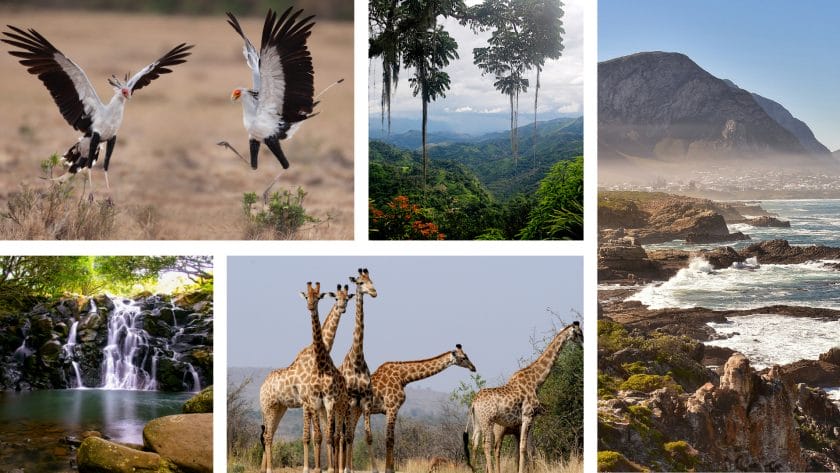
Furthermore, the summer months usher in the magical sight of sea turtles laying eggs on South Africa’s beaches, making it a truly special time to explore the continent’s natural wonders.
Highlights on a safari in November
- Low visitor numbers for a more exclusive safari experience.
- Discounted rates at lodges offer excellent value.
- Lush landscapes and the return of vibrant greenery.
- Fantastic birding with migratory species and birds in breeding plumage.
- Sea turtles laying eggs on South Africa’s sandy beaches.
- Start of summer in Mozambique and Mauritius with high temperatures and occasional afternoon thundershowers.
Best destinations to visit in November
Book a November Safari
Safaris in December
As the wet season begins in southern Africa, the landscape transforms into a verdant paradise, with waterholes replenishing and wildlife dispersing into smaller groups. Although many regions close for the season, South Africa offers enduring game-viewing experiences.
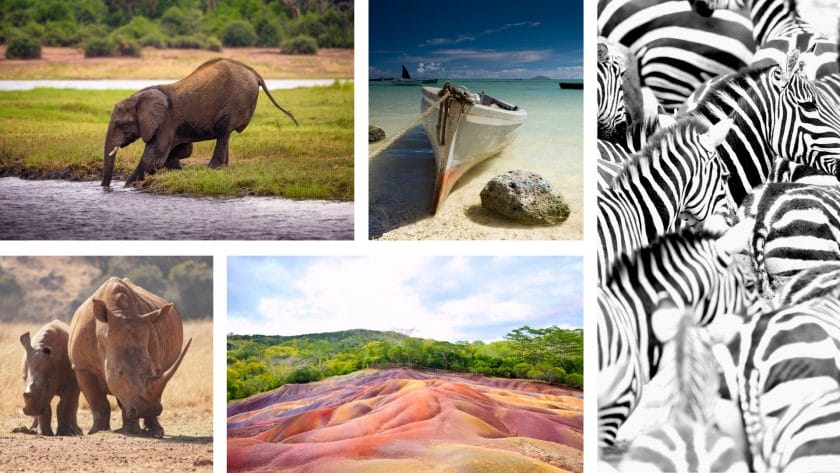
The most mesmerizing spectacle is Botswana’s ‘Emerald Season’ where rain beckons over 20,000 zebras to embark on Africa’s longest mammal migration from the Chobe River to Nxai Pan National Park – an unforgettable sight!
Highlights on a safari in December
- Discounted rates at safari lodges offer excellent value .
- Start of summer in Mozambique and Mauritius
Best destinations to visit in December
In conclusion, each month in Africa offers a distinct and magical safari experience, shaped by the seasonal dynamics of this diverse continent. From the vibrant greenery and abundant wildlife of the ‘Green Season’ to the dramatic wildlife encounters of the dry months, there’s no wrong time to embark on an African safari.
Whether you’re drawn by the allure of the Great Migration, the thrill of big game viewing, or the charm of quieter, less-traveled paths, Africa’s wilderness beckons with open arms. Remember, the best time for an African safari is not just about the weather or wildlife; it’s about what you seek from this once-in-a-lifetime journey. So, pick your month, book your safari, and prepare to be enchanted by the wonders of African Safaris.
6 of the Most Eco-Friendly Stays You Can Have in Namibia
The Rise of Women in Safari Guiding, Wildlife Protection, and Conservation
Why travel with us?
Recent reviews from travellers who planned and booked their africa trips with discover africa safaris.
South Africa, Botswana, & Zimbabwe Safari Review
Marcella, United States 16 Oct 2023
Amazing everything was just perfect, all our needs were met and everyone....
Letaka Miracle Rivers Mobile Safari & Chobe Game Lodge Review
Matt Campion, United Kingdom 15 Nov 2022
Luxury Botswana Safari Review
lori, United States 11 Jul 2022
It was clear that we were working with a tour operator who....
Southern Africa Safari Tours Review
Steve Gardner, United States 17 Mar 2019
Excellent company and staff..
A Safari in Africa Review
Terry Knott, United Kingdom 20 Jan 2017
Thank you for all your help discover africa safaris.
Safari tour through Africa’s highlights Review
Lisa and Niall Shapiro, Australia 01 Feb 2013
Registered Members of these Organizations
USEFUL LINKS
- Safari Tours
- Accommodation
- Why Book with us?
- Content Collaborations
- Safari Cost Estimator Tool
- Wildebeest Migration
- Privacy Policy
- Website Terms of Use
POPULAR COUNTRIES
- View All Countries
POPULAR DESTINATIONS
- View All Destinations
- Cape Town Holidays
- Kruger National Park
- Etosha National Park
- Chobe National Park
TRAVEL BLOGS
- Travel News Digest, 26 April:
- The Best of Kenyan Cuisine: 10 Dishes to Savour on your next Safari
- Norse Atlantic Adds New Direct Flight to Cape Town
- Travel News Digest, 19 April: SA Airports Celebrated, Rhino Poaching Concerns, Cape Town ‘Big Six’ Appeal
- FastJet Adds Surcharge to Vic Falls Route
OUR LOCATION
- 2nd floor, Tygervalley Chambers One, 27 Willie van Schoor Avenue, Bellville, Cape Town , 7530

Best Time to Visit Africa
Best time to visit africa (month by month and country by country) according to experts.
When is the best time to visit Africa month by month and country by country According to Experts? That depends on your itinerary, the season, and whether or not you plan to see the “big five” animals. The perfect African vacation can be planned with the help of this overview of Africa’s top tourist spots.
In the drier winter months of May–September, vegetation thins out and wildlife congregates around surviving water sources, making this the best to visit Africa. This is the optimum time to visit the massive southern wildlife reserves.
However, Africa is a great vacation spot any time of year because different parts of the continent enjoy distinctly different temperatures.
From November through April, you may enjoy lush foliage, excellent birdwatching , and typically lower rates. Even though it rains heavily in certain places, this is a great season to visit Victoria Falls , go scuba diving in Zanzibar, or go chimpanzee tracking in Rwanda.
Speak to an Africa specialist to start planning your tailor-made holiday…
Call one of our experts or arrange a video appointment for ideas and advice. Whether you’re full of ideas or unsure of where to start, we’re here to help. Serial safari-goer or first-time visitor, we’re ready to create your ultimate tailormade itinerary.
Enquire now and a Travel expert will get back to you within 2-4 hours.
A Month-by-month Guide – Best time to visit Africa
Visiting africa in january.
In the southeast of the Serengeti, the migrating herds give birth in January, making it a busy yet exciting time to visit. You can take advantage of over 450 different species of birds in the Caprivi Strip of Namibia. In Swakopmund, you might also observe thousands of flamingos congregating on lagoons. January in Zanzibar is ideal for scuba diving and snorkeling due to the clear, quiet waters.
Visiting Africa in February
Victoria Falls is at full force, with water crashing over the edge and into the gorge below, despite the fact that it is the rainy season in Zambia and Zimbabwe. Migratory birds are in plenty across the rest of Zambia right now. Meanwhile, this is a great time to visit Uganda and embark on a safari in search of chimpanzees and mountain gorillas.
Visiting Africa in March
Wet weather can make travel difficult in many parts of Africa during the month of March. Precipitation is expected soon in Tanzania, and the humidity levels are rising. It’s still a great time to see wildlife, as migratory birds arrive by the millions, and the camps are calm and have great deals.
Visiting Africa in April
Male antelope in Botswana and Malawi are displaying their dominance during the breeding season by strutting and butting heads with one another. The best time to see chimpanzees in Rwanda is in the late summer and early fall, when fruit is ripe and the primates descend to the lower branches to feed. Clear, calm water and excellent visibility make this a perfect time for scuba diving in Mozambique.
Visiting Africa in May
The dry season in Southern Africa begins in May. Grass is drying up, so herds are moving from pastures to wetland areas, making this a great time to visit. This makes their movements and the locations of the predators they attract more predictable. But the busiest times and highest prices are still a ways off. The weather in Mozambique is perfect for sightseeing right now, and the same goes for Egypt and Morocco.
Visiting Africa in June
It’s the middle of winter in Southern Africa, so the days will be warm and the nights will be cool. Game becomes more visible as the foliage dries up and water holes decrease in size in Botswana and Uganda. Meanwhile, the pumped waterholes of Hwange National Park in Zimbabwe and the Niassa Game Reserve in northern Mozambique attract a wide variety of animals that are perfect subjects for wildlife photographers.
Visiting Africa in July
As humpback whales make their annual migration along the coast, game in the game reserves congregates near waterholes, making for excellent whale and game watching. Elephants begin to congregate in Tarangire, Tanzania, and cruising is available on the Lower Zambezi in Zambia, while the Great Migration groups are typically found in the northern Serengeti as they head into Kenya.
Visiting Africa in August
Large herds of wildebeest and zebra are converging on the Masai Mara in Kenya as the Great Migration nears its peak. If you’re looking to combine a walking safari with a trip to Victoria Falls, look no further than Zambia. Lake Malawi, where the water is calm and the weather is warm, is another great destination right now.
Visiting Africa in September
Tarangire, in Tanzania, is known for its large annual elephant gatherings. Northern parks tend to be more crowded than their southern counterparts. Low humidity and comfortable temps make this a fantastic time to explore Namibia. Thousands of carmine bee-eaters migrate to Zambia’s riverbanks to nest, and Mozambique is a top destination for scuba divers and snorkelers.
Visiting Africa in October
The eland, the largest antelope in the world, often congregates in the hundreds for the breeding season in Malawi’s Nyika National Park. The end of the dry season is prime time for seeing animals in Mozambique. The fossa, a predatory creature like a cat, can be seen in the western deciduous woods of Madagascar at this time of year.
Visiting Africa in November
Since nightly rains reduce tourist numbers, now is an excellent time to take advantage of Tanzania’s off-season rates. From Kenya, migrating herds begin their journey south, and river crossings are common sights in the northern Serengeti. Despite the presence of both native and transient bird species, this is a peaceful time to go birdwatching in Zimbabwe’s parks.
Visiting Africa in December
Plan ahead to assure availability in Tanzania and South Africa throughout the holiday season. Short rains and the potential to witness baby animals and migratory bird species make December a wonderful time to visit Kenya. Crocodile eggs begin to hatch in Malawi, and new moms carry their babies in their mouths to the riverbank.
A handy Climate guide to Africa
The best time to visit Africa depends on the countries you want to visit, the time of the year, and if you are keen on going on one of the big five Africa safaris . Here is an overview of Africa destinations to help you plan the perfect African tours .
Best time to Visit Botswana
The dry months of June through October in Botswana are prime time for seeing wildlife. Temperatures in October can reach 40 degrees Celsius during the day, but can fall to below 10 degrees Celsius at night. April and May are also good times to go on safari in Botswana, however you should be prepared for some rain.
- Best time to visit : June to October
- Watch out : Nights can be cold and chilly during the peak season, especially in the drier areas
Best time to Visit Kenya
The months of June through October and the second half of December through March are ideal for visiting Kenya. In general, the country receives the heaviest deluge of precipitation between April and June, with lighter downpours in November and December. However, you can visit Kenya at any time of year because different regions of the country are accessible at different times.
- Best time to visit: July to October
- Watch out: Expect chilly weather conditions in higher altitudes
Best time to Visit Malawi
Summer, winter, and the rainy season each have their own unique climate in Malawi. Malawi has moderate temperatures from May to July, but hot weather in August and September. From the end of September through the beginning of April, Malawi’s roads are in bad condition due to heavy rainfall. With mild temperatures year-round, the best time to visit Malawi is from May through August or September.
- Best time to visit: June to August
- Watch out: Days are warm and cloudless but nights can be cold
Best time to Visit Mauritius
The climate in Mauritius is consistently warm and sunny throughout the year. Vacations on Mauritius’ beaches can be enjoyed at any time of the year, however January and February are more likely to see severe weather. Due to its position in the southern hemisphere, the country enjoys dry, relatively humidity-free weather from May through November.
- Best time to visit: September to January
- Watch out: The summer months typically get heavy rainfall with occasional thunderstorms
Best time to Visit Morocco
From October through February, the climate in Morocco is highly variable, with some years seeing mild winters and others experiencing wet and chilly ones. The months of April, May, October, and early November offer the most pleasant temperatures in Morocco.
- Best time to visit: September and October
- Watch out: October is a busy month for tourism so please confirm your travel plans much in advance
Best time to Visit Mozambique
The dry and wet seasons in Mozambique are just as diverse as they are anywhere else. April through September is the best season to visit Mozambique because of the dry weather. It can get very hot and humid during the rainy season if you venture inland or to the south.
- Best time to visit: June to October
- Watch out: Due to strong winds in August, visibility can be poor in some areas
Best time to Visit Namibia
Namibia enjoys 365 days of sunshine every year. Since Namibia is located in the southern hemisphere, the dry winter months may be rather chilly, with temperatures frequently falling below freezing. Safaris in Namibia are at their finest from June through October.
- Best time to visit: April to June
- Watch out: By the end of June, temperatures as well as the amount of greenery begin to decrease steadily
Best time to Visit Uganda
Although Uganda can be visited at any time of year, the dry seasons are typically preferred. Gorilla trekking is ideal throughout these months as well. Although the majority of Uganda experiences a tropical climate, local variations do exist; for example, the higher elevations of Mount Elgon and the Ruwenzori Range can experience temperatures well below freezing.
- Long wet season: April – June
- Short rainy season : October – December
- Drying time: June – October, December – March.
Best time to Visit Rwanda
Rwanda’s high altitude makes for a cooler climate despite the country’s close proximity to the Equator. The mountains are cooler, but it’s warm across the country. Daily highs in Rwanda average around 77 degrees Fahrenheit, making it a nice year-round destination. Depending on altitude, daytime highs can reach the 80s Fahrenheit and overnight lows can drop into the 60s. In the upper elevations, frost is to be expected. The climate in Rwanda is characterized by the following seasons:
- Long rains: March – May
- Long drying time: May – October
- Short rains : October – December
- Short drying time: December – March
Best time to Visit Seychelles
The winds that pass through Seychelles are mostly responsible for its weather. during October and March, the North-West trade winds provide hot and humid weather, while during January and February, the country receives a lot of rain. The best time to visit Seychelles is from May through October, when temperatures are mild and rainfall is minimal.
- Best time to visit: May to October
- Watch out: These are the busiest months for tourism in Seychelles
Best time to South Africa
Because of the wide range in local climates, the best time to visit South Africa is contextual. South Africa is located in the southern hemisphere, hence its seasons are the exact opposite of ours. Although August through October (Spring) is prime time for safaris in South Africa, the country is welcoming visitors at all times of the year. Mid-December through mid-January and Easter are peak travel times for domestic visitors, as they coincide with school breaks. As a result, major tourist hotspots in South Africa should be avoided for the time being.
- Best time to visit: May to October in the north and eastern parts; October to November and February to March in the Southern Cape region
- Watch out: Between May to August in the north and eastern parts, expect cool and dry weather with temperatures dipping below -12°C at night.
Best time to Visit Tanzania
Tanzania is a fantastic travel destination any time of the year, so before you book your trip, think about what you hope to get out of your time there. April and May are the worst months to visit Tanzania because of the heavy rainfall.
- Best time to visit: July to October
- Watch out: It can get quite cold in the higher altitudes
Best time to Visit Zambia
May through August, when temperatures are mild and rainfall is minimal, are the ideal months to visit Zambia. It’s the best time of year to watch sports because the weather is moderate. Temperatures in Zambia can reach 40 degrees Celsius during the hot and dry season; nonetheless, this is the best time of year to go on safari. The wet season may be inconvenient for travel, but it’s prime time for spotting migratory birds in their natural habitats.
- Best time to visit : June to August
- Watch out: While the days are warm and cloudless, nights can be chilly!
Best time to Visit Zimbabwe
Between May through August, when temperatures are mild and rainfall is minimal, is the ideal season to visit Zimbabwe. The daytime highs average approximately 20 degrees Celsius, while the nighttime lows are typically in the teens. Temperatures can plummet to near freezing in Zimbabwe’s mountainous regions. It is also peak safari season in Zimbabwe during these months.
- Best time to visit: June to August
- Watch out: Pack warm winter clothes for morning game drives since temperatures can dip as low as 6°C
Best Time to Visit the Victoria Falls
From February to May, right after the summer rains, is when the world’s largest sheet of falling water, Victoria Falls, is at its most impressive. The spray from Victoria Falls is spectacular, but the best time to see it is not when safaris are most popular in adjacent Chobe, Botswana , or Hwange, Zimbabwe . When the water is at its highest and fastest, it is also too risky to attempt activities like swimming in Devil’s Pool or certain portions of white-water rapids.
Best Time For An African Safari
From September to December, the continent-wide dry and warm weather is perfect for safari tours in the southwest, Cape area tourism, and experiences in East Africa .
This is also prime season for seeing wildlife in the vast stretches of wilderness that reach from west to east. These months are ideal for wildlife photography in Southern Africa since they coincide with the time when the continent’s grand animal migrations take place.
In the national parks of Southern Africa , you have a good chance of seeing newborn animals. Traveling to Africa between September and December is an excellent time to see a wide variety of animals and people.
Speak to a certified Africa specialist to start planning your tailor-made vacation…
Call one of our experts or arrange a video appointment for ideas and advice.
Beste Reisezeit Südafrika 2024
Wann ist die beste reisezeit für südafrika.
Jetzt Südafrika buchen
Aufgrund der Lage auf der Südhalbkugel verlaufen die Jahreszeiten in Südafrika unseren in Deutschland entgegengesetzt. Das heißt, wenn in Deutschland der Winter einbricht, fängt der südafrikanische Sommer an. Ist bei uns der Sommer angekommen, setzt der Winter in Südafrika ein. Auch die Jahreszeiten Frühling und Herbst verlaufen gegensätzlich. Da stellt sich die Frage, wann die beste Reisezeit für Südafrika ist. Aufgrund der verschiedenen klimatischen Bedingungen gibt es darauf keine eindeutige Antwort. Die optimale Reisezeit hängt davon ab, welche Region ihr in Südafrika bereisen wollt, was ihr sehen und erleben möchtet und welche Art von Urlaub ihr genießen wollt. Viele entscheiden sich für eine Südafrika Reise während der Hochsaison . Sie herrscht im südafrikanischen Sommer in den Monaten Dezember und Januar .
In dieser Zeit entfliehen viele Deutsche dem kalten Winter und reisen in den afrikanischen Staat. Die Landschaft zeigt sich in seiner vollen Pracht, die Temperaturen sind hochsommerlich und Niederschläge selten. Aus diesem Grund wimmelt es in diesen Monaten von Touristen. Hinzu kommt, dass die Einheimischen Ferien haben. Die Sehenswürdigkeiten und Strände sind bei Touristen und Einheimischen gleichermaßen beliebt. Ein weiteres Merkmal sind die erhöhten Preise in der Hochsaison. Zudem können die Hotels und Ausflüge schnell ausgebucht sein. Wer der großen Ansammlung von Menschen in seinem Afrika Urlaub entgehen will, kann auf alle anderen Jahreszeiten ausweichen. Es gilt: Eine Reise nach Südafrika lohnt sich das ganze Jahr über. Dennoch solltet ihr abhängig von geplanten Aktivitäten und Regionen einige Monate bevorzugen oder außer Acht lassen.
Weitere Infos – Übersicht
- Wie ist das Klima in Südafrika?
Beste Reisezeit für Kapstadt
- Beste Reisezeit für Safaris
Beste Reisezeit für die Garden Route
- Mein Fazit zur optimalen Reisezeit für Südafrika
Weitere Informationen zu Südafrika
Die besten reisezeiten für weitere reiseziele, klima in südafrika.
An der Südspitze des afrikanischen Kontinents liegt die Republik Südafrika . Das beliebte Reiseziel weist nicht nur eine landschaftliche Vielfältigkeit auf, sondern auch viele verschiedene Klimazonen . Vom Wüstenklima, über subtropische Klimabedingungen, bis zu mediterranem Klima gibt es alles in Südafrika. Großen Einfluss auf das Klima in den verschiedenen Regionen Südafrikas haben die Höhen- und die Meereslagen. Die Westküste und damit die Region um Kapstadt weist mediterranes Klima auf. Im südafrikanischen Sommer herrscht warmes und trockenes Wetter. Die Winter sind aufgrund des Benguelastroms vergleichsweise kühl und feucht. In der Region um Kapstadt fällt der meiste Regen in den Monaten Juni bis September des südafrikanischen Winters. An der Ostküste, wo auch Durban liegt, sorgt der Agulhasstrom für feuchtes und warmes Wetter. Der Strom aus dem Indischen Ozean lässt die Niederschlagsmenge in der östlichen Küstenzone steigen. Das Landesinnere mit Johannesburg ist spürbar trockener. Hier regnet es in der Regel im südafrikanischen Sommer am häufigsten. Die Sommermonate sind heiß und in den Wintermonaten herrschen milde Temperaturen. In den höheren Lagen des Landes sind die Nächte in dieser Jahreszeit kalt und Frost kann aufkommen. Ihr seht, das Klima in Südafrika unterscheidet sich abhängig von der Region.
Alle Südafrika Rundreisen
Cape Town , englisch für Kapstadt, befindet sich an der südwestlichen Küste von Südafrika. Die südafrikanische Metropole ist ein beliebtes Urlaubsziel bei Touristen. Als beste Reisezeit für Kapstadt gelten insbesondere die Monate Dezember, Januar und Februar. Diese Monate stehen für den südafrikanischen Sommer. Heiße Temperaturen, dazu eine geringe Luftfeuchtigkeit – euch erwartet ein perfekter Sommerurlaub. Andere bevorzugen die Monate Oktober , November , März und April als beste Reisezeit für einen Kapstadt Urlaub . Zu diesen Zeiten herrschen der südafrikanische Frühling und Herbst mit angenehmem Klima. Die Temperaturen sind nicht zu heiß und ideal, um Kapstadt und die umliegende Kapregion zu erkunden. Im Frühling blüht an der Küste alles in seiner vollen Pracht. Im Oktober und November kann der Wind heftiger sein als in den anderen Monaten.
Das tut einer traumhaften Reise aber keinen Abbruch. Im Winter, der von Juni bis September herrscht, kann es in Kapstadt und in der Kapregion extrem frisch und nass werden. Haltet ihr euch an die Monate September, Oktober, November oder auch Dezember als beste Reisezeit für Kapstadt, macht ihr alles richtig. In einem ausführlichen Artikel bekommt ihr detaillierte Infos zur besten Reisezeit für Kapstadt .
Klimatabelle Südafrika – Kapstadt
Beste reisezeit für safaris in südafrika.
Südafrika ist vor allem für atemberaubende Landschaften und die Big Five bekannt. Wer in Südafrika ist, darf sich eine Safari, beispielsweise im Krüger Nationalpark im Nordosten des Landes, nicht entgehen lassen. Beobachtet Löwen, Elefanten, Nashörner, Büffel, Leoparden und viele weitere wilde Tiere in ihrem Lebensraum. Als beste Reisezeit für eine Südafrika Safari gelten die südafrikanischen Wintermonate Juni , Juli , August , September und Oktober . Der Grund: Die Wildreservate und Nationalparks sind niedrig bewachsen und die Tiere lassen sich dadurch besser beobachten. Zudem sorgt die Trockenzeit dafür, dass die Tiere zu den Wasserstellen ziehen. Des Weiteren sind die Temperaturen nicht zu heiß wie in den südafrikanischen Sommermonaten. Der Nachteil an dieser Reisezeit sind die kalten Nächte. Bei Touristen sind die sogenannten Morning Drives und Night Drives beliebt.
Bei diesen Safaris seid ihr in der Nacht oder in den frühen Morgenstunden unterwegs, in denen es extrem frisch sein kann. Packt dafür auf jeden Fall einen dicken Pulli oder eine dickere Jacke ein. Da der südafrikanische Winter als beste Reisezeit für Safaris in Südafrika beispielsweise im weltbekannten Krüger Nationalpark gilt, solltet ihr euch früh für eine Tour entscheiden. Sonst sind sie ausgebucht. Aber auch für Safaris gilt: Ihr habt das ganze Jahr über die Chance, die wilden Tiere Südafrikas auf einer Tour zu beobachten – sogar in der Hochsaison bei heißen Temperaturen um die 35 Grad Celsius! Aus diesem Grund muss jeder für sich selbst die beste Reisezeit für eine Safari definieren.
Klimatabelle Krüger Nationalpark
Die Garden Route ist eine der beliebtesten Strecken für eine Reise mit einem Mietwagen. Ähnlich wie in der Kapregion und in Kapstadt herrscht maritimes Klima in dieser Küstenregion im Süden. Im Sommer könnt ihr euch auf traumhafte Temperaturen freuen und die Wintermonate sind mild. Starke Winde, die in Kapstadt herrschen, gibt es an der Garden Route selten. Allerdings regnet es hier in den Wintermonaten häufig und viel. Wollt ihr die Garden Route in ihrer vollen Schönheit erkunden, solltet ihr den südafrikanischen Frühling oder Sommer in Betracht ziehen. Als beste Reisezeit für die Garden Route gelten die Monate Oktober , November , Dezember , Januar , Februar , März und April . Im Sommer kann es extrem heiß werden. Perfekt, um in einer geschützten Bucht schwimmen zu gehen. Alternativ könnt ihr euch bei gelegentlichen Regenschauern abkühlen.
Beachtet, dass auf der Garden Route im Dezember und Januar viel los ist, da Hochsaison und Ferienzeit herrschen.
Klimatabelle für George (größte Stadt an der Garden Route)
Mein fazit zur besten reisezeit für südafrika.
Wie ihr an den unterschiedlichen klimatischen Bedingungen und Wetterverhältnissen in den verschiedenen Regionen sehen könnt, gibt es nicht die optimale Reisezeit für Südafrika . Um dennoch die individuell beste Reisezeit für sich selber zu finden, macht euch vorher einen Plan, was ihr in Südafrika sehen wollt. Daraufhin fällt die Entscheidung für die Reisezeit. Für eine Safari im Krüger Nationalpark beispielsweise eigenen sich die Monate Juni bis Oktober. Für eine Reise nach Kapstadt solltet ihr euch die Monate September bis November aussuchen. Für die beliebte Garden Route eignen sich die Monate Oktober bis April. Plant ihr die entsprechenden Trips in anderen Monaten als empfohlen, müsst ihr keine Angst vor schlechten Wetterverhältnissen haben. Südafrika ist insgesamt ein ganzjähriges Reiseziel !
Neugierig geworden?
Jetzt Südafrika Rundreise buchen
Top 8 Kapstadt Geheimtipps
Ein Traum zwischen Atlantik und Tafelberg
Die Garden Route
Südafrikas beliebteste Route entlang der Südküste
Johannesburg Tipps
Was kann man in der südafrikanischen Stadt erleben?

Beste Reisezeit Namibia 2024
Findet informationen zum klima und wetter in namibia und erfahrt, wann die beste reisezeit für euren namibia urlaub ist..

Beste Reisezeit Tansania 2024
Erfahrt hier, wann die beste tansania reisezeit für einen strandurlaub, für safaris und für trekking-touren ist..

Beste Reisezeit Kenia 2024
Anhand von klimatabellen zeigen wir euch wann die beste reisezeit für einen urlaub im hochland und an der küste kenias ist..

Was sagst du dazu? Antwort verwerfen
Meinen Namen, E-Mail und Website in diesem Browser speichern, bis ich wieder kommentiere.
This is the best time to take an African safari

Lions and elephants and cheetahs, oh my! For nature lovers, an African safari is the ultimate immersive getaway. Safaris offer a combination of wildlife encounters and luxurious lodges, incredible thrills and peaceful, unplugged wilderness.
Although traveling to the African bush is a great experience any time of year, there are definitely more advantageous times for wildlife spotting. For example, in East Africa, you may want to time a trip to coincide with the great wildebeest and zebra migration. In Southern Africa, a trip at the same time most babies are born offers some incredibly special moments watching newborns with their mamas.
I've visited Africa more than a dozen times and have gone on safaris in six different countries, visiting every season.
While I've seen incredible wildlife — including lion cubs on a December trip to Botswana and spectacular herds of elephants in Zimbabwe on a May safari — in the nonhigh seasons, I've also dealt with some pretty extreme weather as well. For instance, I have experienced intense rain storms in November and freezing temperatures in June.
Sometimes the best time to take a safari is when you have flexibility in your schedule or can get the best rates. However, if you want to plan around the absolute best time to spot wildlife, read below to find out when to go.
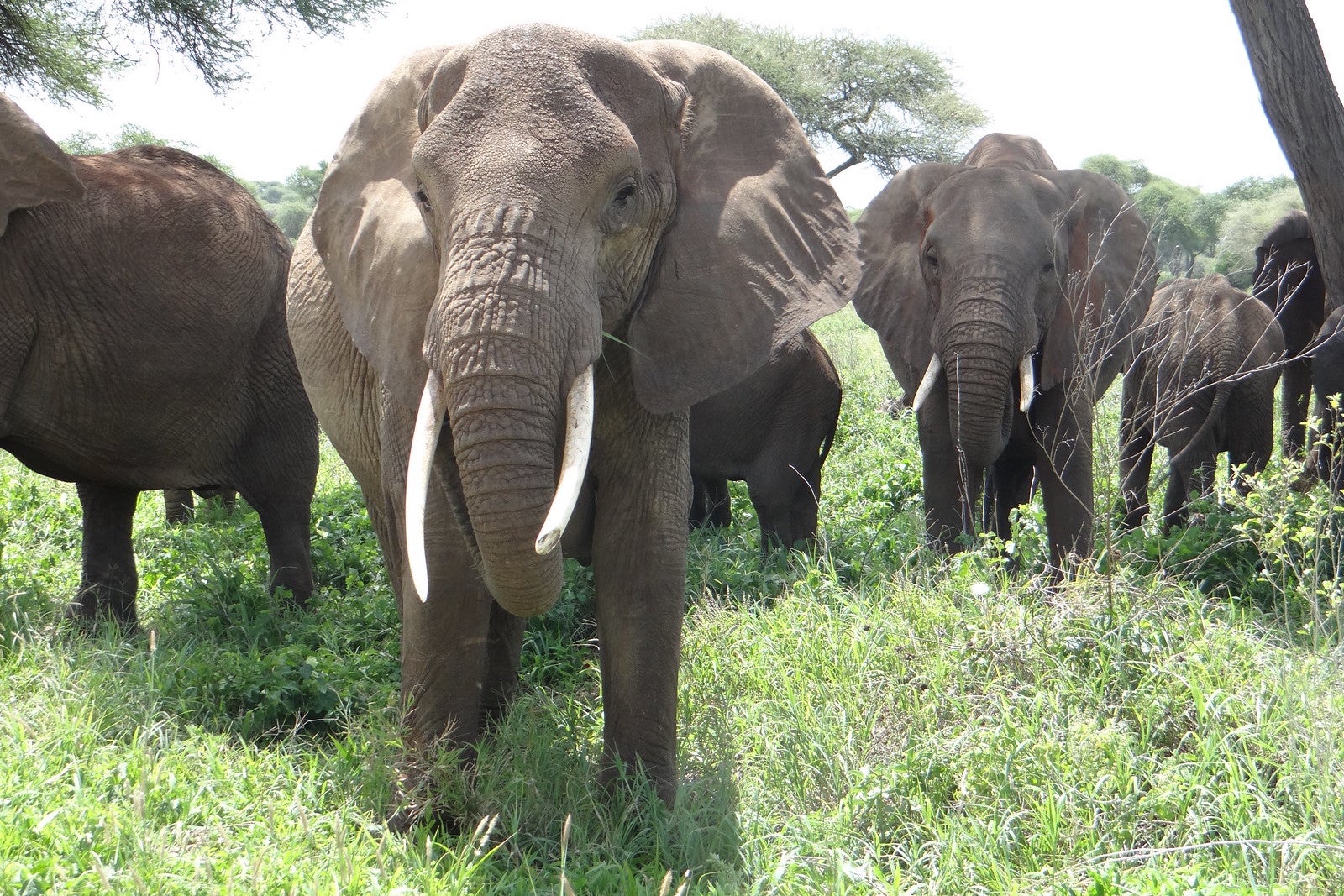
What months are best to go on an African safari?
The African continent is massive, comprising 54 unique nations and nearly 2,000 languages. Most safaris take place in two main savanna regions of the African continent: Southern and East Africa. The Southern Africa region includes South Africa , Botswana, Namibia, Zambia and Zimbabwe. East Africa contains the safari destinations of Kenya , Tanzania, Rwanda and Uganda.
Most of these destinations have one thing in common: They're located in the Southern Hemisphere. Even the ones that straddle the equator, such as Uganda, follow the Southern Hemisphere's weather patterns.
This means the seasons on safari will be the opposite of what you're most likely used to at home. Summer is December through February, winter is June through August, spring is September to November and autumn is March through May.
The Southern Hemisphere's winter and early spring — roughly June through October — is usually considered safari high season because it's the driest time of year. Wildlife gathers around watering holes when water is scarce elsewhere, Mark Nolting of Africa Adventure Company says; this makes it easier to see many species in one location.
In East Africa, the best time to go on an African safari is during the great migration, when thousands of antelope and zebra move in massive herds to find water. That season is roughly December to March and then again from June to mid-November.
There are some exceptions to this rule though.
In Botswana seeing wildlife from a mokoro, a type of dugout canoe, is a popular activity. That's why it's necessary to visit when there's water in the passageways. The dry season provides the same viewing opportunities as above, so you should be able to spot game anytime.
The private reserves in South Africa also defy seasonality; game is so dense in areas, such as the Sabi Sand Private Game Reserve, that you should be able to spot wildlife no matter the month or season.
Related: Up close and animal: Why walking safaris are so worthwhile
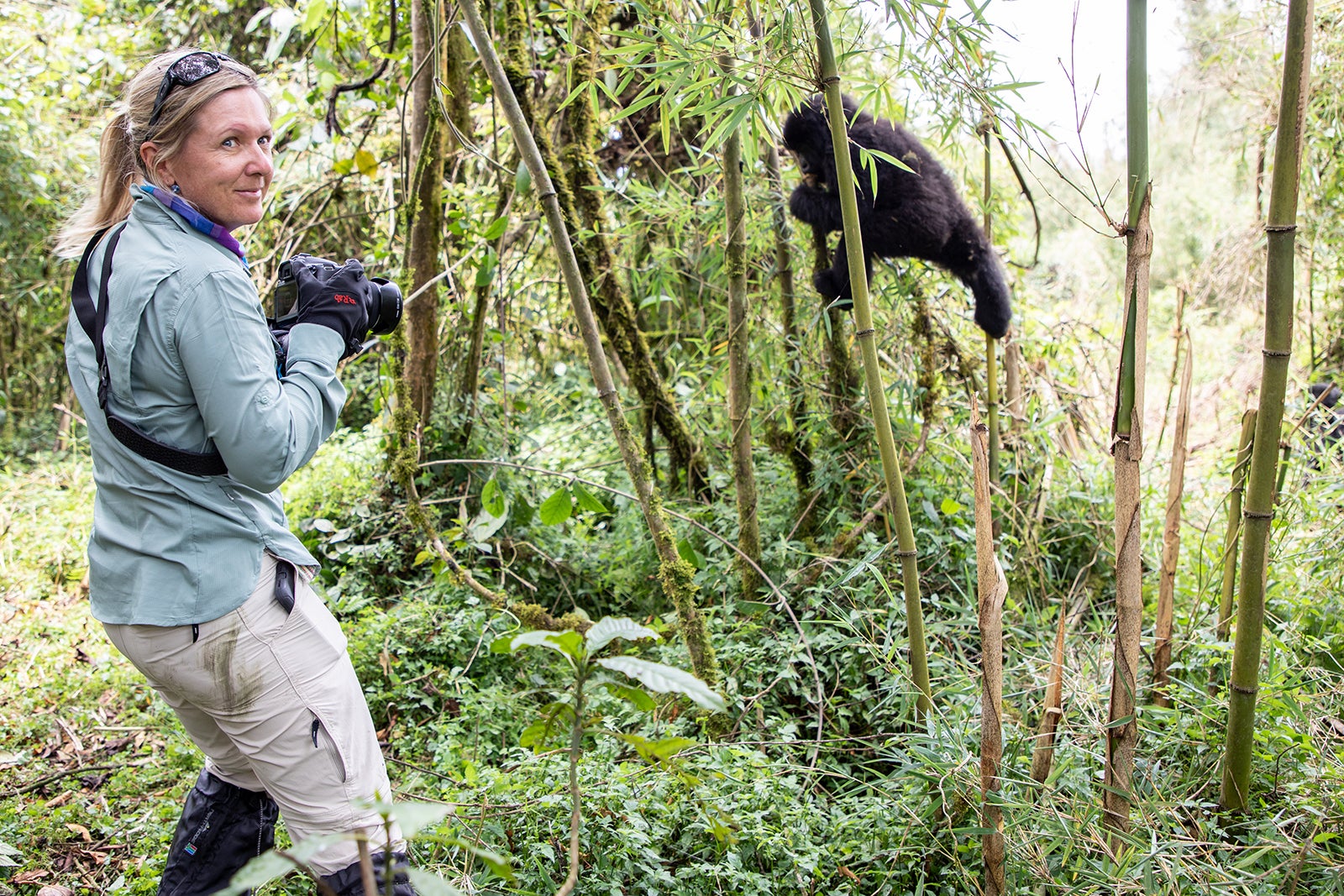
When is the best weather for a safari?
The dry weather of the winter season, roughly June through September, is often considered the best weather for a safari. Note: It can be quite cold after the sun sets, so bring a hat, fleece and gloves to keep warm during early morning game drives (though most safari lodges will provide blankets and hot beverages, too).
The "green season," as the rainier summer months are often called, is usually also the hottest time of year. At this time, you'll encounter the most insects, including mosquitos, in the bush.
Shoulder season — the times between the high season and green season, March to May and October to December — usually offers moderate temperatures and just an occasional storm. This time can be a great option for travelers since this is when you can get better pricing while still enjoying prime wildlife viewing.
Related: Luxury African safaris that support local communities
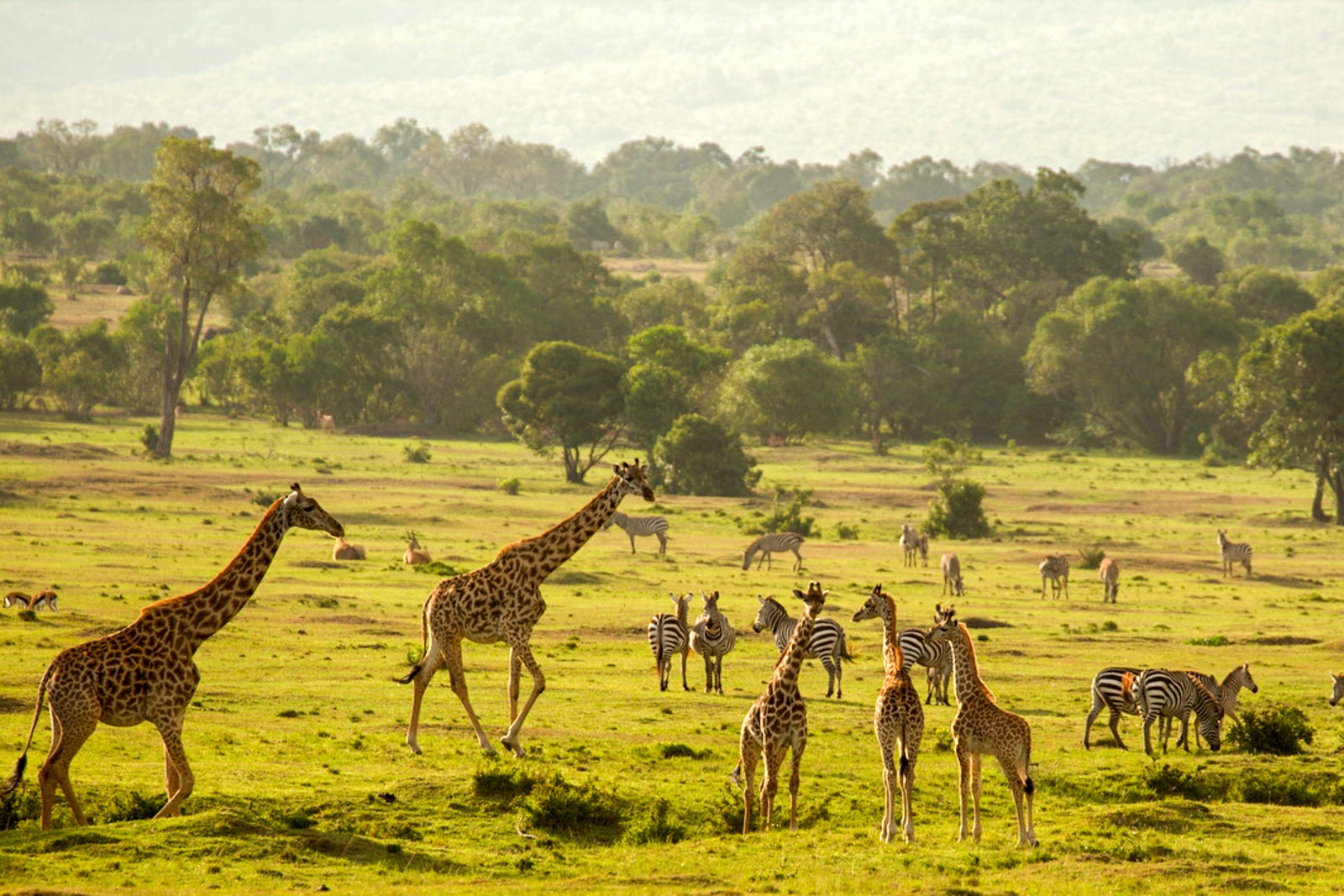
Is there one good time to go for seeing wildlife?
We're here to tell you that no matter what time of the year you go to Africa, you are guaranteed to see wildlife. The density and ease of spotting may change with the months and seasons, and some species will be easier to spot at certain times of year than others. However, there will always be free-roaming animals large and small if you visit the African bush.
That said, some times have a bit more to offer than others in terms of wildlife viewing.
The easiest time to spot wildlife — meaning you'll spend less time searching during your morning and afternoon game drive and more time watching the animals — is during the dry season. This coincides with the Southern Hemisphere's winter months, June through September, and usually reaches into October. During this period animals will be searching for water and will often congregate in the same location around a water hole or stream.
Spring, roughly October through December, is another prime time to visit. This is when many animals have babies, and the opportunity to see these newborns in the wild is truly a special treat. It's also when the foliage bursts into bloom and migratory avian life return to their leafy homes.
Summer brings denser foliage and a more vivid landscape, and for twitchers (birders, as they're known on safari), visiting this time of year offers big rewards. It's harder to spot wildlife with a large amount of dense growth, though, so you may need to spend another day or two on safari to tick off all the wildlife you're hoping to see.
Related: 9 incredible luxury family safari lodges for the ultimate African adventure
Looking for more planning advice for an African safari? Elsewhere's local experts in Botswana , South Africa or Tanzania can help you plan an epic wildlife adventure to those countries. (Note: Elsewhere is owned by TPG's sister brand Lonely Planet).

When’s the best time to go on safari in Africa?
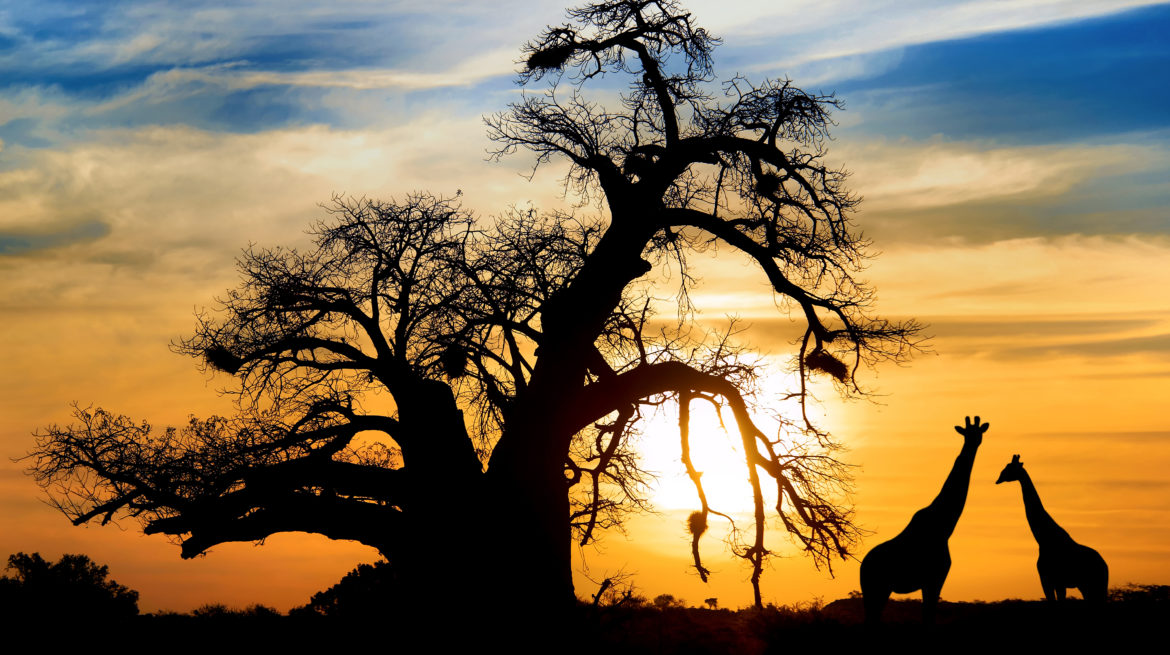
An African safari is the ultimate bucket list trip, so you want to make sure you go at the right time.
The journey will take you across vast, ever-changing landscapes and give you an up-close look at some of the world’s most beautiful animals in their natural environment. You’ll probably want to pack your bags as soon as you start imagining the awesome journey, but a little planning ahead of time can make your trip that little bit more magical.
When is the best time for a safari in Africa?
The best time to go on safari is between June and October, during the dry season. This is a cooler time of the year and you are more likely to see animals, who are searching for water sources. During these months, you can also catch the iconic Masai Mara migration.
Here is a breakdown of some of the best countries to visit, when to go, and the perfect trips for you.
Safaris from January to February
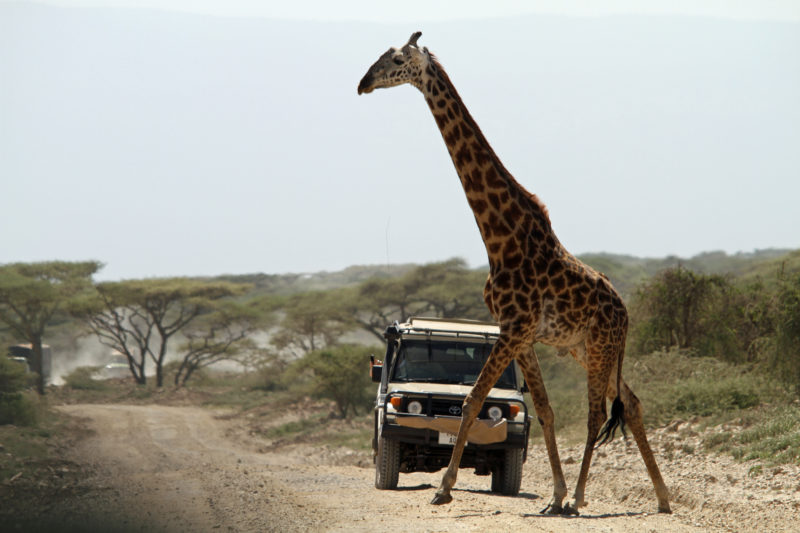
Giraffe crossing in Serengeti National Park
The Great Migration of wildebeests from Tanzania’s Serengeti to Kenya’s Masai Mara is awe-inspiring, to say the least. The precise timing of it is dependent upon rainfall patterns each year, meaning you can see different aspects of it at different times: the mass birthing of calves between January and March in the southern Serengeti, and river crossings between July and August.
In addition to wildebeests, safari-goers will also have the chance to spot Africa’s most famous predator, lions. Prides of lions will follow the herds for the prime hunting opportunity they present. Cheetahs, wild dogs and hyenas also make appearances as they try to take down vulnerable members of the herd. If you’re lucky, you might even see a wildebeest or zebra giving birth.
Read more: 7 reasons why your next adventure should be in Tanzania
Tip from Intrepid’s Africa Product Manager, Jenny:
Have an open mind! A lot of travelers have this unrealistic expectation of seeing river crossings with thousands and thousands of wildebeest (and the odd crocodile) battling it out in the ultimate scene from National Geographic! The migration is a natural phenomenon and no year is the same as the last. That being said, it is magical!
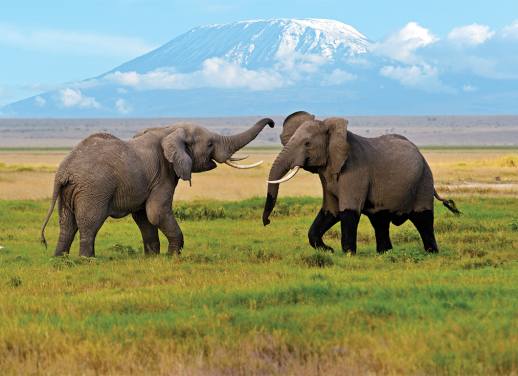
Safaris from March to April
South africa.
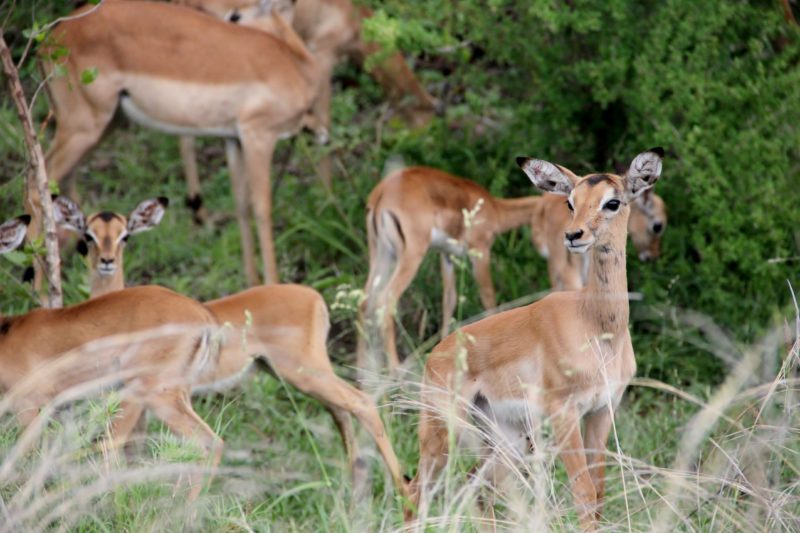
Herd of impalas in Kruger National Park
South Africa is pretty much your one stop shop for everything a good African holiday is made of. It’s also incredibly good value. Consider heading there in March and April for pleasant weather and fewer crowds. These two summer months fall in the country’s wet season, but the rains really do open the door to some of the best wildlife-spotting opportunities.
Kruger National Park, the region’s most famous National Park, not only has the big five (and more!), but is also close to the vibrant, underrated city of Johannesburg.
Read more: 6 reasons why South Africa is a destination with something for everyone
But any time is a good time to visit South Africa. Cape Town offers food, wine, shopping, dreamy views, and activities for all ages. Just outside it lies the popular wine region, located on the Western Cape. You simply can’t go wrong!
If you don’t want to sit in a vehicle all day, our exciting new active itinerary is a great shout. It’s a 9-day cycling and hiking trip through South Africa, and lets you hike Table Mountain, bike through Stellenbosh winery region, and so much more.
The weather is fairly temperate throughout the entire year here so visiting in any season is an option, but it’s a little rainier from June to September. A few months before this time is hot, but not too hot.
The Simien Mountains National Park, a UNESCO World Heritage Site, is one of the best places to go on a safari adventure. The park’s sweeping mountains and deep valleys, the result of erosive activity, are covered in the deep green of alpine forests. Animals living in the park include caracals, leopards, jackals, hyenas, bushbucks, klipspringers and hundreds of species of birds. Safari-goers might also glimpse the rate Simien fox or Walia ibex.
Fall in love with Ethiopia on this amazing 15-day trip or explore our range of small group adventures in Ethiopia .
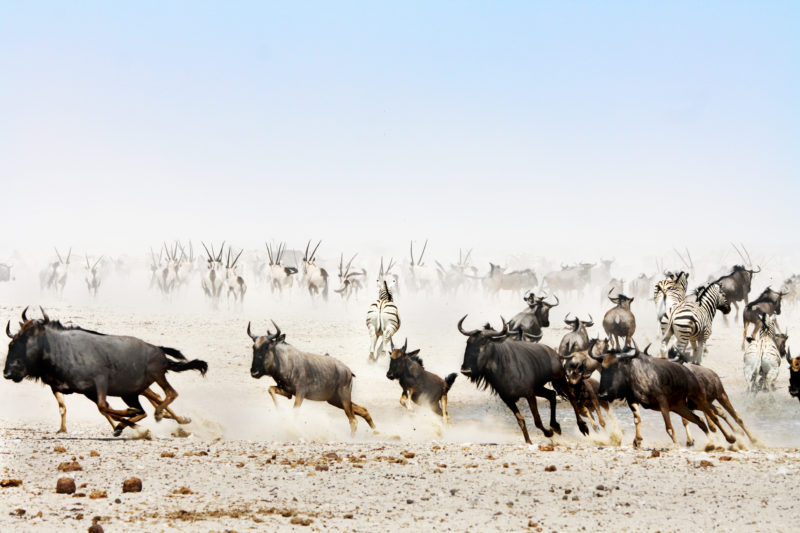
Etosha National Park, Namibia. Image by Rebecca Dannock.
The wildlife viewing opportunities in the desert-filled country of Namibia might surprise (and delight) you. Many different African animals have adapted to live in the harsh-but-beautiful Namib, a coastal desert. Herds of elephants traverse the desert, as do different types of antelope, zebra and even lions. Outside the desert, March can be humid and rainy, but April tends to be drier. The rains that fall early in the year make much of the country verdant in April.
Travel from Vic Falls to Cape Town and discover the highlights of Namibia
Safaris from May to June
May and June are winter months in Madagascar, but the island’s proximity to the equator means pleasant temperatures during the coolest months of the year. You’ll also see particularly lush landscapes in May and June, and these two months are considered part of the low season; there won’t be throngs of tourists.
Read more: 8 reasons why Madagascar should be on your bucket list
For the daring traveler who craves unique experiences, Madagascar is an essential destination. The island is rich in wildlife with hundreds of species of birds, reptiles, amphibians and mammals. The majority of the flora and fauna in Madagascar are endemic – they live naturally nowhere else in the entire world. Take a safari to glimpse lemurs swinging through the trees and the masters of disguise, chameleons.
Experience the undiscovered island of Madagascar on this magical 16-day trip or check out our full range of Madagascar adventures
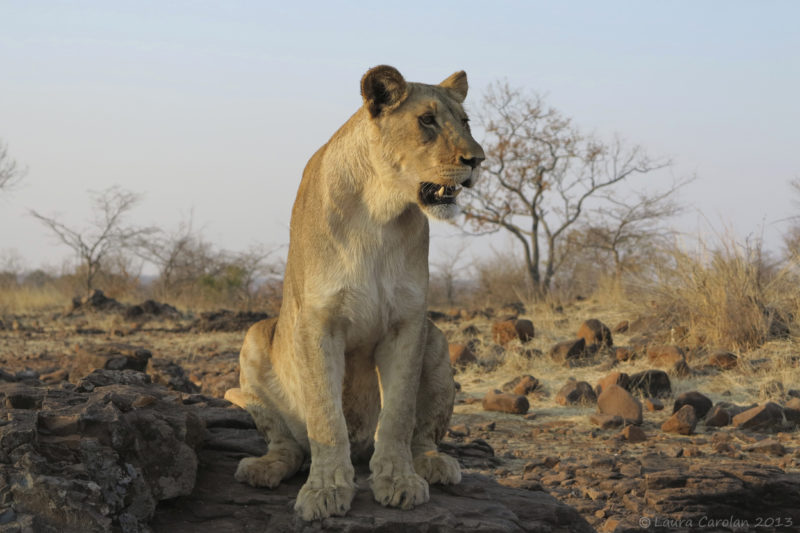
18-month-old lioness in Zimbabwe
In Zimbabwe, May is a transitional month with elements of both wet and dry seasons. The recent rains leave the land looking lush and green, but as the month progresses the weather becomes drier and the nighttime temperatures begin to drop. Come June, the days are warm and pleasant, while the nights are chilly. This time of year is the peak season for safaris. The drier weather draws animals to the country’s rivers and watering holes. Keep a lookout for lions, leopards, rhinos, zebras, elephants and more.
Read more: Here’s why you should visit Victoria Falls
Safaris from July to August
July and August are right in the midst of Rwanda’s dry season (which takes place from June through to September). These two months are very popular for booking gorilla trekking adventures because of the clear skies and sunny conditions. The gorillas live in Rwanda’s rainforests, mainly within the bounds of Volcanoes National Park. Here, you can also see chimpanzees and colobus monkeys living among the trees. Keep in mind that gorilla habitat is, by default, very wet and you can’t avoid rain completely. However, after heavy rain, the skies often open up to bright sunshine.
The permits are a flat price year round and just last week got hiked up from $750 USD to $1500 USD effective immediately. Luckily, Intrepid has pre-purchased permits on our group trips which means we are able to honor existing 2017 prices. So, when is the best time to go? Now, before it gets too expensive!
Go gorilla trekking in Rwanda (and so much more!) on this epic 16-day trip
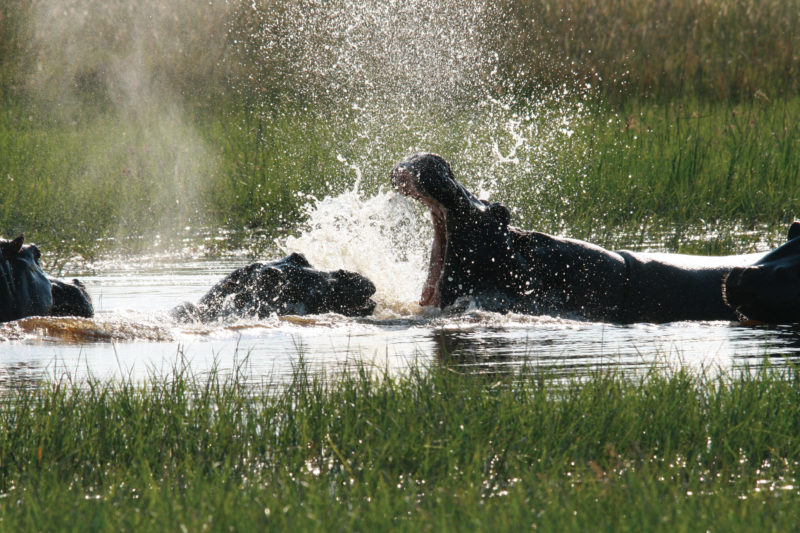
Hippos in Moremi Game Reserve
The Okavango Delta, Moremi and Chobe are among Botswana’s most popular parks and animal-spotting destinations. The best time to visit them is from May to September, during the dry season and winter, which results in more moderate temperatures.
Photo essay: What it’s really like on an Intrepid safari in Botswana
There is also less vegetation during these months, so animals tend to concentrate around waterholes and rivers, making wildlife easier to spot. The Okavango Delta is also in full flood then. The skies are clear, rain is rare and there are fewer mosquitoes. It does get cold at night and in the mornings, so packing warm winter clothing during June, July and August for the cold morning game drives is advisable.
Check out the highlights of Botswana on this life-changing 9-day trip or explore our range of Botswana adventures
Safaris from September to October
There is some light rainfall in September and October, but these two months are still part of the dry season in Ghana. You won’t have to worry about heavy rains causing flooding or travel delays. Birdwatchers will love taking a canopy tour through Kakum National Park – you can spot guinea fowl, African grey parrots and many other types of birds flitting through the trees. The national park is also home to forest elephants, civets, leopards, pangolins, a variety of monkeys and more.
Other wildlife hotspots include the Ankasa Rain Forest, the Wechiau Hippo Sanctuary and Mole National Park.
See West Africa’s wildlife on this awe-inspiring 21-day trip through Ghana, Togo and Benin
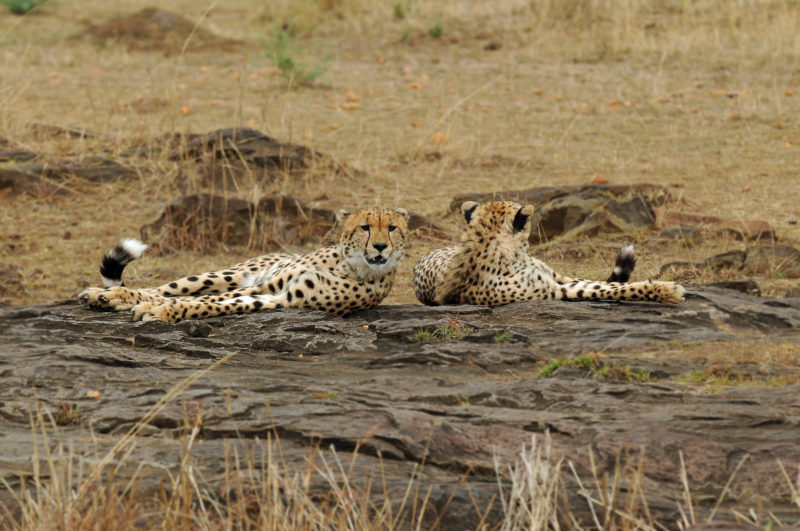
Cheetah siblings in the Maasai Mara
With more than 40 national parks and reserves, Kenya is a dream destination for safaris. This country draws tourists year-round, but September and October have certain advantages. These months are part of the dry season and the weather is also cooler. During these months, you can also catch the iconic Masai Mara migration (guide here ). The mass movement of these animals will attract larger predators, including lions.
Visit some of Kenya’s finest game parks (and see the Big 5) on this 8-day adventure or check out our full range of Kenya adventures
September heralds the beginning of springtime in Eswatini, a fairly dry time of year. Hlane Royal National Park and Mkhaya Game Reserve are ideal destinations for safari-goers who want to get close to animals like elephants, rhinos, buffalo, leopards and lions. In addition to these big mammals, Eswatini is also home to zebras, a variety of antelope, giraffes, hundreds of bird species and more.
Hit up Eswatini’s wonders (and South Africa) on this 9-day ‘Kruger and Coast’ trip
Safaris from November to December
Ivory coast.
November and December are the first two months of the warm and dry season in Ivory Coast. The temperate weather and minimal rainfall are ideal for travelers. And Taï National Park, a UNESCO World Heritage Site, is perfect for wildlife seekers. The park protects a tropical rainforest and its inhabitants include chimpanzees, pygmy hippos, leopards, colobus monkeys, flying squirrels, two species of bat, a variety of birds and much more.
This epic 28-day trip covers four countries in West Africa (the beautiful Ivory Coast included)
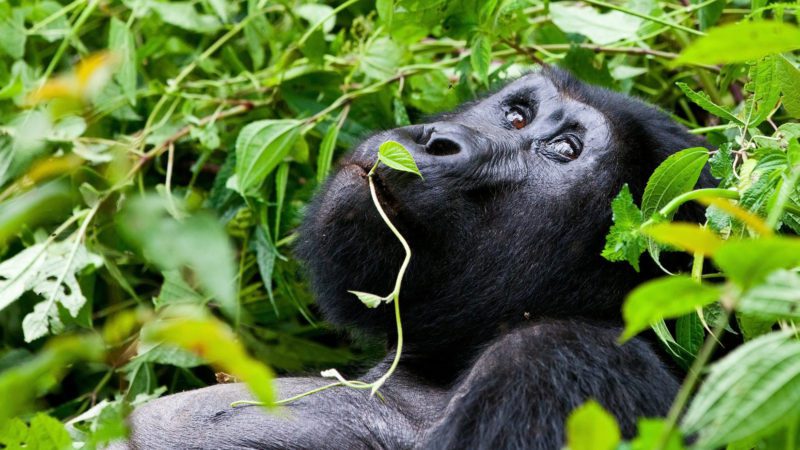
This low season also takes place in March and April and the pay-off is well worth it. Why? Well, as Jenny, Intrepid’s Africa Product Manager puts it, “Without the crowds you could find yourself trekking the gorillas with as little as 2 or 3 other people”. She adds that “it’s unlikely to rain all day. You’ll get a downpour at some stage each day, or even light rain on and off, but there are plenty of blue sky days as well.”
Explore the Ugandan rainforest and more on this incredible 21-day trip. Or, if you’re pressed for time, check out this 4-day gorilla short break in Uganda.
A note on the rainy season: don’t dismiss it!
Generally distinguished as the low season in Africa, the ‘green season’ is characterized by frequent rains. It’s a great option for travelers who can live with a bit of rain, and a bit more of a challenge when it comes to animal spotting. The vegetation is thick, and the grass high making wildlife harder to spot, and water is plenty so you don’t get a lot of animals congregating around waterholes.
What you do get is incredible, lush, green landscapes. Most animals give birth at the beginning of the rainy season so you will see plenty of newborns. It’s also a bird lover’s paradise with flowers in bloom and many migratory birds arriving back in the area from as far as Asia or Europe. The Serengeti and Masai Mara may be home to the world’s largest annual migration but green season Botswana hosts part of the longest recorded migration! Thousands of Burchell’s zebras cover more than 500km in a straight line across Namibia and Botswana.
It really is a great option for those second-time visitors to Africa who have been there, done that, seen the Big 5 and want to experience something ‘different’. Some destinations like Botswana in particular look like an entirely different place from one season to the other and it’s pretty amazing to see both ends of the spectrum, and you can get some incredible savings for traveling at this time of year. For example, travel on our new Okavango Delta Fly-in Safari in low season and you could be saving yourself about $1500 USD per person (as opposed to high season).
Ready to explore Africa on safari? Check out our wide range of small group trips.

Carrie Pallardy
Carrie Pallardy is a Chicago-based writer and editor. Despite just returning from a trip to New Zealand, her wish list of places to travel is nearly endless. She plans to travel to every continent and every national park in the U.S., and, of course, loves to write about her experiences traveling near and far.
You might also like
The 7 best places to go on a..., 5 reasons to visit sri lanka in the..., why 2024 is the best year to see..., yellowstone vs yosemite: which national park to visit, 6 unique experiences you can have in el..., from delhi to udaipur, here are the five..., cinque terre vs amalfi coast: which destination to..., love at first bite: 10 famous sandwiches from..., galapagos or madagascar which unique destination should be..., central vs south america: how to plan your..., 4 reasons you should take a road trip....
National Geographic content straight to your inbox—sign up for our popular newsletters here

Everything you need to know before booking your first African safari
For many, a safari represents the optimal escape and lifelong travel dream. If you’re going to invest in turning this dream into reality, there are some things worth considering. Plus, we recommend five incredible wildlife itineraries for 2023.
From the first waft of dewy morning air to the gentle owl hoots that drift into camp after dark, there’s a satisfying natural rhythm to a day on safari in Africa. Even if you’re not normally an early riser, you’ll quickly fall into the routine of pre-dawn starts, lazy lunchtimes, active afternoons and mellow evenings, making the most of the best hours both for wildlife-watching and for chilling out. Deep at night, if you’re lucky, you may hear the distant whoop of a hyena, the rasping call of a leopard or the bassy roar of a lion.
But more often than not, you’ll sleep soundly, drunk on fresh air. Soon after you wake, you’ll head out into the wild, eager to discover what the day will deliver. Perhaps you’ll find yourself inching up on some rhinos, watching boisterous elephants bathe in a waterhole or spotting the youngest, cutest members of a mighty big cat dynasty.
If this sounds like the kind of escape you’ve been craving, but you’re puzzling over possible itineraries, what’s the best way to choose?
Green means go
While every luxury safari offers unforgettable wildlife encounters, there are plenty of options to consider. High-end African trips and settings vary hugely in their atmosphere and style.
Some itineraries, for example, are much greener than others. If you’re passionate about nature, you’ll want to make ethical choices, mindful of climate change and biodiversity, perhaps by minimising your time in the air. While every long-haul trip has a high carbon footprint, you can limit your safari’s impact by choosing a destination near an international airport and sharing a vehicle rather than continuing by taking domestic flights.
With superb wildlife-watching opportunities within driving distance, Nairobi makes an excellent starting point for a low-airmiles luxury safari. “You could head for the stunning mountains and waterfalls of the Aberdare range, where lions hunt giant forest hogs”, says Kenya specialist Richard Trillo of Expert Africa. “The tree-dotted plains of the Maasai Mara, which host East Africa’s annual Great Migration, are also within reach,” Richard adds.
There are other ways to dial down the net impact of your trip without compromising on quality, however. While carbon offset schemes can help compensate for your emissions, for a more targeted approach, you could book your trip through a specialist safari operator that has established working partnerships with African conservation charities.
“We’re proud to support South Africa’s all-female Black Mamba Anti-Poaching Unit, and Greenpop, a non-profit Sub-Saharan forest restoration and urban greening organisation,” says Marcelo Novais of luxury operator Ker and Downey Africa.
“We give all our clients the opportunity to donate to these worthy causes, since leaving a positive legacy is one of our core values,” he adds. Other deserving organisations include African Parks, the African Wildlife Foundation, Tusk and the World Land Trust.
Another effective way of maximising the benefits of your trip is to choose lodges that go the extra mile in their vicinity, doing more for environmental protection, community partnerships and rural development than merely covering park fees and basic wages. In Tanzania, the Elewana Arusha Coffee Lodge invites guests to visit the craft project they support, Shanga, where locals with disabilities upcycle glass, textiles and fishing wire into cute elephant cushions, jewellery and clothing.
When it comes to shortlisting properties, membership of Ecotourism Kenya, Responsible Tourism Tanzania, Fair Trade Tourism and the Global Sustainable Tourism Council are generally useful indicators.
Settling in
Once you’ve arrived in the bush, what will your surroundings feel like? Anyone who’s cautious about camping in the wilderness will be relieved to discover that most top-end operators put their guests at ease by focusing on creature comforts: cool drinks, gourmet dining, indulgently appointed private bathrooms and sumptuous beds, for example. As a rule, their staff — from the head guide to the housekeepers — are superb at their jobs.
That said, there are significant differences between, on the one hand, intimate, minimalist camps with just a handful of canvas tents and, at the other extreme, sizeable lodges featuring swimming pools, gyms and perhaps even a spa, photography hide, editing suite, research centre, library and observatory. It’s a matter of weighing up how close to nature you’d like to feel — hearing all those thrilling sounds in the night, for example — against the range of facilities and creature comforts you’d like to enjoy.
When deciding, honest opinions from people who know the properties well can be invaluable. “Our safari specialists always have detailed conversations with our clients to understand their preferences and offer advice”, says Liberty Gilmour of Audley Travel. “Conventional aircon, for example, is rarely essential: Zambia in May and high-altitude destinations such as Ngorongoro can be quite cool, particularly at night. If it’s hot, natural ventilation may be sufficient, but many camps also have solar-powered cooling systems.”
Whether opulent, nostalgic or quirky, surroundings that suit your aesthetic aspirations can elevate your experience. The family heirlooms that decorate Camp Jabulani in South Africa’s Kapama Reserve, for example, create a uniquely cosy atmosphere, while Xigera Safari Lodge in Botswana’s Okavango Delta is so proud of its collection of original pieces by contemporary African artists and artisans that staff offer art and design tours of the premises. To strike a contemporary note, Loisaba Lodo Springs in Kenya’s Loisaba Conservancy has rooms dotted with hand-stitched West African textiles and elegant upcycled Edwardian furniture.


Peaceful days
Almost every safari programme revolves around guided excursions called game drives, a name dating back to the days of Big Five hunting trips, but the style of the vehicles you ride in isn’t discussed as much as perhaps it should be. While some outfits settle for basic open-sided 4x4s, others invest in supremely comfortable, easy-access vehicles with charging points, dustproof storage space and a fridge. If you’re a keen photographer, top quality private vehicles are a must. Electric safari vehicles offer a particularly smooth ride; while still rare, they’re the future, and are starting to catch on.
Ila Safari Lodge in Zambia’s Kafue National Park offers the rare luxury of total peace and quiet. Founder Vincent Kouwenhoven, who has pioneered electric transport at Ila and its sister lodges in Zambia and Malawi, explains: “Our love for Africa led us to develop technologies that enable guests to experience the bush in near-silent, pollution-free vehicles, charged by our own solar panels. It’s an ecologically conscious way to watch wildlife and very calming, too. Instead of the engine, you hear birdsong.”
Some safaris also promise near-solitude in a vast natural landscape — an intoxicating feeling. One way to dodge the crowds is to travel during low season, the dates of which vary from location to location; alternatively, you could choose private reserves where the only vehicles you’ll see will be those of your fellow guests. As well as providing daytime activities, guides may offer night drives, using spotlights to search for nocturnal activity, such as birds roosting or lions stalking their prey.
For the ultimate in exclusivity, it’s possible to book an entire camp or lodge, with the staff handcrafting everything to your precise specifications, from wake-up times to the cocktails and canapes. According to Ash Jarvis of Best of South Africa Travel, exclusive-use properties work particularly well for mixed-generation families: “With their private game drives, multiple living areas, private pool and the undivided attention of the whole staff, including the chefs (fussy eaters welcome), they eliminate stress and ensure that nobody has to compromise. That’s what good family holidays are all about.”
The ultimate adventure
If serenity is your scene, you may be dreaming of floating over herds of zebras and wildebeest in a hot-air balloon, or wandering across the savannah on a bushwalk or cycle ride. The most interesting safaris offer a mixed programme of imaginative guided activities such as these, enlivening the days with little surprises: picnics in beauty spots, perhaps, or lantern-lit barbecues.
The possibilities depend, to a large extent, on your choice of location. In Kenya’s northern conservancies, for example, you could explore the semi-desert by camel, while in Rwanda or Uganda, the activity you probably won’t want to miss is venturing into the depths of the rainforest on foot for a precious one-hour audience with mountain gorillas.
On a gorilla trek, you’ll be guided by rangers at the top of their game — a hallmark of an excellent safari. A knowledgeable, communicative guide can transform any trip, keeping you safe, entertained and intrigued.
“The inside track is what you really want, whether that’s in guiding, photography or conservation”, says Will Bolsover of Natural World Safaris. “In-depth knowledge leads you beneath the surface, for true insights into how conservation works, how wildlife benefits and how you can contribute.”
Since quality time with experts is one of the ultimate luxuries you can enjoy on safari, some top-end safaris, particularly in Kenya and South Africa, include a philanthropic element, whereby in exchange for a substantial donation to a conservation fund, you gain access to specialists in the field, perhaps even helping collar predators or collecting DNA samples from juvenile rhinos. Conservation safari companies such as Great Plains and AWF Safaris can assist with this. There’s no better way to start unlocking the mysteries of the African wilderness.

Five luxury safari trips in Africa to try in 2023 and beyond
1. low-carbon luxury in kenya.
After a night at Nairobi’s fabled Giraffe Manor, travel overland to Solio Lodge in the Central Highlands to explore Kenya’s oldest rhino conservation sanctuary, then continue to Sala’s Camp, in one of the least-visited corners of the Maasai Mara. Eight days from £8,400 with Expert Africa. expertafrica.com
2. Take to the skies in Tanzania
Flip from park to park in style on a SkySafari, travelling by private plane and touching down at luxurious Elewana Collection properties. This classic circuit takes in Arusha, Tarangire, Ngorongoro and the Serengeti, for blockbuster wildlife-watching. Ten days from £8,300 with Sky Safari. skysafari.com
3. Family adventures in South Africa
South Africa has a host of prospects to suit muti-generational families. Delightful safari properties such as Morukuru River House team well with Cape Town, the Cape Winelands and the Garden Route. Fourteen days from £4,500 with Best of South Africa Travel. bestofsouthafricatravel.com
4. Clock the Big Five in the safari heartlands
To experience some of southern Africa’s most exclusive wilderness retreats, string together Bushmans Kloof in South Africa’s Cederberg region, Sossusvlei Desert Lodge in Namibia, DumaTau in Linyanti and Xigera in the Okavango Delta. Twelve days from £24,797 with Beyond Green. staybeyondgreen.com
5. Meet mountain gorillas in Rwanda
Nothing can prepare you for the surge of emotions you’ll feel when, after an exhilarating trek, you first encounter a family of gorillas in the rainforest. Combine your hike with game drives in Rwanda’s Big Five national park, Akagera. Eight days from £7,493 with Jacada Travel. jacadatravel.com
Published in the 2022 edition of National Geographic Traveller (UK) The Luxury Collection
Follow us on social media
Facebook | Twitter | Instagram
Related Topics
- ADVENTURE TRAVEL
You May Also Like

Affordable gorilla encounters in Uganda's Bwindi Impenetrable Forest

How I got the shot: Ben Pipe on coming face to face with a lion
Free bonus issue.

Free roam safari: a self-guided campervanning trip through South Africa & Eswatini

5 game drive alternatives, from cycling to horse-riding

Are South Africa’s captive lions inbred?

Who buys lion bones? Inside South Africa’s skeleton trade

4 incredible places in urgent need of conservation
- Environment
- Perpetual Planet
- History & Culture
History & Culture
- History Magazine
- Mind, Body, Wonder
- Terms of Use
- Privacy Policy
- Your US State Privacy Rights
- Children's Online Privacy Policy
- Interest-Based Ads
- About Nielsen Measurement
- Do Not Sell or Share My Personal Information
- Nat Geo Home
- Attend a Live Event
- Book a Trip
- Inspire Your Kids
- Shop Nat Geo
- Visit the D.C. Museum
- Learn About Our Impact
- Support Our Mission
- Advertise With Us
- Customer Service
- Renew Subscription
- Manage Your Subscription
- Work at Nat Geo
- Sign Up for Our Newsletters
- Contribute to Protect the Planet
Copyright © 1996-2015 National Geographic Society Copyright © 2015-2024 National Geographic Partners, LLC. All rights reserved
Top-Reiseziele
Alle Reiseziele
- Argentinien
- Kirgisistan
- Philippinen
- Tadschikistan
Safari in Südafrika: 5 Tipps zur besten Reisezeit
Bei WeDesignTrips helfen Dir lokale Experten von Reiseveranstaltern unverbindlich Deine individuelle Südafrika Reise zu planen.
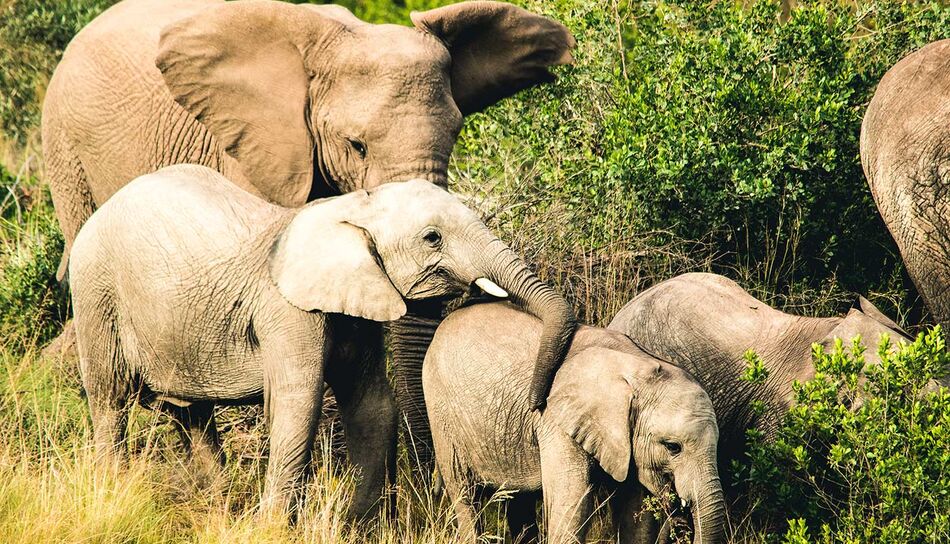
Kannst Du sie schön hören? Die trötenden Elefanten, galoppierenden Zebras und brüllenden Löwen! Eine Safari in Südafrika ist ein einmaliges Erlebnis und sollte auf Deiner Reise nicht fehlen. Welche Monate sich aber am besten eignen, um den Big Five näher zu kommen und welche Jahreszeit welche Vorteile mit sich bringt, zeigen Dir unsere lokalen Experten.
Inhaltsverzeichnis
Die besten routen für deine südafrika-safari, beste reisezeit für wildtiersichtungen, die beste reisezeit für eine safari ist in den trockenen monaten:, vorteile der trockenzeit:, nachteile der trockenzeit:, beste reisezeit tiernachwuchs, beste reisezeit walbeobachtung, die besten spots zur walbeobachtung in südafrika:, neben den walen kannst du in südafrika auch noch auf folgende meeresbewohner stoßen:, bereit für dein ultimatives wildtier-abenteuer.
Garden Route: Safari & Walbeobachtung
ab 1.790,- €
Beste Reisezeit
Oktober-April
Südafrika Highlights: Garden Route bis ...
ab 2.990,- €
Safari-Reise für Aktive
März-Oktober
Safari im wundervollen Nordosten
ab 1.810,- €
Südafrikas Top 5 Nationalparks: Safari & Tipps
Südafrikas Nationalparks sind so vielseitig wie die Regenbogennation selbst. Von den Big Five, übe...
Wenn es darum geht die meisten Wildtiere zu sichten, dann solltest Du Deine Safari in den Trockenmonaten planen. Im Norden, wie bspw. dem Krüger Nationalpark, heißt das von April bis September. An der Westküste der Game Reserves nahe Kapstadt solltest Du die trockenen Monate im Sommer von November bis März nutzen.
- Norden: Winter (April – September)
- Kapstadt: Sommer (November – März)
- Tiere versammeln sich um die wenigen Wasserstellen und so bekommt man viele Tiere zu Gesicht
- Da die Bäume nur sehr wenige Blätter tragen, können sich die Tiere nicht in den Büschen verstecken
- Die Straßen, speziell als Selbstfahrer, sind in den Trockenmonaten weitaus besser zu befahren
Maßgeschneiderte Planung
Verrate jetzt Deine Wünsche & ein lokaler Südafrika Experte plant kostenlos für Dich!
- Speziell rund um die Garden Route gilt November bis März als Hauptsaison und so triffst Du auf zahlreiche Reisenden. Außerdem solltest Du Deine Unterkünfte und Game Drives weit im Voraus buchen
- Die Landschaft wirkt aufgrund der Trockenheit sehr karg
- Es kann in der Nacht aufgrund der Wintermonate im Norden sehr kalt werden
Wer kommt nicht ins Schwärmen, wenn man einen kleinen Babyelefanten gemeinsam mit seiner Mutter in der Ferne sieht oder die kleinen Löwenbabys spielerisch über die Wiese jagen. Möchtest Du die Tiere mit ihren Neugeborenen sehen, so solltest Du Deine Safari von November bis März planen, denn zu dieser Zeit erblicken die Meisten das Licht der Welt.
Die Big Five zu Lande sind Dir nicht genug und Du möchtest die Riesen der Meere hautnah erleben? Dann solltest Du von Juni bis November nach Südafrika kommen, denn hier hast Du die Möglichkeit Buckelwale, Brydewale oder auch Südkaper zu sichten.
- Cape Agulhus
- Garden Route (Wilderness, Knysna, Plettenberg Bay, Mossel Bay)
- Weißer Hai
Wie lange nach Südafrika? | 3 Tipps zur Reisedauer
Du hast eine Reise nach Südafrika geplant, weißt aber nicht, wie viel Zeit Du berechnen solltest? ...
Egal wann Du nach Südafrika reist, die Tierwelt ist einfach überwältigend. Lass Dich von unseren lokalen Experten beraten und finde Deine perfekte Route durch die Regenbogennation.
Unsere Vorteile für Dich bei WeDesignTrips
Lokale Experten Plane Deine Reise gemeinsam mit lokalen Experten direkt vor Ort
Maßgeschneidert Bei WeDesignTrips gleicht keine Reise der anderen, denn sie wird an Deine Wünsche angepasst
Kontakt vor Ort Auch während Deiner Reise stehen Dir unsere lokalen Experten mit Rat und Tat zur Seite
Nachhaltigkeit Durch Deine Buchung über WeDesignTrips profitiert die lokale Bevölkerung in Südafrika
Sicherheit Deine Reise ist durch WeDesignTrips als europäischen Reiseveranstalter abgesichert
Basierend auf Deinen Interessen
Wellenreiten in Südafrika: Top 8 Surfpots für jedes Niveau
Die wohl wichtigste Frage vor jedem Surftrip: Wo gibt es die besten Wellen? In Süafrika gibt es zie...
Safari in Südafrika: 6 Tipps, um die Richtige zu finden!
Ein Jeep, der durch die afrikanische Landschaft braust, vorbei an Elefanten Herden und an der Straß...
Aktuelle Suchen
- Ruanda Juni
- Bolivien Mai
- Usbekistan August
- Malaysia Rundreisen
- Addis Abeba
- Huilo Huilo
- China September
- Franschhoek

4 Great Countries in Africa for Your First Safari
These experiences and operators offer a range of price points and embrace sustainable tourism practices..
- Copy Link copied
If you’ve never been on safari in Africa before, rest assured that no wildlife documentary can capture the awe of experiencing the region’s vastly contrasting landscapes and cultures in person. There are the sweeping savannas of the Serengeti-Mara ecosystem in East Africa, home to the world’s largest migrating animal herds, while green Central Africa is a habitat for the last remaining mountain gorillas on Earth. Southern Africa is home to such famous natural wonders as the Okavango Delta and the otherworldly Kalahari Desert. And in West Africa, forthcoming infrastructure in destinations like Pendjari National Park in Benin, where West African lions roam, is opening up lesser-explored areas for wildlife viewing.
Africa is composed of 54 countries with varying experiences ranging from thriving urban scenes to sublime landscapes. The continent’s seemingly endless wilderness experiences can be especially hard to navigate for the first-time safarigoer.
With that in mind, AFAR has picked four countries to get them started. Experiences include the fenceless savannas of Kenya, where such groups as the Maasai own and manage private conservancies; South Africa, with its family-friendly, malaria-free reserves and impressive rewilding projects; the wildlife-filled rivers of Zambia, known for family-owned camps and walking safaris; and Tanzania, home to sprawling, fenceless savannas and Mount Kilimanjaro.
These countries are only scratching the surface of nature-based experiences in Africa—and the beginning of a lifetime of return trips to explore. While we won’t cover the vibrant metropolises of these countries this time, you’ll regret skipping them, so ask your outfitter to work an urban experience into your trip. Here are four of the best places to go on safari if you’ve never been before.

Asilia Jabali Ridge
With nearly two dozen national parks , Tanzania contains some of Africa’s largest remaining unfenced wilderness areas. It’s home to wildebeest who roam together in numbers upwards of a million and make dramatic crossings through the country’s river systems. Those who want to see the river crossings should aim for July to September, but the November-to-March green season can be even more appealing—the rains are short, there are fewer crowds, and you can catch the excitement of calf birthing season.
Serengeti-Mara Ecosystem
Tanzania’s most famous park gets the lion’s share of attention for being the site of the seasonal Great Migration of wildebeest. andBeyond Grumeti Serengeti River Lodge is well situated right in the path of a major river crossing area. A 2022 refurbishment transformed the camp into a design-driven retreat with sustainably sourced local hardwoods and colorful kitenge fabrics inspired by the region’s craft traditions. The camp, which now runs on 80 percent solar energy, offers plenty of ways to get outside of the safari vehicle, whether you’re tracking elephants on foot or visiting fishing communities on nearby Lake Victoria.
Sitting within the greater Serengeti-Mara ecosystem on its own 350,000-acre reserve, Singita Grumeti operates five lodges and camps, each with their own approach to the safari experience. There’s the hilltop Sasakwa Lodge, with its chandeliered guest rooms featuring four-poster beds, deep soaking tubs, and plunge pools that overlook the savanna. The lodge doubles as a museum, with rare artifacts from all over Africa and photography by the likes of Peter Beard. The recently renovated Sabora Tented Camp—an AFAR favorite—offers a more intimate connection with nature, thanks to outdoor showers and canvas walls that let all the noises of the bush lull you to sleep (or keep you awake).
Ruaha National Park
Ask a seasoned safari hand what their favorite wilderness area is in Tanzania, and there’s a good chance they’ll tell you it’s Ruaha National Park. Less-visited Ruaha happens to be the country’s second largest national park, and you could spend an entire trip exploring its widely varied landscapes, which range from miombo forests to sprawling wetlands. Asilia Africa’s camps offer a variety of experiences.
Located on a boulder-filled hill near the Mwagusi River, Jabali Ridge is a prime spot for sightings of lion prides and leopards, as well as elephants who dig beneath dry riverbeds in search of water. The design-driven camp itself features eight suites with a soothing palette of grays and natural woods; a massage in the airy spa comes with a soundtrack of birdsong. For those who want a hands-on conservation experience, the new Asilia Usangu Expedition Camp in the remote Usangu Wetlands offers that. It’s located in a former hunting block that the government is now researching and monitoring; Asilia stepped in as a partner to help raise tourism funds to go toward those efforts. Guests can help monitor wildlife by setting up camera traps and studying animal behavior through thermal monocular lenses—and any data they collect supports the research work happening here.
How to book
andBeyond puts together custom trips that include andBeyond Grumeti Serengeti River Lodge and other andBeyond and non-andBeyond camps. Niarra Travel can create individualized itineraries that include andBeyond, Singita, and Asilia camps.

Safari operators like Micato send guests to community-owned conservancies, which are sustainably operated and limit visitation.
Courtesy of Micato / Giuliana Provenzano
Kenya is a mosaic of contrasting landscapes and home to more than 40 distinct tribes and communities . In the arid hills to the northeast, the Laikipia Plateau is the historical land of the Samburu and Kikuyu among others; to the south, a safari in the Tsavo and Amboseli national parks means large elephant herds, self-drive safaris, and views of Mount Kilimanjaro. The iconic savannas of the Maasai Mara National Reserve are where millions of wildebeest known as the Great Migration roam, with hungry predators like lions and cheetahs in tow.
The Maasai Mara
The Mara fills with visitors in the dry period between June and October, when there’s less green foliage to hide wildlife; in July, hundreds of vehicles line the rivers to watch epic wildebeest herd crossings. But a visit outside of high season can be even more rewarding, according to Dennis Pinto, managing director of Nairobi-based Micato Safaris . “The lushness of the landscapes throughout Kenya right after the April rains, during the off-peak green season, makes for a photographer’s paradise,” he said. “Wildebeest, zebra, and multitudes of other plains game being born make April and May such a wonderfully literal time of renewal—along with the predators looking for easy prey.”
Micato frequently sends guests to the private, community-owned conservancies adjacent to the Mara reserve that are sustainably managing wildlife on their lands—and have more restricted visitation, which translates into fewer crowds, benefiting both visitors and nature. One such camp is the well-appointed, 12-tent Mahali Mzuri , a Virgin Limited Edition camp that leases land from the Masai-owned Olare Motorogi Conservancy .
Tourism on conservancies creates jobs and supports the creation of roads, schools, scholarships, hospitals, and enterprises such as basketry, according to Vincent Oluoch, the program officer who oversees tourism for the Kenya Wildlife Conservancies Association , which represents 174 conservancies across Kenya. Since the height of the pandemic, “most facilities within the conservancies have started experiencing a steady increase in visitor numbers, including domestic visitors, and in turn have started generating necessary revenues,” said Oluoch.
Some conservancies operate their own tourism businesses—often at gentler prices than international lodges. Oluoch recommends a safari in the Nashulai Maasai Conservancy , which owns and manages Oldarpoi Mara Camp , a series of midrange cottages and tents with en suite bathrooms and Maasai design touches. In the Tsavo Conservation Area, he suggests the recently renovated Kivuko Eco Camp , composed of a family house and camp accommodations run by the Taita Wildlife Conservancy.
Nairobi-based luxury outfitter Micato Safaris , owned and run by a Kenyan family, can arrange a custom-designed itinerary in Kenya that takes travelers to such private conservancies as Olare Motorogi and the Tsavo Conservation Area as well as the Maasai Mara National Reserve. Ask it to work in a couple of days in Nairobi, a vibrant city the company knows particularly well. Travelers can also book experiences directly through some conservancies, including Nashulai .
South Africa

The Tswalu Kalahari Reserve, in South Africa, is a popular—and malaria-free—spot.
Courtesy of Your Private Africa
With its winelands, grasslands, ancient forests, and windswept coasts, rural South Africa offers something for nearly everyone. Varying experiences also make it a year-round destination, with the cooler months falling between July and September.
Kruger National Park
In the country’s popular Kruger National Park, dry season falls between April and October. Green season can be a great option for those in search of better prices and fewer people. Showers are often brief, and less dust from the rain makes for beautiful light.
London-based tour operator Byron Thomas founded Niarra Travel in May 2021 to ensure that as much money travelers spend in a destination stays there—especially at smaller camps with few rooms that don’t have a lot of earning power. “Niarra’s goal is to get as much money to the destination as possible, and the best way to do this is booking directly,” said Thomas. “The second best way is to use a tour operator who has a real, vested interest in making sure they provide that service of putting together a trip that’s the right one for you as cheaply as possible for the particular destination.”
The Cape Town region
Niarra takes a 10 percent commission from companies on the ground, much lower than the industry standard, which can reach as high as 35 percent. The company also partners with responsibly run businesses with guidance from such groups as the Long Run , an organization that helps nature-based tourism businesses to drive such sustainability initiatives as community well-being and land and wildlife conservation. The 11-day Family Adventure itinerary starts with whale watching in the De Hoop Nature Reserve near Cape Town while staying at the four-bedroom Morukuru Ocean House. It continues to the malaria-free Madikwe Game Reserve, which has sunny days for much of the year. Game drives lead to lion, leopard, and elephant sightings, and guests sleep at the three-bedroom Morukuru River House .
Sabi Sand Game Reserve
For a safari that’s both ecofriendly and stylish, Nick Bay, founder of Seattle-based tour operator Your Private Africa , recommends Cheetah Plains in the Sabi Sand Game Reserve. Electric, solar-powered game drive vehicles offer not just a zero-emissions game drive but also quieter encounters with wildlife. The modern-feeling villa accommodations are a sight on their own, with their minimalistic interiors decorated with the work of contemporary African artists.
The Kalahari Desert
Bay also suggests heading north to the Kalahari Desert near the border of Botswana to experience Tswalu Kalahari Reserve , another malaria-free area set on a former cluster of overgrazed farmland that South Africa’s Oppenheimer family purchased and helped to rewild. Today it’s home to brown hyena, meerkats, desert black rhino, and large predators, including cheetah. Tswalu has an on-site researcher, Wendy Panaino, who is dedicated to studying ground pangolins , the world’s most trafficked animal, which can be found on the reserve.
Tswalu’s accommodations include the Tarkuni villa, a large home perfect for families. “The villa is especially family friendly, which is an emerging trend for safaris—bringing children six and under,” said Bay.
U.K.-based Niarra Travel offers several South African itineraries including the 11-day Cape, Wine, Wildlife, and Waterfalls, which goes to Kruger National Park and the country’s famous winelands. The 11-day Family Adventure in South Africa trip visits the malaria-free Madikwe Game Reserve for glimpses of big cats and elephants and the coastal De Hoop Nature Reserve for whale watching. U.S.-based Your Private Africa arranges customized private safaris for a wide range of travelers and budgets from start to finish, and it can organize hands-on conservation experiences at places like Tswalu.

Consider Chiawa Camp for a family-friendly safari.
Courtesy of Classic Portfolio / TCunniffe
Home to the Zambezi, Kafue, and Luangwa rivers, and sharing roaring Victoria Falls with neighboring Zimbabwe, Zambia offers a wide range of land- and water-based wildlife experiences. Safaris here are characterized by small, family-run camps that put guests especially close to nature through walking safaris, for which the country is famous (yet it’s still one of southern Africa’s less visited destinations). The popular dry season falls between July and November, but the April to June shoulder season, when the landscape turns green in the wake of the rains, is an especially good time to see Victoria Falls.
“Zambia is personally my ultimate safari experience,” said Suzanne Bayly-Coupe, managing director of Classic Portfolio , a collection of 53 independent lodges in 10 African countries. “It is one of the very few countries that has not been dominated by the bigger commercial safari companies.” According to Bayly-Coupe, Zambia’s water-based wildlife experiences rival those of the Okavango Delta in Botswana.
Lower Zambezi National Park
She recommends Chiawa Camp in Lower Zambezi National Park, which offers canoe rides along the crocodile-filled Zambezi River and has a multi-room family tent for parents with kids; about 20 miles to the east at Old Mondoro , five riverside chalets all have outdoor baths. In South Luangwa National Park, also known as valley of the leopard, add on a few nights at one of the half dozen tiny camps run by the Bushcamp Company .
South Luangwa
Niarra will soon add a trip in partnership with Green Safaris , which operates camps with light footprints, including the canvas-tented Shawa Luangwa Camp in South Luangwa. “We’ve been really impressed with the aptly named Green Safaris, which are all off-grid and all electric, including vehicles, bikes, and boats, and they’re doing a lot of good work on the ground,” Thomas said.
Lower Zambezi
According to Bay, some of the newest camps in Zambia focus on energy efficiency, resource conservation, and community capacity building. They include Lolebezi Safari Lodge in the Lower Zambezi, which is powered by solar panels, has its own water treatment plant, and was built with minimal use of concrete.
Livingstone
One of his favorite lodges in Zambia is Royal Chundu Island Lodge in Livingstone, which is easy to reach because of its location near Victoria Falls and an international airport. “Aggie Maseko, one of the owners, is a hospitality maven and makes it hard to ever leave,” said Bay. “The menu is composed of local ingredients elevated to French Relais & Châteaux standards.” Take a boat transfer to Katombora Island on the Zambezi River, where four sprawling villas have their own private river-facing decks that hover 40 feet above the ground. Go on a day tour to nearby Chobe National Park in neighboring Botswana for sightings of lions, cheetahs, wild dogs, and giraffes.
Book a tailored trip through southern Africa with these Classic Portfolio properties through such outfitters as Africa travel experts Explore Inc. or Your Private Africa. Niarra Travel offers a 13-day Victoria Falls, Okavango, and Cape Town itinerary that incorporates the Zambezi River and Falls into a three-country itinerary (Zambia, Botswana, and South Africa).

Maps & Merlot
African Safari Travel Tips: 20 Top Things to Know Before Going on Your First Safari
Welcome to the wild and wonderful world of African safaris! If you’re anything like me, you’ve probably dreamed about going on an African safari for as long as you can remember. The thought of being immersed in the breathtaking landscapes, encountering majestic wildlife, and creating unforgettable memories is simply irresistible. Well, guess what? I FINALLY had the opportunity to embark on my first safari, and let me tell you, it was an experience like no other. But here’s the best part: I learned so much along the way, and now I’m here to share my top 20 African safari travel tips with all of you.
From picking the right time to visit to packing the right gear, and from capturing jaw-dropping photographs to avoiding the less pleasant nuisances (dust, malaria), these tips will help ensure that your first safari is nothing short of extraordinary. So, grab your binoculars, pack your khaki, and join me as we delve into the 20 things you need to know before going on your first African safari!
This post may contain affiliate links.
Overview: African Safari Travel Tips
In case you need it, here are your top African safari travel tips and the best things to know before going on your first safari. I get into loads of detail below, but keep this list as a cheat sheet!
- Pick the Best Time to go on Safari
- Plan for At Least 1 Week
- Incorporate a Rest Day After Your Flight
- Plan for Laundry
- Dress the Part
- Prepare for Cold, Heat, Rain, & Sun
- Purchase (or Rent) Quality Camera Gear
- Take lots of Photos
- Bring Binoculars
- Decision Time: Private Guide vs. Group
- Wake Up Early
- Bathroom on Safari
- Prepare for Dust
- Be Medically Prepared
- Enjoy Sundowners
- Patience is Key
- Communicate with Your Guide
- Bring Cash for Tips
1. Pick the Best Time to go on Safari
Choosing the best time to go on safari is a key factor in ensuring an incredible wildlife experience. I went to Tanzania in the first week of September, precisely when the Great Migration of wildebeest was putting on its grand show across the Mara River. From July to October, millions of wildebeest, zebras, and gazelle journey across the Serengeti in the “Great Migration.” But the real showstopper is the river crossing—wildebeest braving crocodile-infested waters and avoiding rampaging hippos. One word of advice, though: during popular times like the Great Migration, top safari lodges and tour operators can fill up over a year in advance.

However, it’s important to note that the best time to go on safari may vary depending on the specific wildlife sightings you desire and the region you plan to visit. Each season and month offers unique experiences and opportunities, from calving season to the epic river crossings.
In general, the dry season, which typically occurs in winter months, tends to be high season; vegetation is thinner and wildlife tends to congregate around water sources, making animals easier to spot. However, it’s worth noting that the dry season can also be the busiest and most expensive period, as it attracts a larger number of tourists.
On the other hand, you have wet season, which typically occurs in the summer months. The landscape becomes lush and vibrant, and you have more newborn animals. For example, wildebeest calving season usually occurs in the Southern Serengeti in the January-March timeframe, so if seeing baby wildebeest is your ultimate goal, this is your time to go! Although game viewing can be more challenging due to thicker foliage, the wet season tends to have fewer crowds and lower rates for accommodations.
2. Plan for At Least 1 Week
Stay longer than you think! When it comes to going on an African safari, it’s crucial to allocate enough time for your adventure. While you may be tempted to squeeze it into a few days, trust me, you’ll want to extend your stay. The captivating landscapes and incredible wildlife sightings deserve more than just a fleeting visit – every day is different and catching sight of the animals in their natural habitats almost becomes addicting!
I’d recommend allocating at least a week to your safari adventure. Plus, the flights from the US tend to be ridiculous (I think ours was around 30 hours), so I definitely was not in any hurry to get back on the plane and rush home. You won’t regret it, and your safari experience will be all the more rewarding.
3. Incorporate a Rest Day
After a long journey to Africa, it’s essential to allow yourself some time to rest and adjust to the new time zone before embarking on your safari adventure. Consider scheduling a rest day upon arrival to recharge your energy and acclimate to the surroundings. Use this day to relax, explore the area, and get a sense of the local culture. It will ensure that you start your safari feeling refreshed and ready for the incredible experiences that lie ahead.
I am usually not one to pencil in a rest day, but I cannot stress this enough. I landed at 10pm the night before and in no way would have been ready to go on safari the following day. Instead, I caught up on sleep, enjoyed a fresh breakfast, and then spent some time at Kikuletwa Hot Springs. If you’re going on safari in Tanzania and flying into Arusha, I would highly recommend this as a chill day 1 option. This is one of the key African safari travel tips for first-timers.
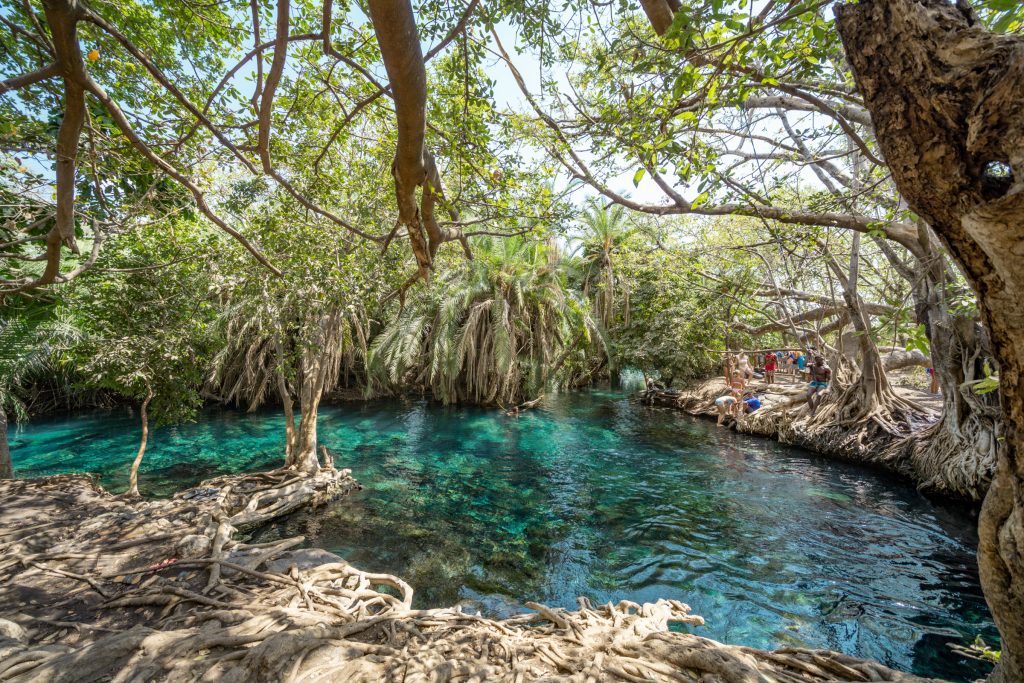
Recommended Tour : Kikuletwa Hot Springs Tour
4. Pack Light
When preparing for your African safari, it’s essential to pack light and efficiently. Keep in mind the baggage allowance on bush planes, as they often have strict weight restrictions. The restrictions also vary by airline. Some allow 15kg (33 lbs), while others allow 20kg (44lbs); some are super strict about hard-sided bags, while others are more lenient. It is definitely worth to investigate in advance.
When packing, choose versatile clothing items that can be easily layered and re-worn. This allows you to maximize your outfit options while minimizing the amount of luggage you need to bring. Plus, some safari camps offer laundry services, so you can refresh your clothes during your stay. I was able to get laundry done mid-trip, so I really only needed a handful of outfits. Plus, you can easily re-wear pants day over day.

5. Plan for Laundry
Speaking of laundry…when it comes to laundry on safari, many hotels offer convenient laundry services to keep your clothes fresh and clean during your adventure. However, it’s important to note that for cultural reasons, the staff do not handle the washing of women’s undergarments, so you’ll need to take care of these items yourselves.
Keep in mind that in more remote or mobile migration camps, laundry facilities might not be readily available, so seize the opportunity to do laundry when it’s offered. I had access to laundry at both of my traditional hotels, but it was not available at the migration camp. Making the most of the available options ensures that you’ll be able to pack minimally and have clean clothing throughout your safari experience.
6. Dress the Part
Dressing the part for a safari is one of the most talked about African safari travel tips. When venturing into the wild, it’s important to dress appropriately to adapt to the environment and weather conditions. Go for lightweight, breathable clothing in neutral colors such as khaki, light grey, light blue, and olive green. These colors help you blend in with the environment. If you’re wondering how in the world to look cute while rocking khaki, don’t worry! I put together a guide on what to wear on safari for women .
Related Post : What to Wear on Safari for Women: 10 Cute Safari Outfit Ideas
Choose long-sleeved shirts and pants to protect yourself from the sun, bugs, and prickly grass. Don’t forget a wide-brimmed hat to shield yourself from the sun’s rays and questionable hair days! Comfortable closed-toe shoes are a must for walking safaris, and I also preferred them even on game drives for whenever I exited the vehicle (bathroom time). Layering is key as temperatures can vary throughout the day, so pack a fleece for chilly mornings or evenings.

7. Prepare for Cold, Heat, Rain, & Sun
Africa’s climate can be unpredictable, so it’s crucial to come prepared for all types of weather conditions. While the days may be warm and sunny, the evenings and early mornings can get quite chilly. Pack a mix of lightweight and warm clothing, including long-sleeved shirts, fleece jackets, and a good pair of comfortable closed-toe shoes. Don’t forget a hat, sunglasses, and sunscreen to protect yourself from the African sun. Additionally, pack a raincoat in case of sudden rain showers.
During my time in Tanzania, I can confirm that I experienced 40 degree swings in temps during a single day, sudden downpours, tons of dust, and plenty of African heat. Being prepared for various weather scenarios ensures that you can fully enjoy your safari adventure, rain or shine.
8. Purchase (or Rent) Quality Camera Gear
Photography plays a significant role in capturing the magic of your African safari adventure. Invest in quality camera gear to ensure you can capture those memorable moments of hippos yawning, lion cubs playing, and rhinos charging across the Serengeti at sunrise (yes, we saw all of that!)
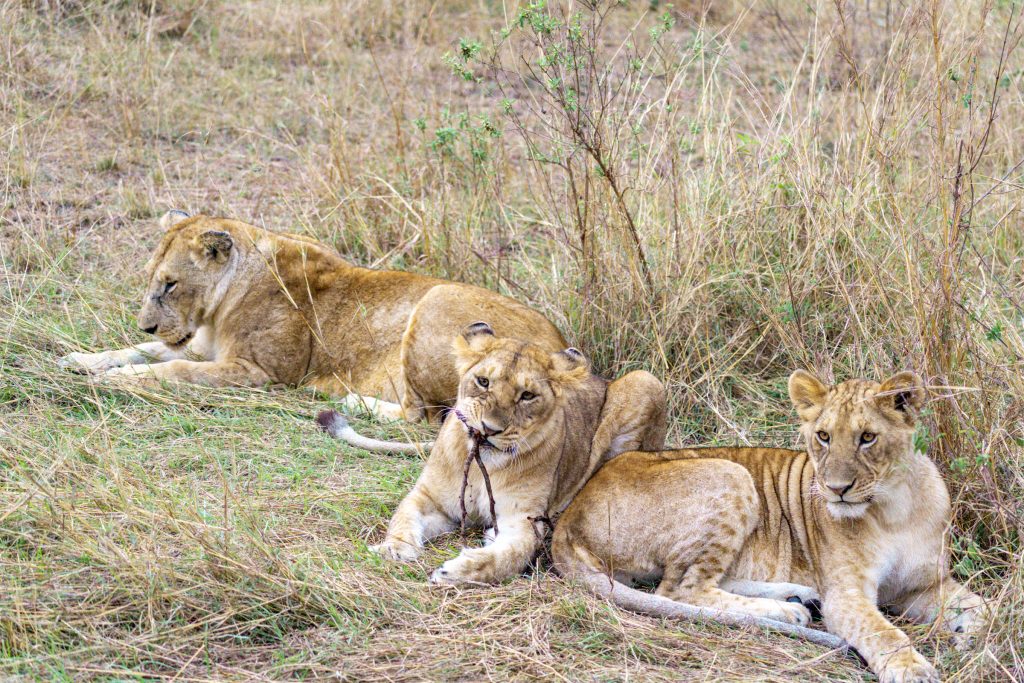
If you don’t have your own equipment, consider renting professional-grade cameras and lenses from reputable providers. Having the right gear will enable you to capture stunning wildlife shots and breathtaking landscapes. You may be tempted to quit your job and become the newest member of the Nat Geo photography team…I know I was! Make sure to familiarize yourself with your equipment before your safari, so you can make the most of every photographic opportunity. Safari photography is very different than my traditional travel photography (people and landscapes), so I’d definitely recommend exploring the best camera settings for safari photography and these African safari photography tips !
Related Post : Best Camera Settings for Safari Photography
9. Take Lots of Photos
Prepare to channel your inner wildlife paparazzi! On the first day of your safari, you might find yourself in a frenzy, snapping away at zebras like a camera-crazed tourist. And that’s perfectly understandable (and definitely what I did)! However, as the days go by and you’ve accumulated numerous wildlife photos, you’ll likely become more selective in snapping pictures. By the last day, the only times a zebra made it onto my camera roll was if it was an adorable baby, all fuzzy and irresistibly cute, and the one time when a zebra walked onto the airport runway in the Serengeti – that was a sight to see!
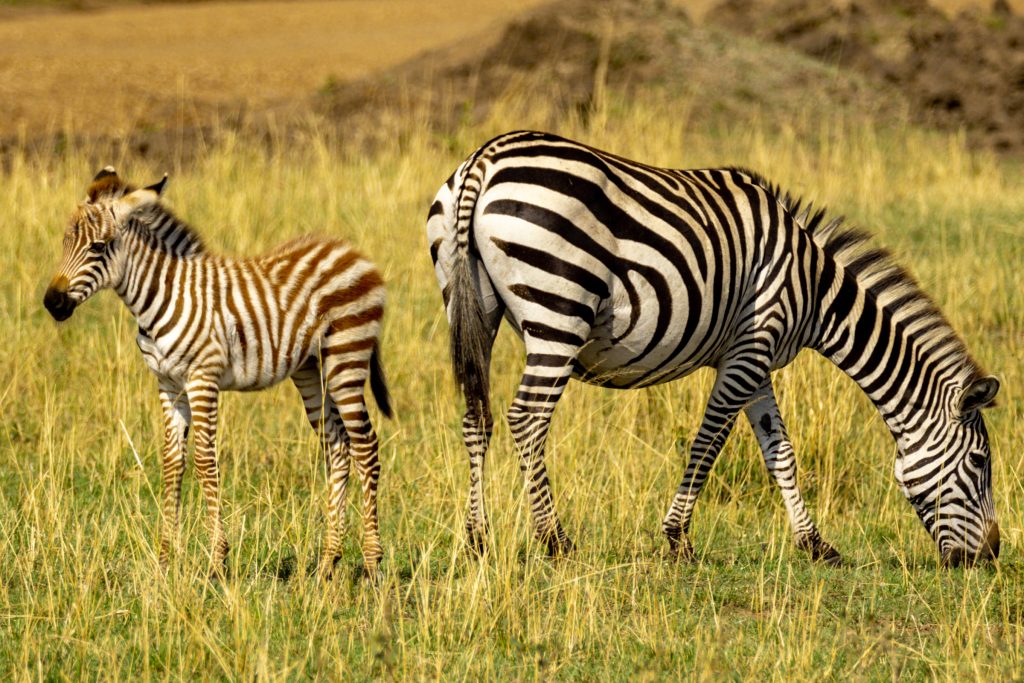
In any case, let your camera lens capture the extraordinary moments, the mischievous antics of wildlife (we got to see two male giraffes in a ridiculous neck-swinging fight over a female giraffe), and the jaw-dropping sunsets over the Serengeti. Get creative, experiment with different angles, and remember to take the time to appreciate the animals in person and not just through your camera’s viewfinder.
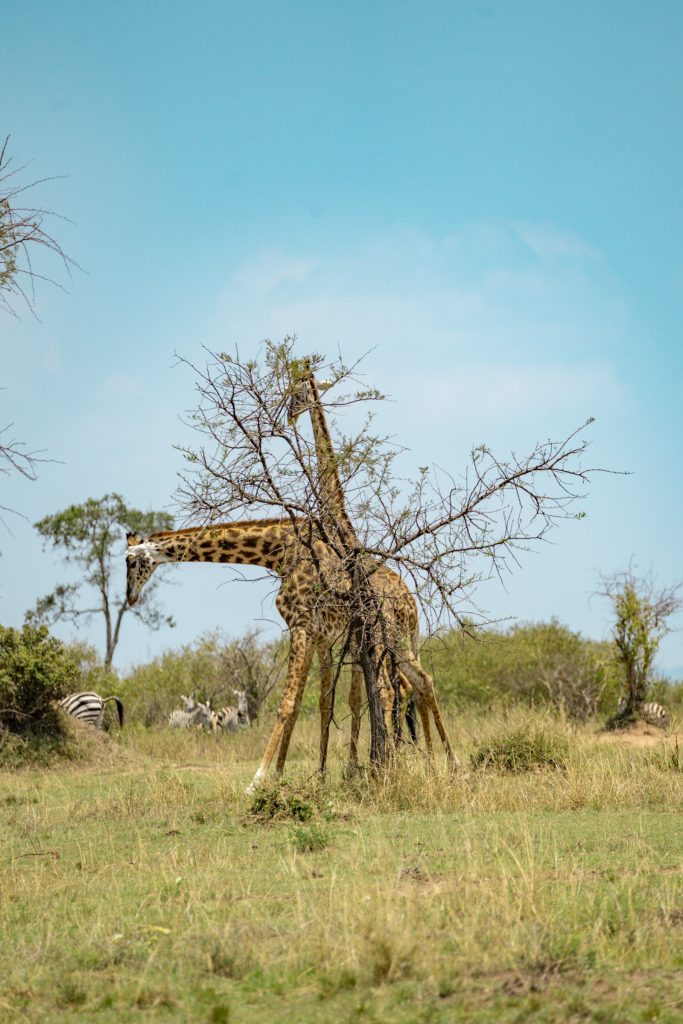
10. Bring Binoculars
Bringing a pair of binoculars on your safari is one of my top African safari travel tips. It allows you to get a closer look at the incredible wildlife that may be far off in the distance. Even with contacts, I have pretty horrendous eyesight, so my binoculars were an absolute lifesaver! We spotted our first lion through the binoculars and caught a good view of a leopard lounging in a tree, as well. Some safaris do provide binoculars for their guests, but it by no means a given, so I would recommend checking in before your safari.
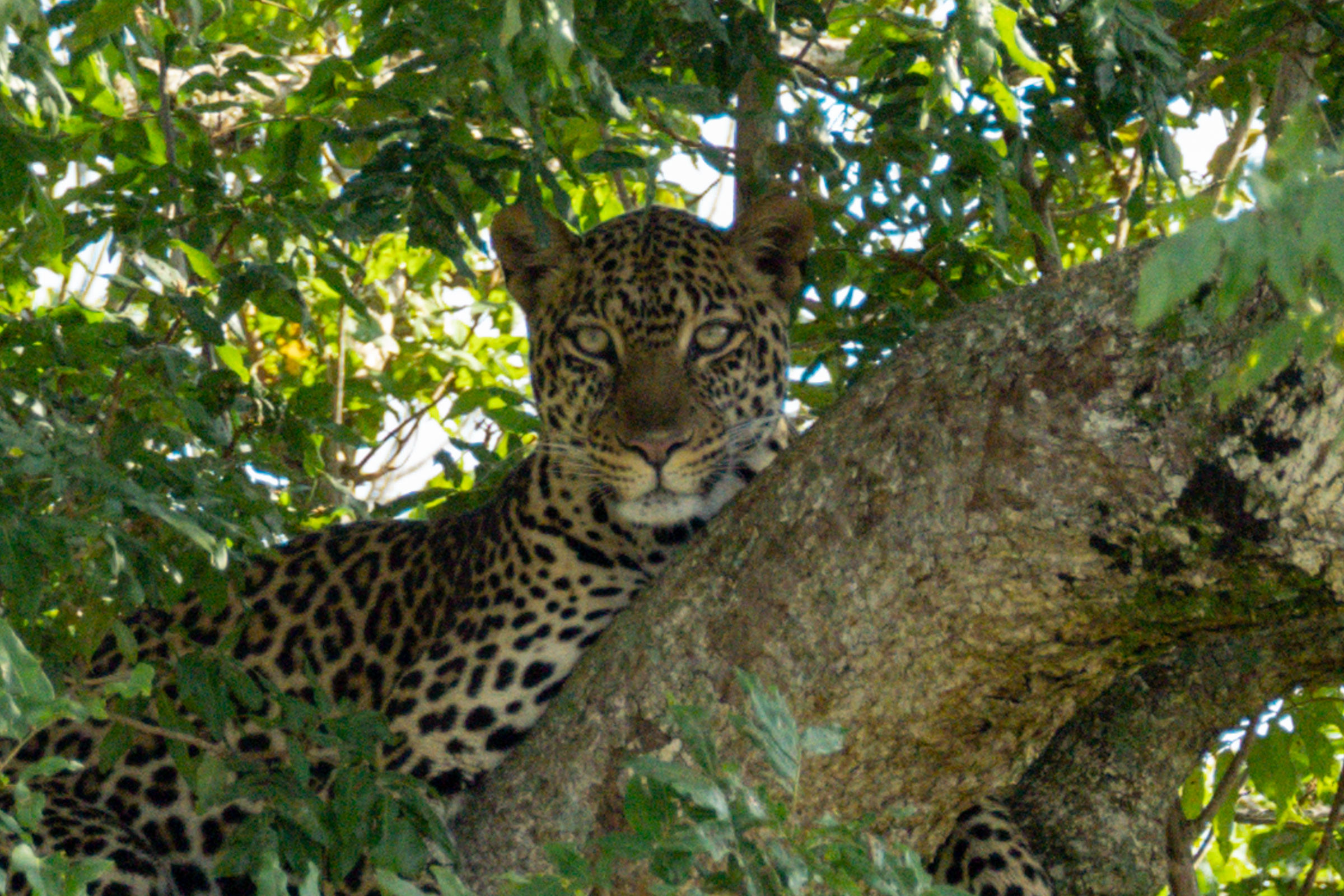
11. Decision Time: Private Guide vs. Group
When planning a safari, one important decision to make is whether to choose a private guide or group safari experience. Group safaris are typically slightly cheaper as the costs are shared among a larger number of participants. However, keep in mind that group safaris typically have fixed departure times and itineraries, which may limit your flexibility. Additionally, you’ll be sharing the safari vehicle with other travelers, all of whom may have different preferences. This can sometimes lead to compromises on the specific sightings or activities you’d like to prioritize. Another aspect to consider is the seating arrangement in the vehicle. With a group safari, you may not always get the best seat for optimal wildlife viewing or photography.
On the other hand, private safaris offer more freedom and flexibility. While they tend to be more expensive, you have the luxury of designing your own itinerary, choosing your preferred departure date and time, and tailoring the experience to your specific interests. You’ll have the vehicle all to your group, ensuring maximum comfort and the freedom to spend as much time as you desire at each sighting. For me, I decided on a private guide so that I could have all of the flexibility in deciding my itinerary. If you are comfortable with the higher budget, I would absolutely recommend this option.
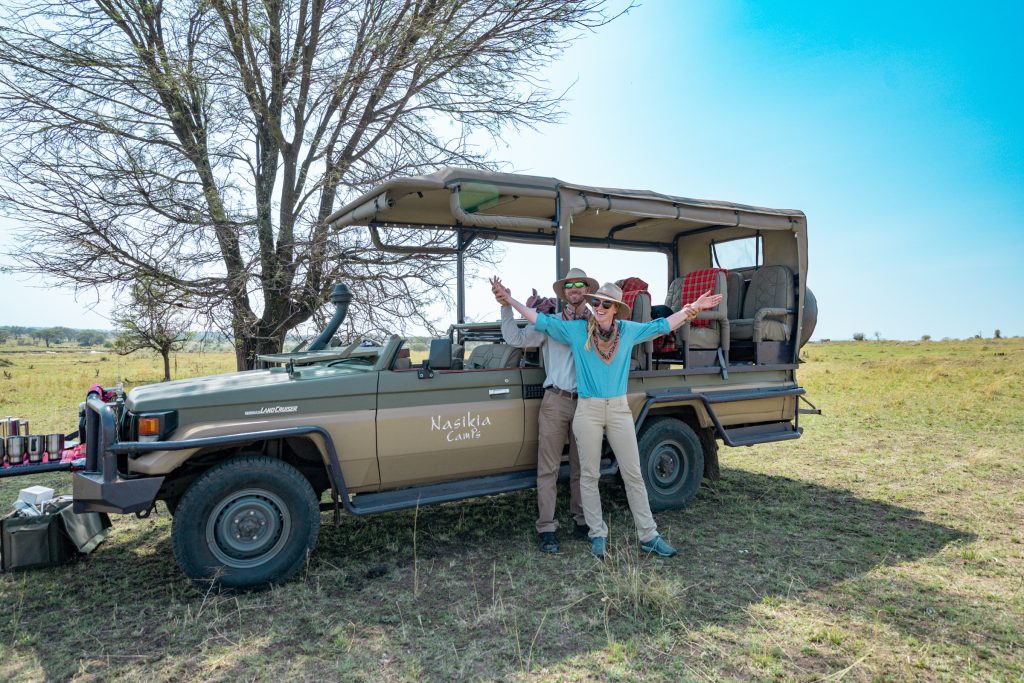
12. Wake Up Early
One of the most thrilling aspects of an African safari is observing wildlife in their natural habitat. Animals are most active during the early morning and evening, making these the prime times for game drives and wildlife viewing. Trust me on this…most times we saw lions during the day, they were stretched out and snoozing.
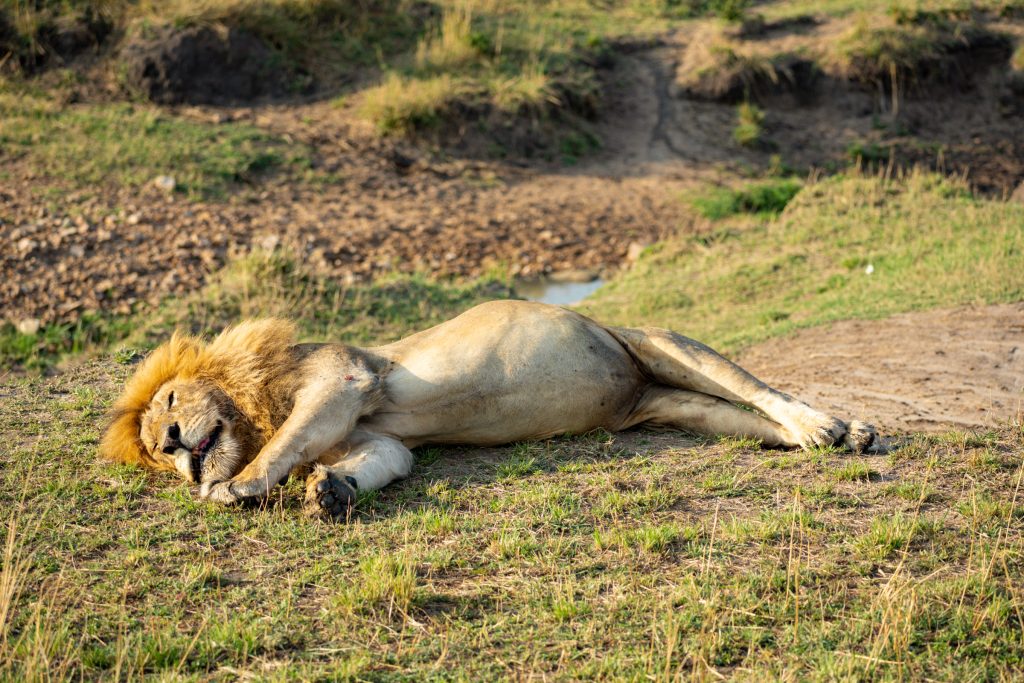
Set your alarm clock and embrace the early wake-up calls. By venturing out at dawn, you’ll have the chance to witness incredible animal behaviors, catch stunning sunrises over the Serengeti, and enjoy the peacefulness of the wilderness before the heat of the day sets in.
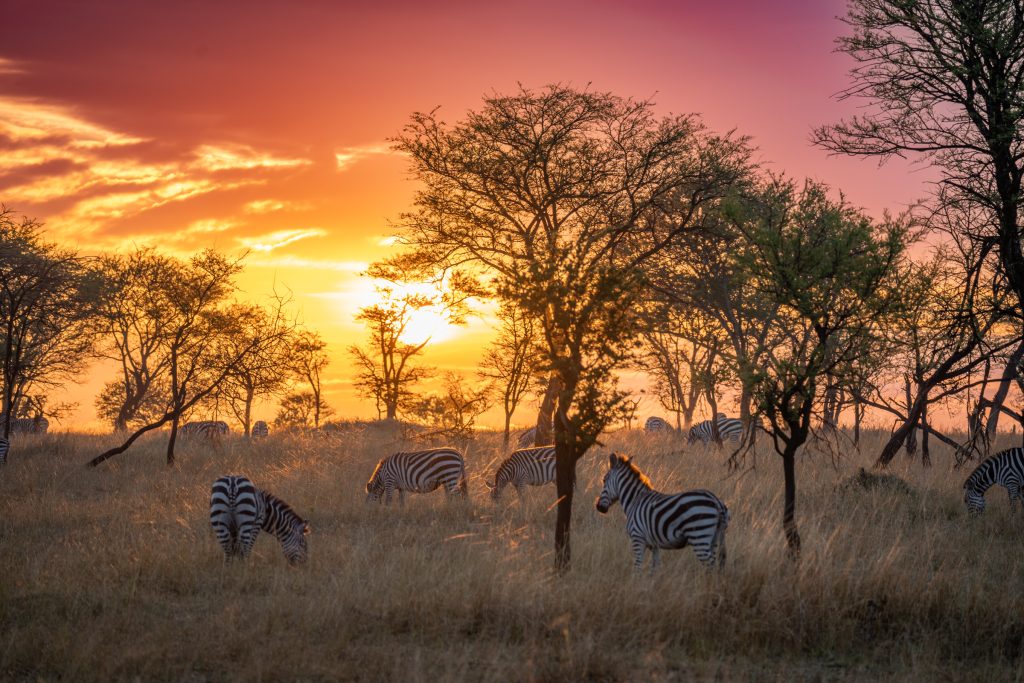
13. Bathroom on Safari
When nature calls on safari, it’s a unique experience that requires a bit of creativity. The bathroom situation in the wilderness is obviously quite different from the comforts of home. To give you an idea…my most common “bathroom” on the Serengeti was behind any number of tall termite mounds.
Remember, your safari guide is there to ensure your safety, and that even extends to bathroom breaks. Before bathroom breaks, they’ll scout the area to make sure it’s clear of any potential danger. Ladies, you might hear your guide suggesting to “pick a flower” as a discreet euphemism, while gentlemen may be asked if they’d like to “check the tires.” It’s all part of the adventure, so embrace the humor and follow their lead. Just remember to respect the environment and leave no trace behind.
14. Prepare for Dust
Dust, the not-so-glamorous companion on your safari adventure. As a contact lens wearer, I quickly learned the art of keeping my eyes protected from the ever-present dust. Carry extra contact lens solution, eye drops, and a spare pair of lenses, just in case. I’d also recommend keeping your sunglasses on – even when it’s not that sunny – they work great as an extra layer of protection for your eyes. A handy bandana is also helpful to pull up over your mouth during particularly dusty patches.
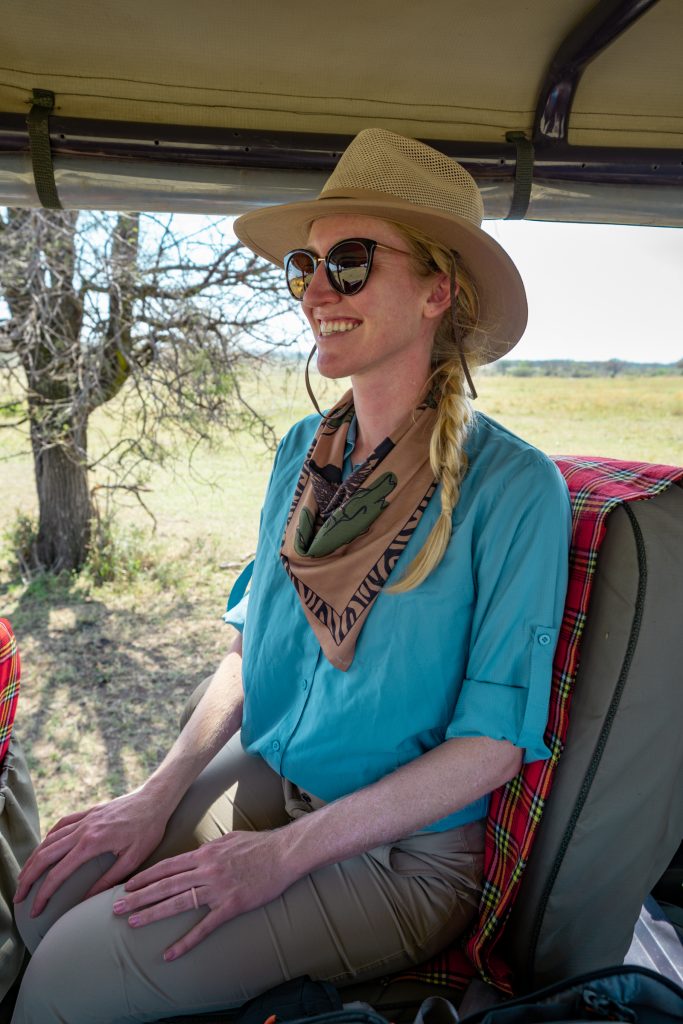
And don’t forget about your camera lenses! Dust has a sneaky way of finding its way onto them, causing potential smudges. Keep a lens cleaning kit in your day bag for quick lens cleaning, and keep your lens cap on when not using the camera. Remember, dust may be inevitable, but with a bit of preparation, you’ll be ready to conquer the dusty safari trails like a pro!
15. Be Medically Prepared
Being medically prepared is one of the key African safari travel tips for first-timers. Before your trip, make sure you visit a travel clinic or consult with your healthcare provider, and check the CDC’s recommendations to ensure you are up to date on any recommended vaccinations.
In addition, make sure to pack some bug spray to protect you from those pesky bugs and potential diseases they may carry. You won’t find a convenient CVS in the heart of the Serengeti, so it’s crucial to pack a well-stocked first-aid kit that includes essential items like band-aids, Cortaid, Advil, Pepto, and any personal medications you may require. Taking these precautions will provide peace of mind and ensure that you’re ready to handle any minor health concerns that may arise during your safari expedition.

Like this post?! How about…
14 Outstanding African Safari Photography Tips
16. Enjoy Sundowners
Ah, the magical time when the sun begins its descent over the Serengeti. It’s the perfect moment to unwind and indulge in a tradition long cherished by safari-goers – the legendary “sundowners.” Picture this: sipping on your favorite beverage, feeling the gentle breeze on your face, and toasting to the day’s wildlife encounters. This was definitely one tradition I could get behind. Cheers to nature’s happy hour!
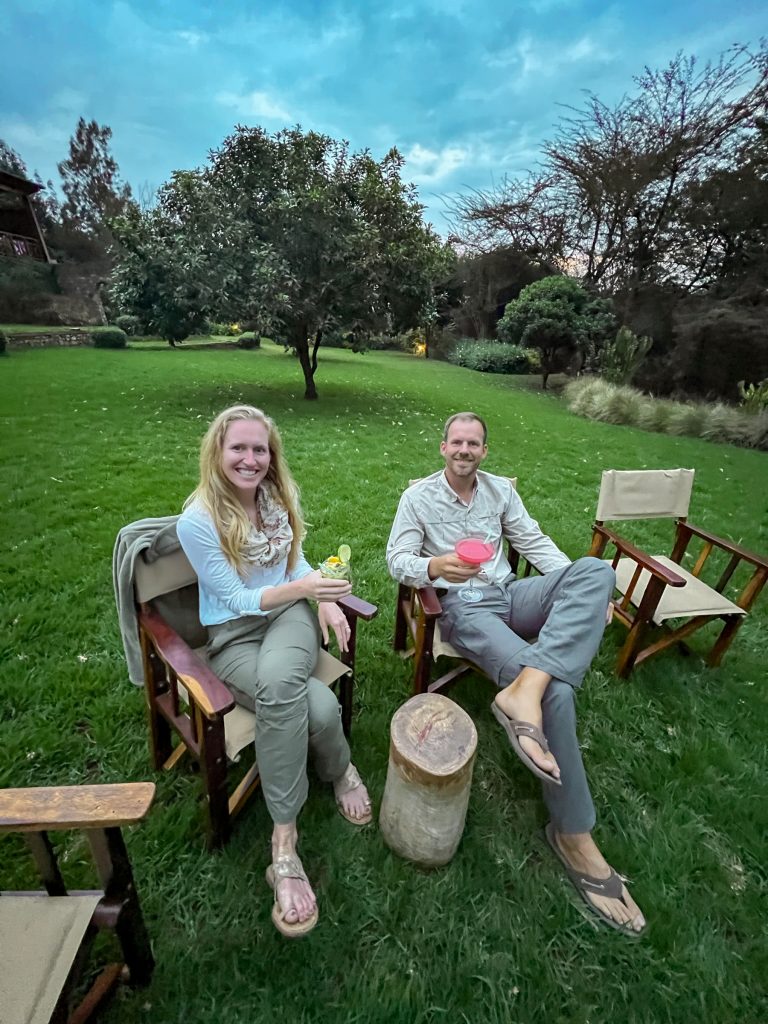
17. Snack Time
Snack time on safari is a delightful surprise that adds an extra touch of magic to your wildlife adventure. During my first game drive in Tarangire National Park, our safari guide announced a break for morning tea and snacks. I was totally unsure of what to expect considering that we were surrounded by water buffalo and in the middle of nowhere. Cue my surprise when we get hot tea, delightful biscuits, and more – all served on a checkered tablecloth! And it wasn’t just our first day…every morning and afternoon that we were out on safari, we were treated to a delightful spread for snack time. I was 100% on board with this custom!
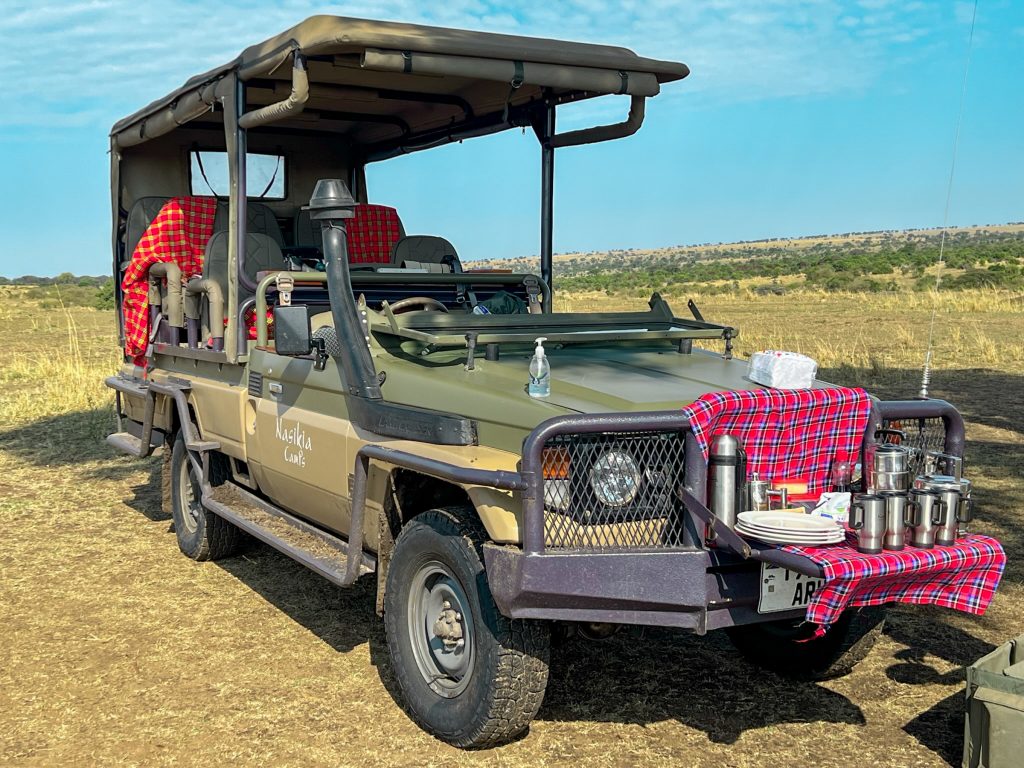
18. Patience is Key
When it comes to safari adventures, patience truly is key. Animals in the wild operate on their own time, and definitely don’t adhere to any schedule. It’s important to embrace this unpredictability and understand that the best sightings often come to those who wait. If you find yourself waiting at a specific spot during your game drive, trust that your guide has a good reason for it. Safari guides are experts in their field and have an uncanny ability to anticipate animal behavior.
To give you an idea…for the wildebeest river crossing (photo below), we waited on and off for nearly six hours! During that time, we would sometimes go and look at other animals, but we never strayed far from the river. We had seen smaller crossings while we were there, but this crossing was on a completely different scale with thousands of wildebeest all crossing at once. The crossing was a huge bucket list item for me, and I am SOOO glad that I had the patience to wait it out. Even if you impatient like me, remember that patience is one of the most important African safari travel tips.
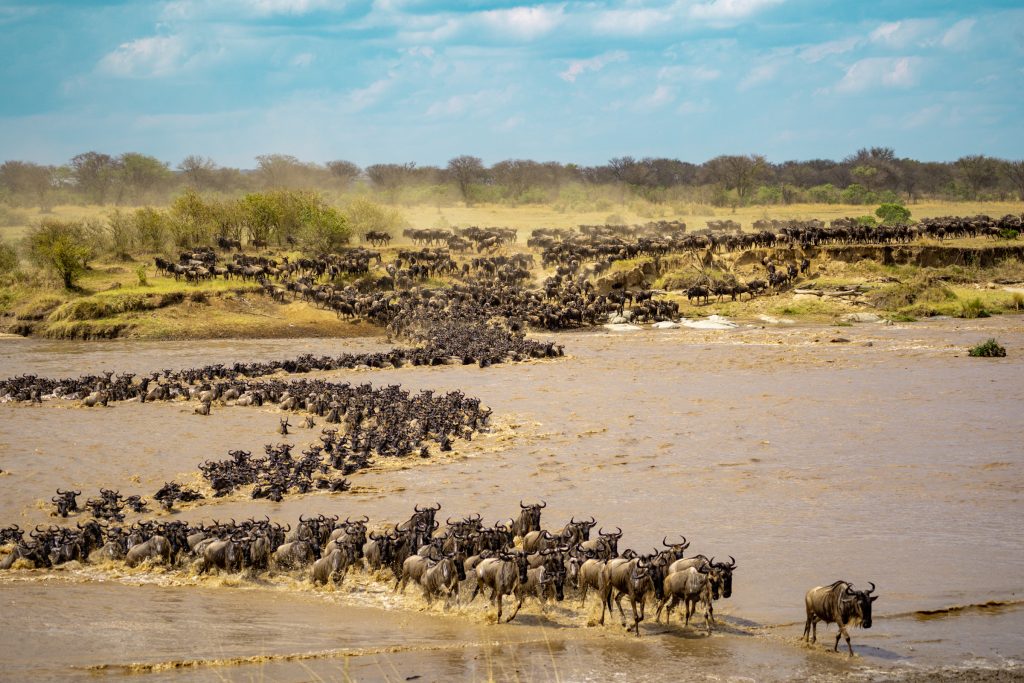
19. Communicate with Your Guide
When on safari, don’t hesitate to ask your guide plenty of questions. They are a wealth of information and have quite literally studied for years to become a guide. However, it’s important to be mindful of your surroundings and respect the environment. You do not want to be “that person” who disrupts the tranquility by loudly calling out or making unnecessary noise at inopportune times. Instead, observe quietly and engage with your guide at appropriate moments.
Aside from learning from your guide, you also need to respect your guide and follow all safety rules. Respecting the instructions of your guide ensures that you navigate the safari experience in a way that minimizes potential risks. Safari guides are well-versed in reading animal behavior and will maintain a safe distance to ensure that the animals’ natural behavior is not disturbed while still working to provide you the best safari experience possible. Remember that we are guests and need to respect both the animals and their environment.
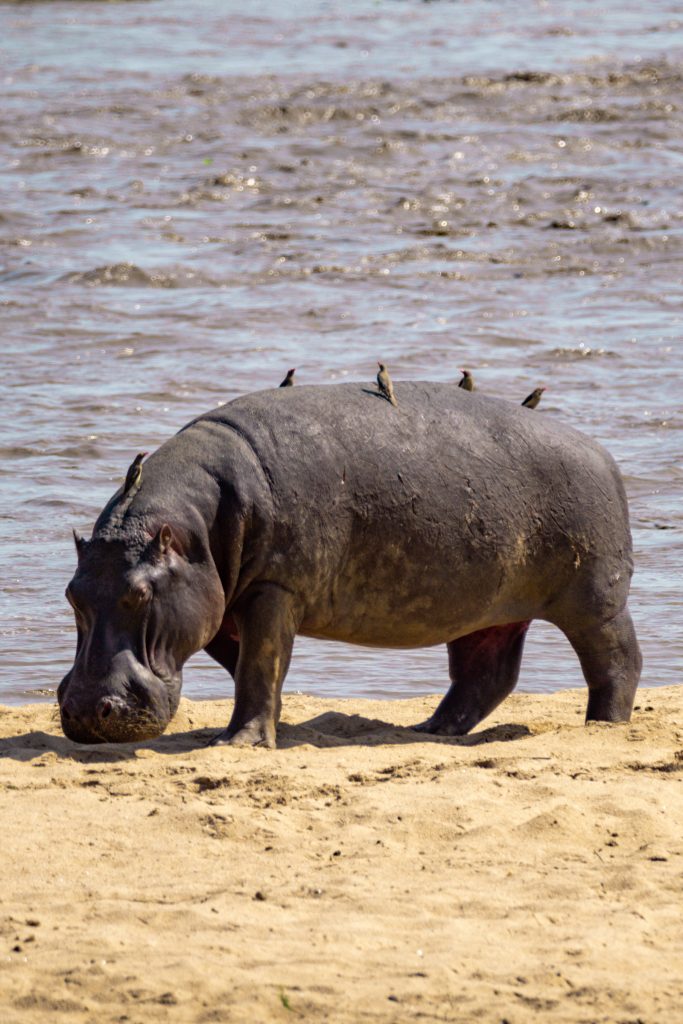
20. Bring Cash for Tips
The last of your African safari travel tips is to bring plenty of cash to tip! Tipping on safari is an important aspect, as it helps show appreciation for the exceptional service provided by the staff. While tipping practices can vary between countries and lodges, it’s highly recommended to have some cash on hand to tip the guides, drivers, porters, camp staff, etc. Based on your destination and level of stay, I’d look into tipping suggestions to ensure you’re offering an appropriate amount. Remember, tipping is not mandatory, but it’s a gesture of gratitude that can make a positive impact on the hardworking individuals who make your safari experience truly remarkable.
That wraps up my top 20 African safari travel tips for first-timers. With these African safari travel tips in mind, you’ll be well-prepared to make the most of your adventure. From choosing the right time to go, packing the essentials, and embracing the thrill of wildlife encounters, your journey into the wild promises unforgettable moments and treasured memories. Remember, being a first-timer is an opportunity to embrace the unknown and let the wonders of the safari unfold before your eyes. Happy safari-ing!
For some more travel inspiration, check out some of the posts below!
Tanzania : Kikuletwa Hot Springs: 14+ Things to Know Before You Go Safari Photography Camera Settings : Best Camera Settings for Safari Photography Safari Photography Tips: 14 Outstanding African Safari Photography Tips Safari Outfits: What to Wear on Safari for Women: 10 Cute Outfit Ideas Tented Safari Camps : Top 13 Things You Always Wanted to Know About Tented Camps Tanzania Itinerary : Tanzania 7 Day Itinerary
You May Also Enjoy:

Ziplines, Caves, and Ancient Ruins – This is San Ignacio!
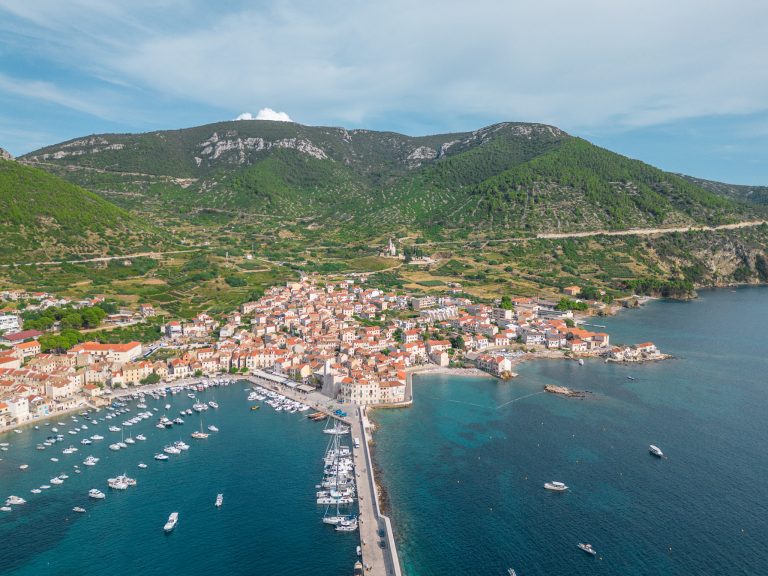
12 Best Instagram Photo Spots in Komiza on Vis Island, Croatia
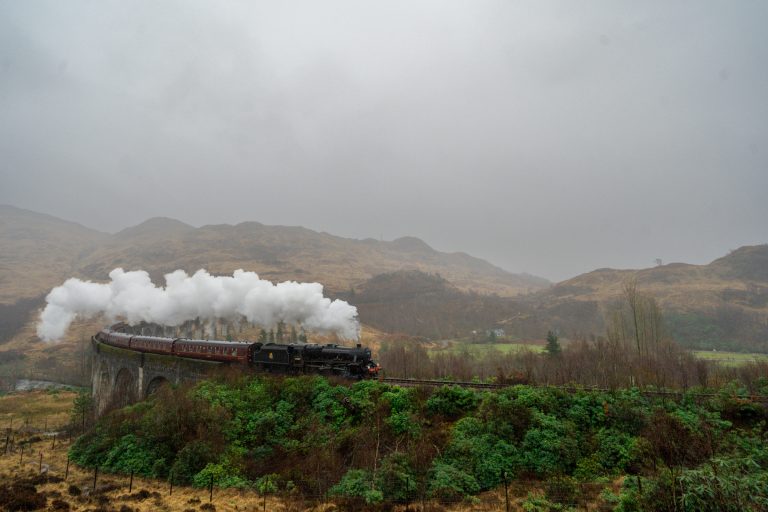
Chasing the Hogwarts Express: See the Magical Glenfinnan Viaduct Harry Potter Train
Pin for later:.
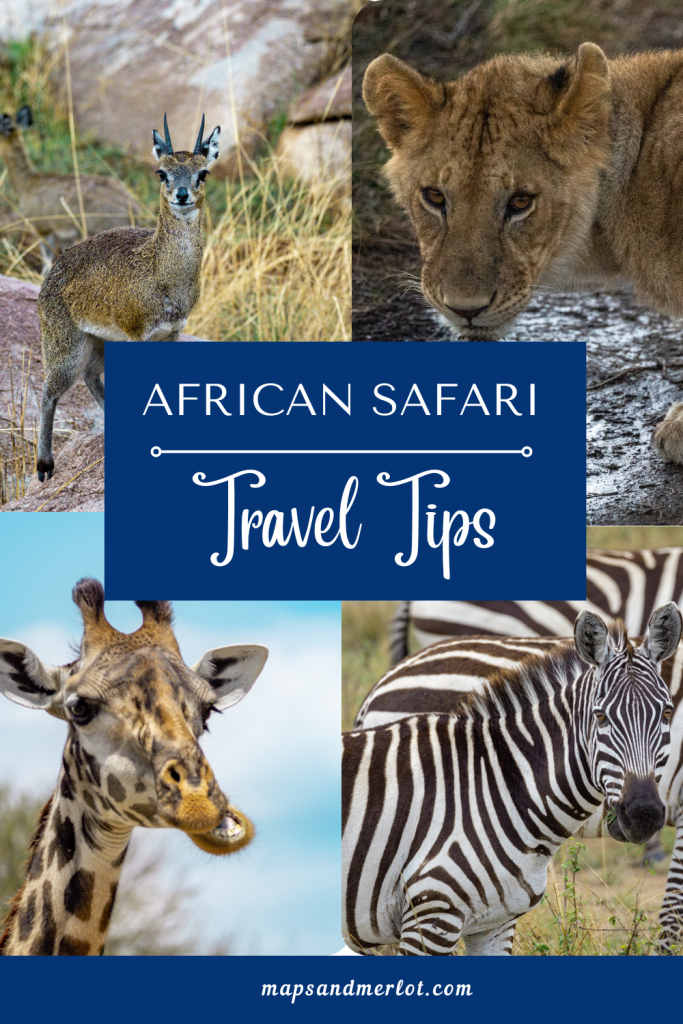
Where to go on your first safari in Africa

Feb 20, 2024 • 17 min read
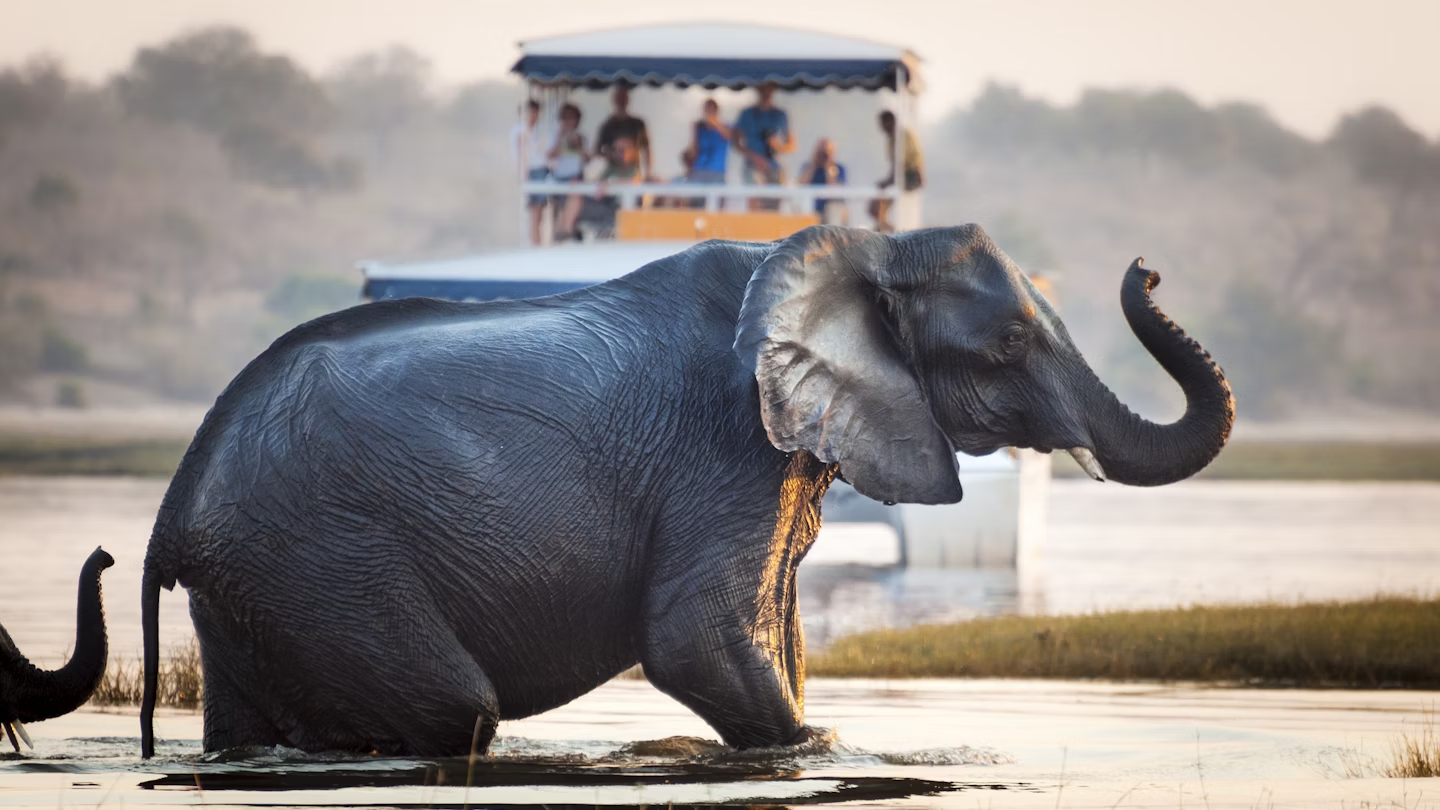
Botswana is an excellent choice for a well-rounded, first-time safari – though it can be a pricey one © Getty Images
So you want to see a lion in the wild? Terrific. Now comes the tricky part: choosing where to go on your first safari.
Which countries offer the easiest introduction to the continent for first-time travelers? Which countries are best for wildlife?
Let us help you cut through the overwhelming options and plan your first safari to Africa for blockbuster wildlife watching – without feeling overwhelmed.

Planning a safari in Botswana
Why botswana.
Water-based safaris, exclusivity, privacy and high-quality camps in captivating areas: Botswana is one of Africa’s premier wildlife-watching destinations. Its prolific wildlife inhabits extraordinary landscapes, including the Chobe River, the Okavango Delta and the salt pans of Makgadikgadi .
The easiest choice for your trip, Chobe National Park is home to the world’s largest concentration of elephants, as well as a host of easy-to-spot big cats, buffaloes, giraffes and zebras, making it perfect for first-timers. The best way to see Africa’s elephant capital is to board a boat and cruise the Chobe River’s wildlife-rich shores. From here, you can travel into the Okavango Delta, where you can splurge on a luxury safari and take a mokoro (dugout canoe) through the wetlands, before forging on into the Makgadikgadi salt pans to mingle with meerkats.
Botswana’s appeal and ease, however, come with a (big) caveat: the cost. To avoid the pitfalls of mass tourism, most luxury lodges and camps lie in concession areas rented out by the government to enforce a high-value, low-volume responsible-tourism strategy. The best reserves sit in the swamps of the Okavango Delta, and visitors fly in on small bush planes from Maun or Kasane. Mobile safaris – group trips that take you from site to site, often involving camping along the way – are a more cost-effective alternative: you can combine time in Moremi Game Reserve with Chobe National Park.
Best time to visit for a safari in Botswana
The high and dry season from June to October is the best wildlife-watching time , and also when water levels are generally at their highest in the Okavango Delta, allowing you to glide along the channels in a mokoro .
Where to stay on safari in Botswana
In and around Chobe National Park, we recommend Chobe Game Lodge , Chobe Safari Lodge and Chobe Bakwena , with Chobe Game Lodge being the only one inside the park. For photographers, Pangolin Chobe Hotel has specialist boats with swivel seats and gimbal mounts to snap that Attenborough moment on the Chobe River.
You can combine Chobe with the Okavango Delta through scheduled group mobile safaris with Bush Ways or Letaka . If you’re after a luxury experience in an exceptionally wild, isolated area, Mombo Camp is probably the Okavango’s most exclusive and legendary lodge, with predators galore (and a pretty price tag). Mma Dinare Camp (which offers affordable road transfers), 4 Rivers Camp , Shinde Camp and Camp Moremi are well situated for spotting excellent big game. Xugana Island Lodge , Setari Camp and Mopiri Camp are wonderful for experiencing the waterways, and offer fishing and birding opportunities by boat. Mogotlho Safari Lodge is also accessible for self-drivers, and occupies a lovely position on the Khwai River near Mababe. Want a more adventurous, budget-friendly option? Try a fully catered, accommodated mokoro campout excursion that departs from Sitatunga Camp , south of Maun.
Trips to meet the cute meerkats of the Makgadikgadi salt pans can be arranged through San Camp, Jack’s Camp or Camp Kalahari, with Planet Baobab as the best budget-friendly option with self-drive access.
Budgeting and costs for a safari in Botswana
Stays at isolated camps in the Okavango Delta start at roughly $650 per person, per night and can go up to an eye-watering $4000 a night. At approximately $300, Chobe National Park lodges are more affordable – so stretch out your days here to keep costs down. For better pricing on accommodations, travel during the shoulder season (April to May and October to November). Finally, check the distance between your luxury lodge and Maun to reduce the return-ticket cost. Some camps offer road transfers or boating access between camps to minimize travel costs.

Planning a safari in Kenya
Kenya ’s wildlife offering is outstanding, with the Great Migration in particular at the top of many bucket lists – so it’s no surprise that safaris have been a thing in Kenya since the very concept was invented (indeed, safari translates to “journey” in Swahili). Do keep in mind, though, that this track record does make Kenya one of the busiest, most popular wildlife destinations on the continent.
A renowned annual phenomenon, the Great Migration sees millions of wildebeest and zebras cross the Mara River from the Serengeti in southern Tanzania into Kenya’s Masai Mara National Reserve . The country’s semi-nomadic Maasai communities and their time-honored warrior traditions are another source of fascination. Visitors can support community-powered tourism by visiting the private reserves surrounding the Mara, which are leased to different safari companies. A guided bush walk with a Maasai warrior will let you experience this culture’s deep connection with the land.
The main safari circuit couples Lake Nakuru with the Masai Mara and Amboseli (where Mt Kilimanjaro provides a staggering backdrop). Tsavo West , Tsavo East and Samburu are popular add-ons, if you have extra time. Any combination of these parks should ensure ample sightings of big cats, plenty of elephants, a few rhinos and all of the plains animals, such as buffaloes, giraffes, zebras, and all manner of gazelle and antelope species. Want even more? Extend your stay by another week and scale Mt Kenya , Africa’s second-highest peak (after Kilimanjaro).
Most travelers just pass through Nairobi , staying long enough to visit Nairobi National Park . An extraordinarily well-stocked park on the cusp of one of Africa’s largest cities and easily accessible, Kenya’s original game reserve has wildlife in abundance, from lions, leopards, and buffaloes to the endangered black rhino and around 400 species of birdlife.
Generally, Kenya is viewed as a better choice for family safaris, those on a budget and those on a tight timeline.
Best time to visit for a safari in Kenya
July to October and January to February are the best times to see the Great Migration, when a million-plus wildebeest, along with hundreds of thousands of zebras and gazelles, cross the crocodile-infested Mara River to graze on the lush grasses of the Masai Mara. With unrestricted visitor numbers, some areas can get crowded.
Where to stay on safari in Kenya
Kenya has hundreds of excellent lodges and tented camps, standards of service from local staff are generally high, and tour operators are experts at the logistics of moving between national parks for each leg of your safari itinerary.
Cottar’s 1920s Camp has entertained guests in high style for over 100 years, while “gentle on the earth” takes on a whole new meaning at Emboo River Camp , whose team will have you floating through the grasslands of the Masai Mara in the region’s first electric game drive vehicles.
Good value but still luxurious, Ol Tukai Lodge sits within Amboseli Park, with views of Kilimanjaro from the bar; nearby Amboseli Serena Safari Lodge is a comfortable family-friendly option. In Nairobi, Giraffe Manor provides a memorable breakfast spread before a visit to the city’s park; all accommodations in the upmarket Karen and Langata areas are close to the main entrance.
Budgeting and costs for a safari in Kenya
Masai Mara National Reserve is the most wallet-friendly location for seeing the wildebeest migration. Despite having a shorter migration season, Kenya has more flights, more tourists, stiffer competition and a greater variety of affordable accommodations than next-door Tanzania. Expect to pay anything from $150 to $1000 per person, per night.
For a cheaper safari, book between the short and long rains (January to March), when prices are usually lower than during the peak season. Nairobi National Park charges $40 to non-residents for entry, while admission to Masai Mara is $80 for 24 hours if you stay outside the reserve, and $70 if you stay inside.

Planning a safari in Namibia
Why namibia.
Two reasons: self-driving independence and dramatic desert scenery. While a 4WD African safari is always an ambitious undertaking, Namibia has good roads, well-equipped campsites and reasonably priced rental vehicles. This is one of the easiest Southern African countries to explore from the driver’s seat.
The classic circuit starts in Windhoek , where you’ll rent a fully equipped 4WD camper van or a decent gravel-road car. From there, you’ll head to Sossusvlei in the Namib Desert for incredible vistas, circle up to Swakopmund for coastal adventures and end at Etosha National Park , where elephants, rhinos and giraffes strut their stuff.
Etosha is Namibia’s version of South Africa’s Kruger National Park, with roads and facilities suitable for a self-driving budget safari. Each public camp overlooks a busy water hole, where game moves in and out to drink during the dry season. The camp is floodlit by night, which means you won’t need to leave once you settle in.
Best time to visit for a safari in Namibia
Etosha is well-known for its productive water holes, and peak game viewing is from June to October, when wildlife flocks to these oases dotted throughout the park. This is also a cooler time of year to climb the dramatic dunes such as Dune 45 at Sossusvlei.
Where to stay on safari in Namibia
Arranging everything through the Gondwana Collection is hands-down the easiest and best way to organize a self-driving safari. This group has a portfolio of accommodations in all the key tourist spots, ranging from well-serviced campsites to glamping tents and swank lodges filled with character. Favorites include the quirky Desert Grace and Namib Dune Star Camp (with its alfresco beds) near Sossusvlei, and The Delight in Swakopmund. A sister company, Namibia2Go , offers car rentals with comprehensive insurance.
As an alternative, you can book campsites and chalets inside the parks with the government-run Namibia Wildlife Resorts . Okaukuejo Rest Camp lies inside the perimeter of Etosha and is the place to watch at the water hole.
Budgeting and costs for a safari in Namibia
At about $800, a full week’s vehicle rental is cheaper than a single night’s stay at a luxury lodge in the Okavango Delta. Due to the vast distances between destinations in Namibia, however, fuel expenses can add up fast. National parks and private campsites offer affordable camping fees, though luxury accommodations will (understandably) be more expensive. For camping, expect to pay $20 to $50 per person, per night for camping; for lodges, $100 to $300.

Planning a safari in South Africa
Why south africa.
Expect bush, beach and fine wine. From iconic Kruger National Park to the picturesque landscapes of KwaZulu-Natal , South Africa offers a safari experience that caters to all levels of adventurers.
Kruger is the easiest and most rewarding safari destination for first-timers and budget travelers. You can see the Big Five (lions, leopards, rhinos, elephants and buffaloes), as well as cheetahs, giraffes, African wild dogs and hundreds of bird species. Drive the park’s paved roads yourself if you’re on a budget, or visit private reserves like Sabi Sands or Thornybush for exclusive guided experiences, plus a better chance to see the Big Five in a short period.
Lesser-known reserves in KwaZulu-Natal are equally impressive. Hluhluwe-iMfolozi is just as accessible as Kruger from the city of Durban , and has excellent facilities for travelers on all budgets; expect to spot rhinos, elephants, buffaloes, zebras, giraffes and wildebeest. (The big cats are a little more challenging to see here.) Nearby Phinda Private Game Reserve offers stunning high-end stays – plus the possibility of a beach day or scuba diving at Sodwana Bay .
Madikwe Game Reserve in North West Province is close to the Botswana border and a four-hour drive from Johannesburg , making it popular for South Africans looking for a safari. It’s also a malaria-free option for families with young children.
Combine any of these safari parks with a flight south to Cape Town , and you’ll add fine wine, world-class restaurants and a seaside safari – visiting the African penguins of Boulders Beach – to your itinerary.
Best time to visit for a safari in South Africa
While South Africa is a year-round destination , most visitors love the cooler, dry season between May and August. During these months, wildlife is easier to spot as vegetation is more sparse and animals gather around water holes.
Where to stay on safari in South Africa
There are plenty of affordable self-catering rest camps in Kruger National Park and Hluhluwe-iMfolozi run by SANParks , the government parks agency. Kruger’s southern zone is prime game-viewing territory, with Skukuza , Lower Sabie and Letaba rest camps all favorites. Hilltop Camp in Hluhluwe-iMfolozi has terrific views, while Rhino Ridge Safari Lodge is a superb, privately run option that supports the local community.
Plush camps and lodges in the private reserves come with highly trained guides who can take you out on foot or by vehicle. You can’t go wrong at Saseka in Thornybush, Dulini in Sabi Sands, Tanda Tula in Timbavati , Jaci’s Safari Lodge in Madikwe or any of the &Beyond accommodations in Phinda.
Budgeting and costs for a safari in South Africa
Rates range from $100 to $200 per person, per night in government-run camps. Mid-range prices start at $300 to $700 per person, per night, with a corresponding bump in accommodation and guiding quality.

Planning a safari in Tanzania
Why tanzania.
Limitless plains, the epic migration and relaxing dips in the Indian Ocean. Tanzania ’s northern safari circuit includes the amazing Serengeti National Park and Ngorongoro Crater . Exploring these places for 10 days to two weeks is a sure way to fall in love with Africa. You should consider adding a few days on the island of Zanzibar (officially called Unguja) to make your dream trip even more memorable.
Tanzania and Kenya share similarities, both having plentiful wildlife parks and excellent safari operators. Tanzania’s vibe, though, is generally less stressful – perhaps due to the fact that the Serengeti is nearly 10 times bigger than Kenya’s Masai Mara, offering endless horizons and greater habitat variety.
In the heart of the Serengeti, the Seronera River provides big-cat and herbivore sightings year round, making it popular with visitors. Kogatende and Lamai, on the Mara River, are ideal for observing river crossings – with fewer tourists. Private reserves such as Grumeti allow viewings of the migration without the crowds (and for a price).
The Ngorongoro Crater is only a short drive to the east from the Serengeti. In this giant collapsed volcano (or caldera), animals like lions, elephants and black rhinos are enclosed as they prowl a complete ecosystem of pretty plains and dramatic forests. Note that such assets do draw the crowds in peak season.
Best time to visit for a safari in Tanzania
Plan a visit between January and March to witness the migration of wildebeest – and their newborns – passing through the Ngorongoro and Ndutu regions. (Get as early a start as possible to avoid day-trippers.) The best time to witness the famous wildebeest river crossings in the Serengeti is during the peak season, from July to August.
Where to stay on safari in Tanzania
Serengeti Serena Safari Lodge is an upmarket accommodation inspired by traditional Tanzanian architecture; its popular mobile-safari offering is Kiota Camp. Run entirely by women, Dunia Camp is a luxury tented property situated in prime lion territory. Ngorongoro Serena Safari Lodge is a great value-for-money permanent lodge conveniently located near the entrance to the Ngorongoro Crater. For an even more budget-friendly option, consider Bougainvillea Safari Lodge . For a different kind of stay, book a stay Gibb’s Farm , which is situated on a working coffee farm and offers campfire storytelling and other fun extras.
On the coast, Chumbe Island in Zanzibar/Unguja is a highly rated, ecofriendly property that offers sensational snorkeling in a protected marine reserve. In the historic heart of Stone Town , the best-value stay is Zanzibar Coffee House , dating from the 19th century.
Budgeting and costs for a safari in Tanzania
Expect to pay anything from $250 to $950 per room, per night, during your stay in Tanzania. Entry fees at Serengeti National Park for foreign tourists are $70 (peak season) and $60 (low season). To visit the Ngorongoro Crater, you’ll pay $250 for a vehicle, in addition to the same entry fee. These fees are typically included in organized safari packages.
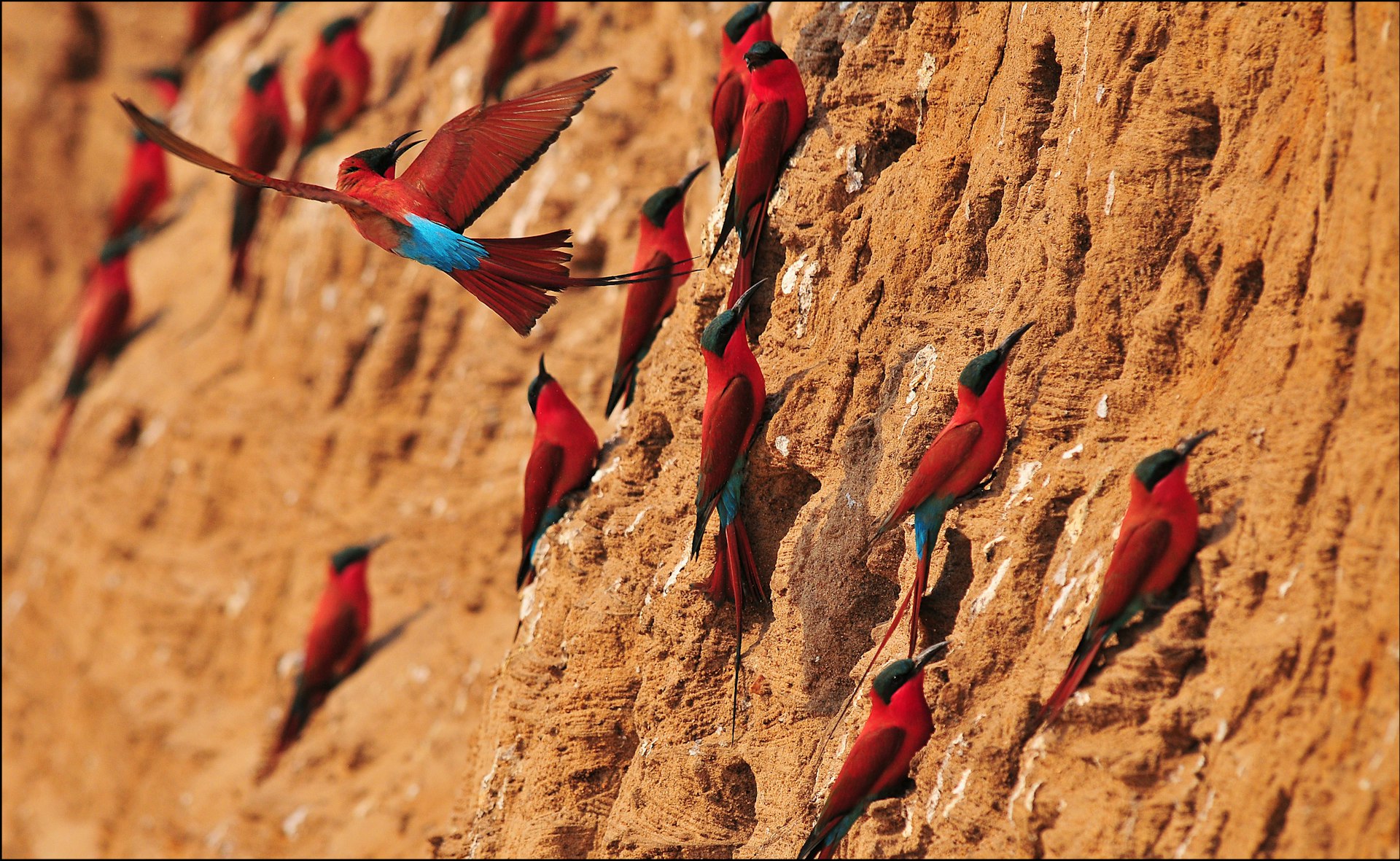
Planning a safari in Zambia
Why zambia.
Track rhinos, witness an awe-inspiring cascade and join a walking safari to experience nature up close. Indeed, Zambia is celebrated worldwide as the birthplace of the safari on foot, during which, under the guidance of two armed rangers, rhino tracking in nearby Mosi-oa-Tunya National Park will bring you close to these magnificent animals – only a taste of what’s to come at South Luangwa.
Livingstone , the tourist capital of Zambia, lets you gaze at another (non-living) marvel: mighty Mosi-oa-Tunya, better known as Victoria Falls . If the 935 cu meters (33,000 cu ft) of water that pours over the falls each second is not heart-pumping enough, there are plenty of other thrilling activities to enjoy , such as white-water rafting on the Zambezi River and bungee jumping (also available on the Zimbabwe side of Victoria Falls). During July and August, you can even take a refreshing dip in the natural infinity pool at the edge of the falls.
Several small and rustic camps in the Luangwa Valley cater just to walking safaris – a thrilling alternative to traditional game drives. These camps are mainly located in South Luangwa National Park .
Best time to visit for a safari in Zambia
Peak game viewing is from June to October, and Victoria Falls is at its best on the Zambia side from March to May.
Where to stay on safari in Zambia
Flatdogs Camp in South Luangwa National Park offers family-friendly luxury. In Livingstone, Jollyboys Backpackers provides a vibey base from which to explore town. The Victoria Falls Waterfront provides a free shuttle to the main event – but if you want to stay at the falls with unlimited access, the swish Royal Livingstone Resort is top-notch; the three-star Avani Victoria Falls Resort is next door.
Green Safaris operates a great circuit of camps in Zambia if you want to combine Victoria Falls with South Luangwa. Live the Robinson Crusoe life at Sindabezi Island Lodge on the Zambezi, and then head into the bush at Shawa Luangwa Camp . You can’t go wrong with walking-safari operators Time + Tide (its Kakuli is a classic camp that’s been open since 1950), or Robin Pope .
Budgeting and costs for a safari in Zambia
Consider getting the KAZA UniVisa , a special $50 pass that allows for unlimited crossings between Zambia and Zimbabwe, plus a one-day trip to Botswana (via the Kazungula border crossing), within 30 days. Budget $250 to $700 per person, per night for lodging.
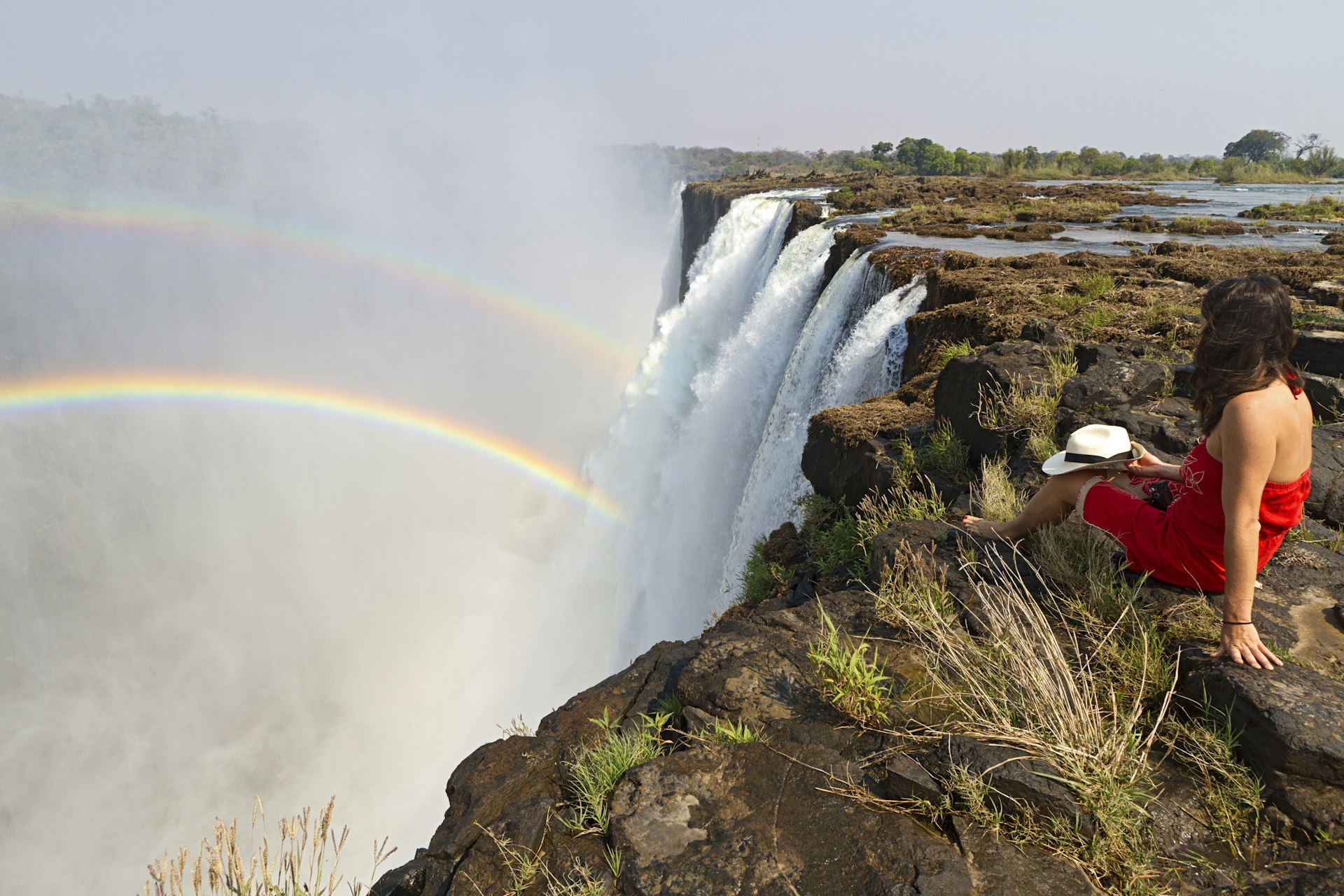
Planning a safari in Zimbabwe
Why zimbabwe.
The adventurous choice for a first-time safari, Zimbabwe has arguably the best guides in Africa. The easiest way to experience it all? Spend three days in Victoria Falls. Since it’s one of the country’s most popular tourist towns, you’ll find plenty to see, do and eat.
The meandering rainforest walkway in Zimbabwe is where the majority of Victoria Falls viewpoints lie. This is a better option for experiencing the falls during during the dry season (May to October), when water levels on the Zambian side lessen. On some evenings and during the full moon, Victoria Falls National Park in Zimbabwe remains open at night for dazzling stargazing.
After a day of adrenaline-fueled bungee jumping, white-water rafting, zip-lining or hovering in a helicopter above Batoka Gorge, afternoon tea at the Victoria Falls Hotel , served every day between 3pm and 6pm, offers some refined relaxation, as you share a tiered stand of pretty sandwiches and delicate pastries beside the manicured lawns. If this lies beyond your budget, enjoy a simple gin-and-tonic sundowner – or head to the Wild Horizons Lookout Café .
The wildlife around here is less prolific than nearby Chobe National Park in Botswana (which you can visit on a day trip or easily combine with Victoria Falls). Yet a boat cruise allows for spottings of hippos, crocodiles and the occasional elephant. A 45-minute flight or two-hour drive away, Hwange National Park is where you’ll find bigger game.
Best time to visit for a safari in Zimbabwe
There is fantastic wildlife viewing during the dry months, from May to October. Victoria Falls is at its peak from March to May.
Where to stay on safari in Zimbabwe
Victoria Falls Safari Lodge sits on a ridge and overlooks a water hole frequented by buffaloes and other beasts. Nkosi Guest Lodge is a pretty, upmarket inn, while Ilala Lodge Hotel is just a 10-minute walk from Victoria Falls. The Victoria Falls Hotel, the iconic grande dame, offers perhaps the best views. Further afield, you can ensconce yourself in the bush at Mpala Jena , about 40km (25 miles) upstream. In Hwange, The Hide , Camp Hwange and Somalisa are all visitor favorites.
Budgeting and costs for a safari in Zimbabwe
Entry to Victoria Falls is $50. With the wide range of accommodation options, you can spend $150 to $700 per person, per night.
This article was first published October 2019 and updated February 2024
Explore related stories
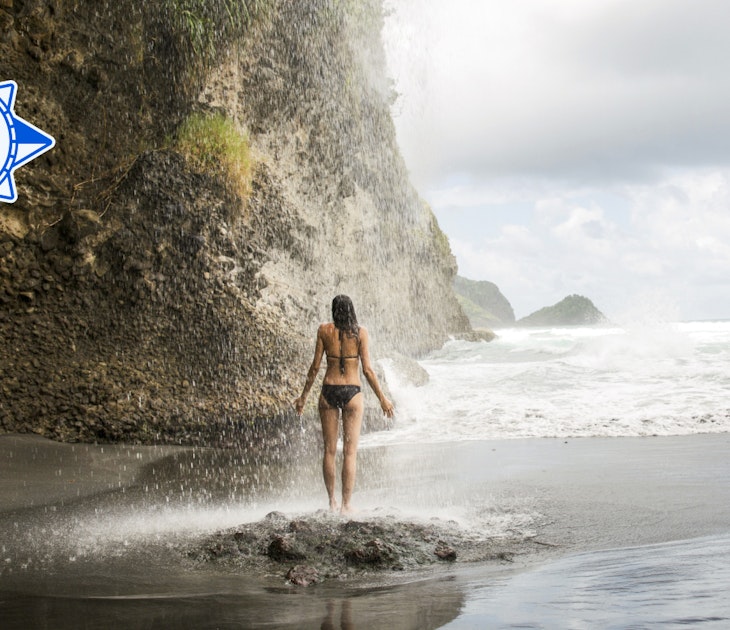
Wildlife & Nature
Feb 27, 2024 • 6 min read
April is the ideal time of year for mild-weather hikes, cherry blossom festivals, fresh produce and more.

Oct 16, 2023 • 9 min read
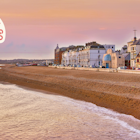
Aug 16, 2023 • 6 min read
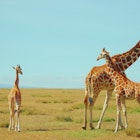
Aug 4, 2023 • 6 min read

Jan 2, 2023 • 12 min read
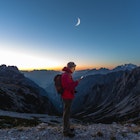
Sep 8, 2022 • 7 min read
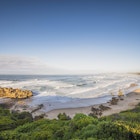
Dec 11, 2019 • 5 min read

Apr 25, 2024 • 7 min read

Mar 30, 2024 • 4 min read

Mar 20, 2024 • 8 min read
- Help Center
- Plan Your Visit
- Places to Stay
- Youth Programs
- Student & Youth Groups
- Dining Programs
- Events & Catering
- Live Cameras
- Our Mission
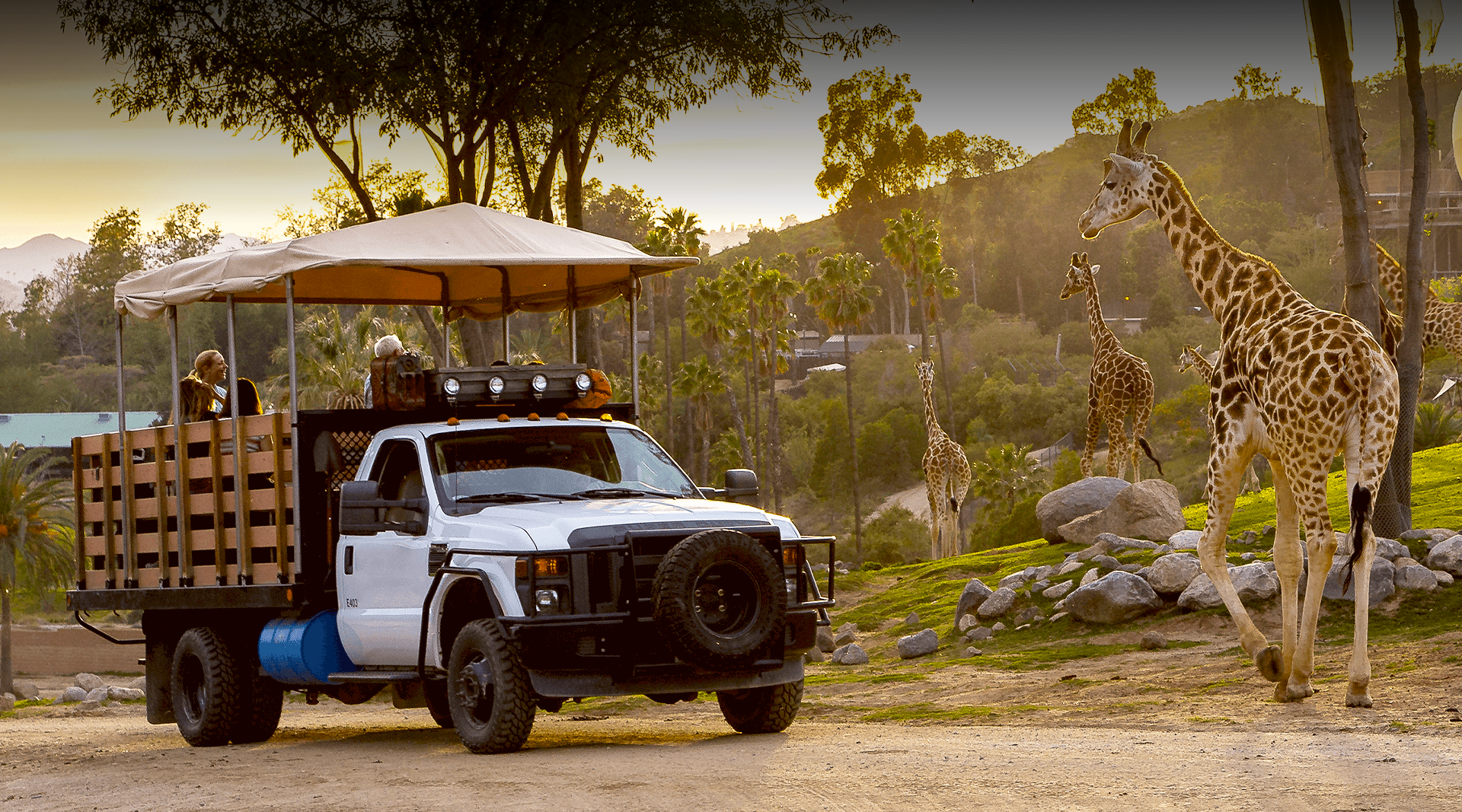
Get ready for an experience you’ll always remember!
Want to get up close and personal with your favorite wildlife, sit back and relax, or tackle a challenging adventure? Choose your safari!
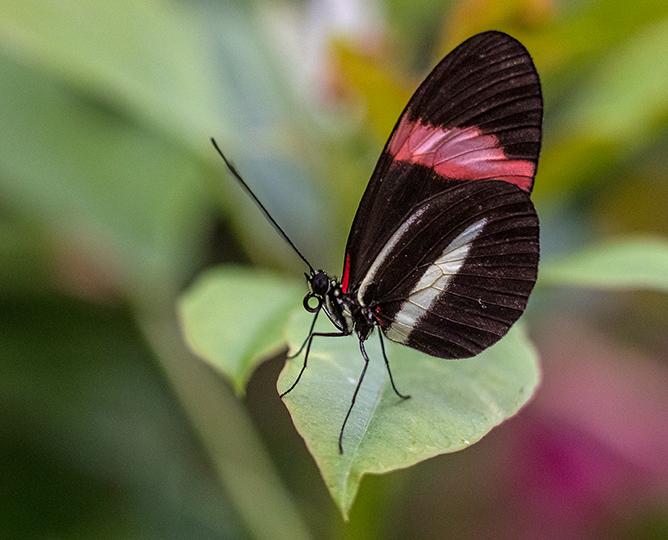
Butterfly Jungle Safari
- $15 per person
Visit Butterfly Jungle in an all new way! Learn about the butterfly life cycle on your way into the Hidden Jungle aviary, then become immersed in the wonder of colorful, fluttering butterflies.
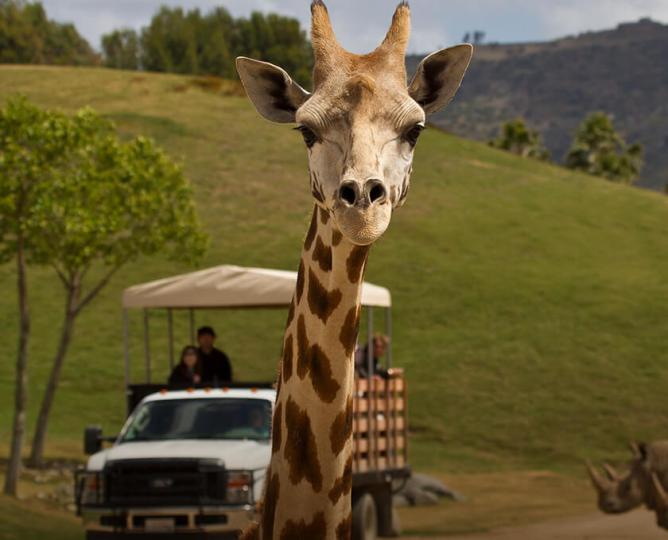
Wildlife Safari
- Ages 3 & up
- $92 & up per person
Travel in the back of a covered, open-air safari truck into our expansive savanna habitats, with an expert guide.
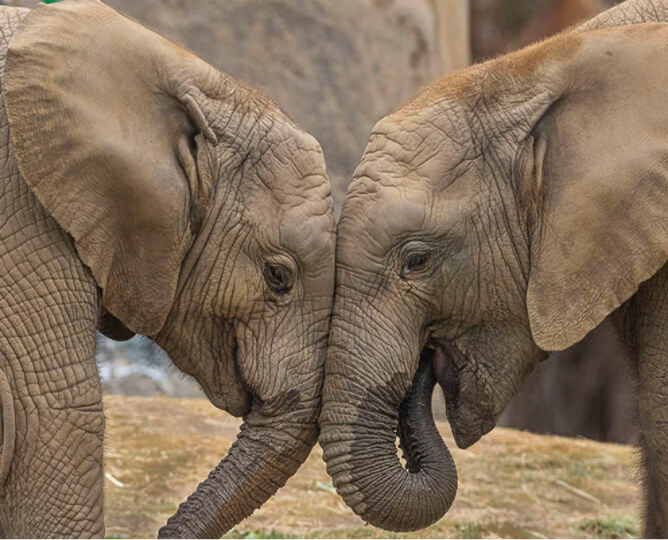
Behind-the-Scenes Safari
These Safaris are guaranteed to thrill and amaze! Your guide will escort you to a variety of locations around the Park to see animals up close and share stories of wildlife care and conservation.
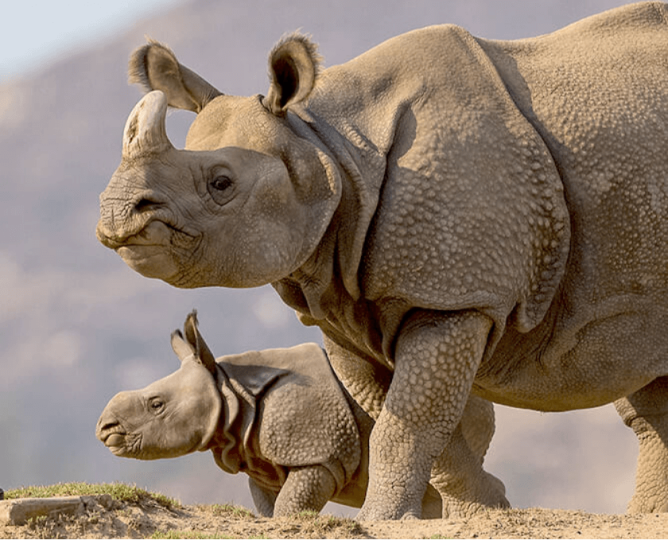
Cart Safaris
- $60 & up per person
Sit back in the comfort of a Safari cart, as you enjoy a 60-minute guided tour of the Park’s spacious African or Asian savanna habitats, led by one of our knowledgeable guides.
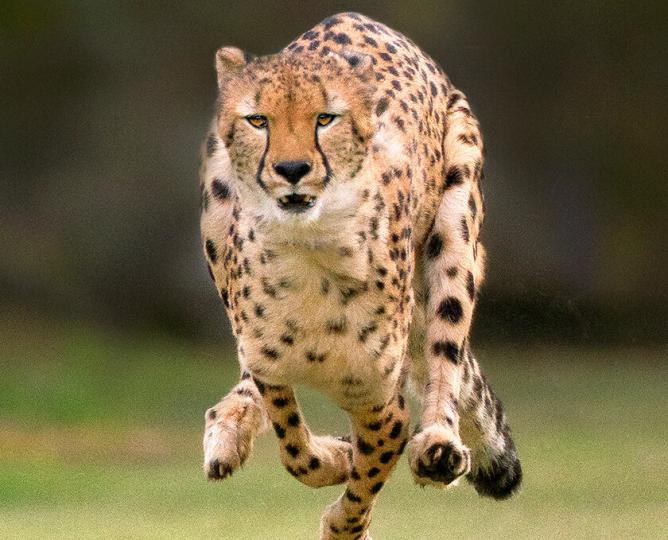
Sun Up Cheetah Safari
- $90 & up per person
Come join us at the Safari Park to see what happens before we open our gates to visitors, including watching a cheetah run at top speed!
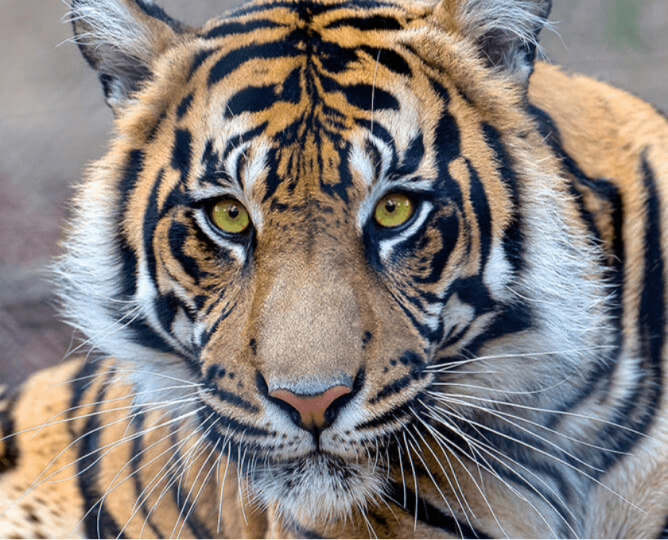
Ultimate Safari
- $710 & up per person
Enjoy a custom safari experience of a lifetime! The Ultimate Safari is your key to exclusive areas, wildlife interactions, and the very best in personalized service.
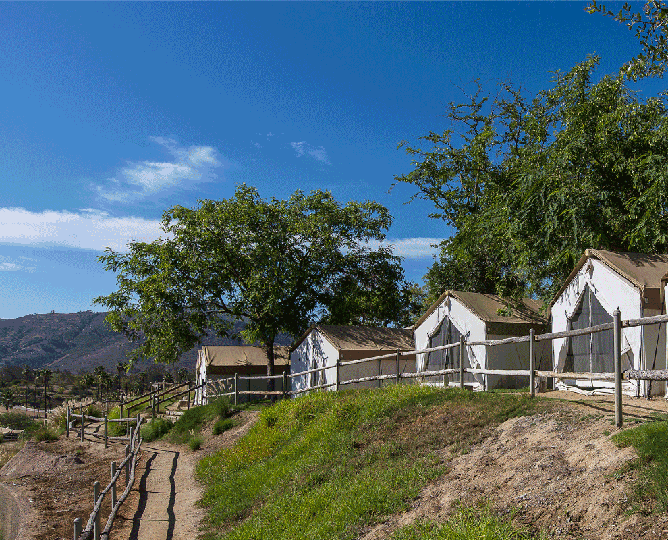
Roar & Snore Safaris
- $160 & up per person
Pack up your “trunk” for a sleepover adventure at the Safari Park! Choose from several age-appropriate sleepover categories with their own themes.
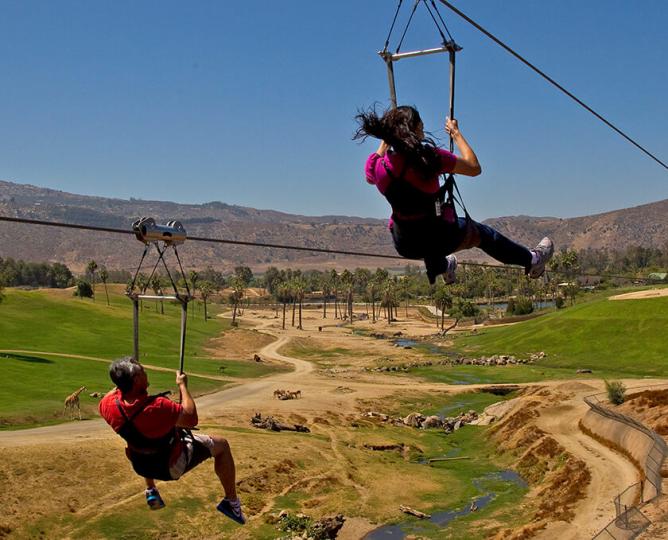
Flightline Safari
- Ages 8 & up
- $81 & up per person
Soar as high as 130 feet above the ground, with a spectacular bird’s-eye view of rhinos, giraffes, and other wildlife in the savanna habitats below you.

Save the Chubby Unicorns

Gorilla Shadow

PREFERRED HOTELS
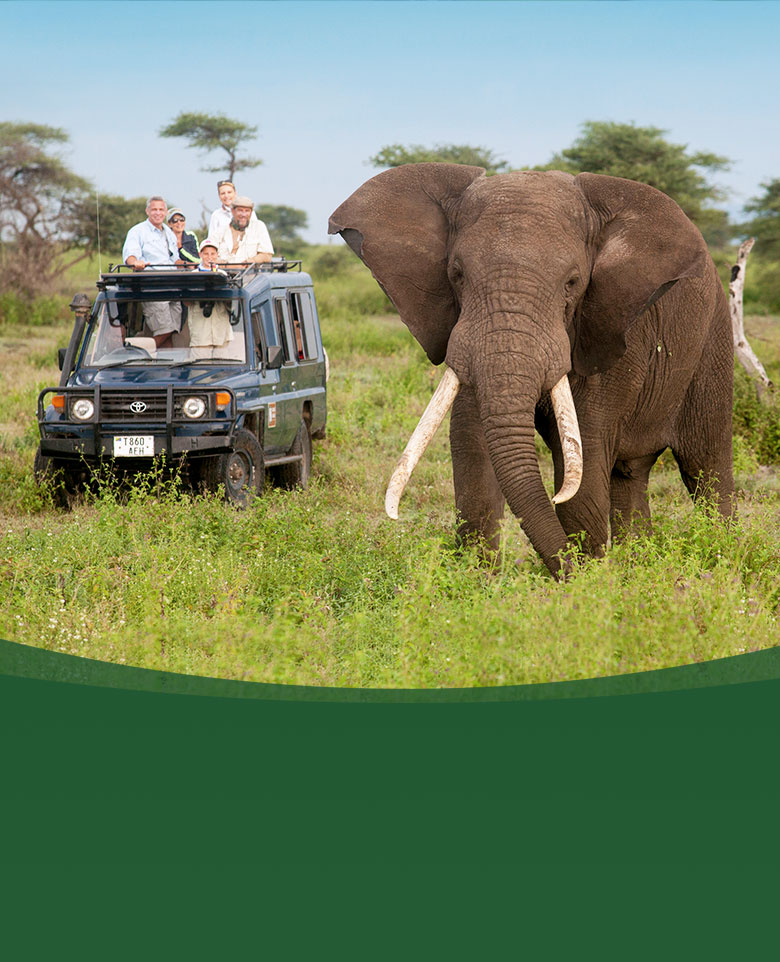
Come Travel with Us!
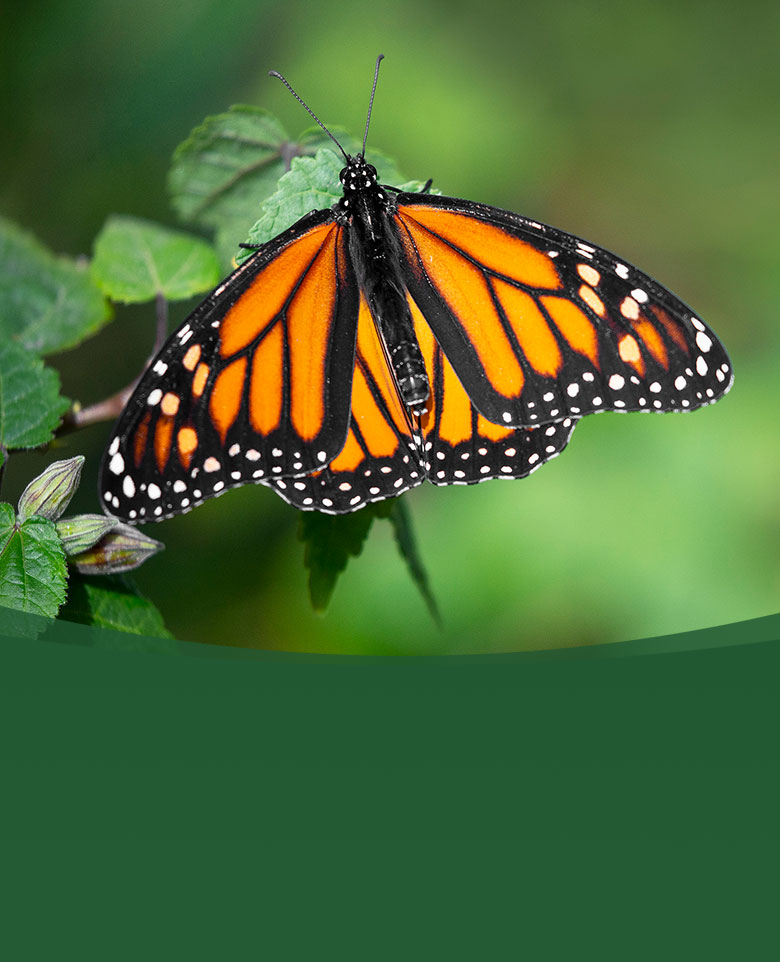
Travel with us to see Monarchs
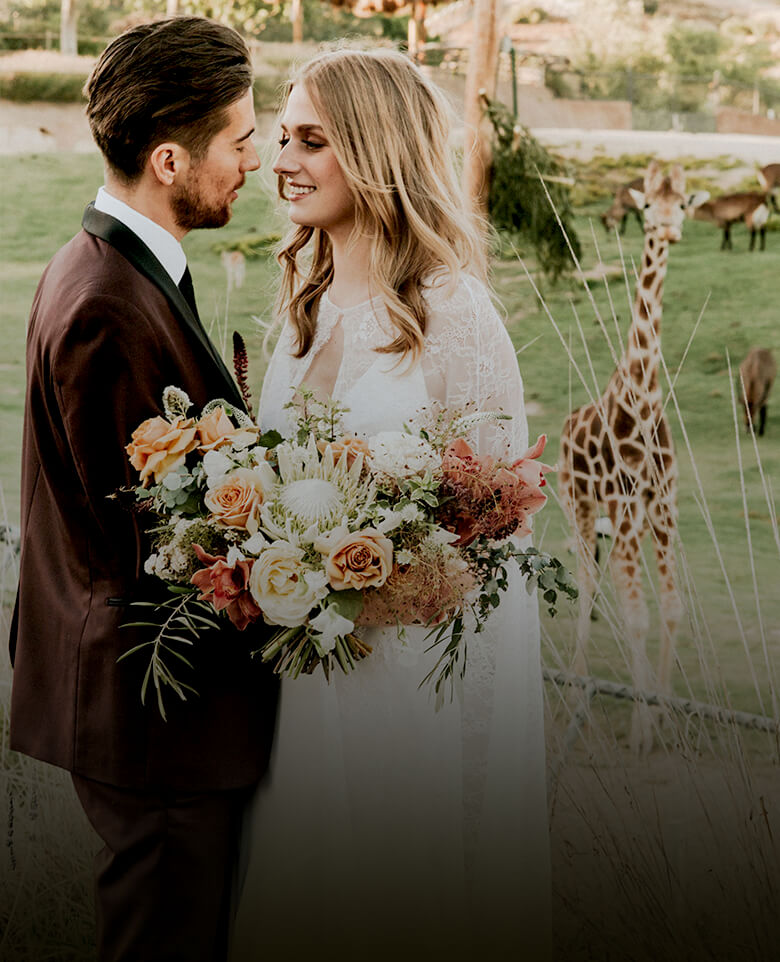
Picture Your Special Day at the Park!
- Cultural Tours
- Pricing & FAQs
- Meet the Team
- Mt Kilimanjaro
AFRIKA. THE BIRTHPLACE OF HUMANITY.
GET CONNECTED TO YOUR ROOTS

We're a team of locals who grew up together in a small village in Tanzania (+ one American) sharing a love and passion for the wildlife & nature, people & culture, and beauty of our home and we want to show it off to the rest of the world! We take pride in our reputation for hosting visitors and treating people like family. We are working towards uniting conservation, communities, and sustainable travel by employing locals, giving back to the community and partnering with other locally owned and eco-friendly companies. We may be a newer company but our staff shares a combined experience of over 40 years in tour operations so you are sure to have a safe, fun and a once in a lifetime adventure with us!
Welcome to Tanzania!
Karibu Tanzania!

What We Offer
Whether you're looking for an adventure through the plains of the Serengeti, a trek up Mt Kilimanjaro, an eye-opening cultural tour, relaxing on the beautiful beaches of Zanzibar or volunteering in the local community, we can help you make that happen! Simply let us know where you want to go, and we'll help you figure out the rest. We work directly with other companies to get the best deals and ensure you have a fun and life-changing experience!

Why Book With Us?
When you book with us you're not just going on Safari. You are making an impact on the lives of kids in our local community. A portion of the proceeds of every trip goes to Christ Hope Orphanage in Arusha. We support a total of 80+ kids ranging from primary school to local universities and beyond. While working with us we want you to be completely happy with the experience. If you have questions about us or our services, get in touch! We hope you continue to book with us for many years to come.

Witness the Great Migration!
THE GREAT MIGRATION. Afrika's race for life. The journey for the key players in the Great Migration, the roughly two million wildebeest, starts in the southern portion of Serengeti, with the birth of half a million calves between January and March. Serengeti National Park is the #1 safari destination in the world, the only place where you can witness millions of migrating wildebeest over the Acacia plains and probably the closest you will ever get to an untouched Afrikan wilderness!
Safari Packages
Cultural tours, join our mailing list.
Be the first to hear about upcoming trips, exciting destinations, and fun activities!
Copyright © 2023 Afrika Roots Safari Company Ltd. - All Rights Reserved.
Powered by GoDaddy
- Privacy Policy
- Terms and Conditions
This website uses cookies.
We use cookies to analyze website traffic and optimize your website experience. By accepting our use of cookies, your data will be aggregated with all other user data.
- Motorcycles
- Car of the Month
- Destinations
- Men’s Fashion
- Watch Collector
- Art & Collectibles
- Vacation Homes
- Celebrity Homes
- New Construction
- Home Design
- Electronics
- Fine Dining
- Aston Martin
- L’Atelier
- Les Marquables de Martell
- Reynolds Lake Oconee
- 672 Wine Club
- Sports & Leisure
- Health & Wellness
- Best of the Best
- The Ultimate Gift Guide
- You Can Now Drive a Porsche Through 5 African Countries With This New Off-Roading Experience
Speed across the continent in a souped-up 911, Cayman, or Cayenne with a convoy of petrolheads.
Rachel cormack.
Digital Editor
Rachel Cormack's Most Recent Stories
- American Magic Just Unveiled Its Sleek New America’s Cup Race Boat
- Forget Pools. This New 131-Foot ‘Mini-Megayacht’ Is Fronted by an Infinity Jacuzzi.
- Share This Article

Kalmar Beyond Adventure is giving the Dakar Rally a run for its money.
Related Stories
How climate change could disrupt the future of travel, according to a new study, a bevy of luxury resorts is about to transform this quiet costa rica province.
- Dubai Just Got 3 New Luxe Hotels. Here’s a Look Inside.

The driving itself will be as diverse as the landscape. Some days will require precise steering, while others will demand breakneck speed. Similarly, you’ll spend some time traveling in a convoy and other times solo. Each driver has to pass a short qualification test to ensure they’re up to the task.
Kalmar says guests will catch Zs in “superb accommodation,” including some of Africa’s finest lodges and villas. You’ll also have ample opportunities to experience the local cultures, cuisines, sites, and wildlife. Highlights include Victoria Falls, the local markets, and the game reserves.
“Trans-Africa 2025 will be the adventure trip of a lifetime,” Kalmar said in a statement. “It allows guests to explore new frontiers, get close to wildlife, and under the skin of the real Africa—all through the windscreen of an iconic Porsche sports car.”
The Trans-Africa adventure starts from €66,900 (roughly $71,600) plus taxes. For more information, visit the Kalmar Beyond Adventure website .
Click here to see all the photos of the Porsche Safari.

Rachel Cormack is a digital editor at Robb Report. She cut her teeth writing for HuffPost, Concrete Playground, and several other online publications in Australia, before moving to New York at the…
Read More On:
More destinations.

A New High-Speed Train Between Las Vegas and California Breaks Ground This Week

This African Safari Lodge Just Got a Luxe Makeover. Here’s a Look Inside.

Culinary Masters 2024
MAY 17 - 19 Join us for extraordinary meals from the nation’s brightest culinary minds.
Give the Gift of Luxury
Latest Galleries in Destinations
Kalmar beyond adventure’s porsche safari in photos.

Oceaya in Photos
More from our brands, l catterton acquires majority stake in kiko milano, dumb luck: nba dodges bullet as jontay porter fouls out, annecy selection ‘the glassworker’ unveils first trailer, sets cannes market, pakistan release dates (exclusive), centre pompidou’s economic model is unstable, france’s court of auditors reports, the best yoga mats for any practice, according to instructors.

Things To Do | Dinosaurs returning to African Safari Wildlife…
Share this:.
- Click to share on Facebook (Opens in new window)
- Click to share on X (Opens in new window)
- Entertainment
- Food & Drink
- TV Listings
- More Puzzles
- Jumble and More
Things To Do
Things to do | dinosaurs returning to african safari wildlife park in port clinton.

More than 20 moving, roaring, life-sized prehistoric creatures are returning to Port Clinton as part of Dinosaur Takeover, returning April 27 to African Safari Wildlife Park , according to a news release.
Highlights include fan favorites like triceratops and stegosaurus, the carnivorous australovenator and allosaurus, and a 40-foot-long tyrannosaurus rex, all scattered throughout the Park’s Walk-Thru Safari, 267 S. Lightner Road in Port Clinton, the release said.
Dinosaur enthusiasts can pose for photos in larger-than-life eggs and pick up an educational scavenger hunt in the Safari Gift Shop, the release said.
As part of the park’s mission to promote an appreciation for all living things, visitors will learn about the conservation challenges faced by today’s wildlife and how the park is helping to prevent extinction in the 21st century, according to the release.
“Dinosaur Takeover was a huge hit last summer and added another level of excitement to the guest experience,” said park director Kelsey Keller in the release. “It’s a real ‘blast from the past.’”
Dinosaur Takeover is included with general admission and runs daily through Labor Day.
More in Things To Do

SUBSCRIBER ONLY
Entertainment | bon jovi’s long career documented, warts and all, in new hulu series.

Movies | How does Zendaya tennis film ‘Challengers’ rank with other Hollywood love matches

Want to cook vegetables better? The new Kismet cookbook shows us how

‘Fallout’ review: Walton Goggins as a swaggering, post-apocalyptic cowboy
THE 5 BEST Moscow Safaris
Safaris in moscow.
- Adrenaline & Extreme Tours
- Gear Rentals
- Nature & Wildlife Tours
- 5.0 of 5 bubbles
- District Central (TsAO)
- 3rd Transport Ring (TTK)
- District North-Eastern (SVAO)
- District Eastern (VAO)
- District South-Western (YuZAO)
- Lomonosovskiy
- Ostankinskiy
- Meshchanskiy
- Krasnoselskiy
- Maryina Roshcha (Jewish Quarter)
- Good for Couples
- Good for Kids
- Good for Big Groups
- Adventurous
- Budget-friendly
- Good for a Rainy Day
- Hidden Gems
- Honeymoon spot
- Good for Adrenaline Seekers
- Things to do ranked using Tripadvisor data including reviews, ratings, photos, and popularity.

1. Rybokhotsoyuz

2. Easy Russia Tour Guide
3. UTS GROUP

4. 365AltaiMongolia

5. #1 Russia -Tanzania | Zanzibar, Serengeti Safari & Kilimanjaro Agency | BURIGI CHATO SAFARIS CO LTD

6. Aviashop.Ru

7. Transsib Moscow

8. BASK TOUR
- Easy Russia Tour Guide
- #1 Russia -Tanzania | Zanzibar, Serengeti Safari & Kilimanjaro Agency | BURIGI CHATO SAFARIS CO LTD
- 365AltaiMongolia
2018 Primetime Emmy & James Beard Award Winner
R&K Insider
Join our newsletter to get exclusives on where our correspondents travel, what they eat, where they stay. Free to sign up.
A History of Moscow in 13 Dishes
Featured city guides.
Shooter Files by f.d. walker
Street Photography Tips, Interaction, Travel, Guides
Apr 24 2017
City Street Guides by f.d. walker: A Street Photography Guide to Moscow, Russia

*A series of guides on shooting Street Photography in cities around the world. Find the best spots to shoot, things to capture, street walks, street tips, safety concerns, and more for cities around the world. I have personally researched, explored and shot Street Photography in every city that I create a guide for. So you can be ready to capture the streets as soon as you step outside with your camera!
At over 12 million people, Moscow is the largest city in Russia and second largest in Europe by population ( Istanbul is #1). An urban, cosmopolitan metropolis with more than enough glitz and glam to cater to the elite, but without losing its fair share of Soviet era roughness around the edges. It can be fast paced, brash, busy, and trendy like other big cities, but it has its blend of West meets Russia atmosphere and beauty that provides plenty of unique interest. The Red Square is as famous as it gets, but there’s so much more to this city, including the most beautiful subway system you’ve ever seen. It would take years to capture all of Moscow, but that means you have an endless amount of areas to discover.

So here’s a Street Photography guide so you can be ready to capture all that Moscow has to offer before you even arrive!
- Patriarch’s Pond
- Old Arbat Street
- Maroseyka Street
- Tverskoy Boulevard
Top 5 Street Spots:
1. red square.
The Red Square is the most famous square in not just Russia, but all of Eastern Europe. The name actually doesn’t come from the color of the bricks or communism, but from the name in Russian, Krásnaya, once meaning “beautiful” before its meaning changed to “red.” This large plaza is what you see on the cover of guide books and magazines for Moscow, with St. Basil’s Cathedral being the center piece next to Lenin’s Mausoleum surrounded by the Kremlin Wall. Of course, the Red Square attracts hordes of tourist due to the main attractions, but all that activity around an interesting atmosphere does provide street photo opportunities. It’s also the central square connecting to the city’s major streets, providing a good starting point to explore outward.

You’ll also find the popular pedestrian only Nikolskaya Street connecting the Red Square to Lubyanka Square. This line of expensive shops includes plenty of activity, while also leading you to another popular square. Filled with history rivaling any city, the Red Square and surrounding areas are the heart and soul of Russia.

2. Patriarch’s Ponds
Patriarch’s Ponds is one of the most exclusive neighborhoods in Moscow. Despite the name being plural, there’s only one large pond, but it’s worth a visit with your camera. It’s a popular spot for locals and expats to come relax or take a stroll around the pond. You get an interesting mix of young and old too, from young love to “babushkas” feeding pigeons. It’s a very peaceful park atmosphere in one of the nicer areas within the city center, while bringing enough activity for street photography.

The pond is shallow and in the winter becomes a popular spot for ice-skating too. The area is also well-known for the location in the famous Russian novel, The Master and Margarita.
3. Old Arbat (Stary Arbat)
Old Arbat is the most famous pedestrian street in Moscow, and dating back to the 15th century, also one of its oldest. Originally, it was an area of trade, but soon became the most prestigious residential area in Moscow. During the 18th century, Arbat started attracting the city’s scholars and artists, including Alexander Pushkin. Cafes lined the streets and impressive homes filled the neighborhood. Since then, New Arbat street was created as a highway in the area, while Old Arbat was paved for a 1km pedestrian only walkway.

Due to the historic buildings, famous artists that lived here, and the bohemian atmosphere, Old Arbat has become a big attraction for tourists today. Now, there’s a mix of cafes, restaurants, souvenir shops, street performers, street merchants and other attractions for visitors, and some locals, to come enjoy. It can get really busy here and there’s usually something interesting going on so it’s a good street to come walk with your camera for guaranteed life.
4. Gorky Park
One of the most famous places in Moscow is Gorky Park. The official name is Maxim Gorky’s Central Park of Culture & Leisure, which gives you an idea of what goes on here. When built, it was the first of its kind in the Soviet Union. Divided into two parts, it stretches along Moscow River. One end contains fair rides, foods stands, tennis courts, a sports club, a lake for boat rides, and more. This end brings more active life due to its number of attractions, while the other end is more relaxed, where you’ll find gardens, trees, older buildings, and an outdoor amphitheater.

Gorky Park attracts mostly locals so it’s a good spot to capture the non-tourist side of Moscow life. Muscovites come here to escape the city and unwind in a picturesque setting. The park remains alive outside of the warmer months too, especially when the lake turns into the city’s largest outdoor skating rink. I’d recommend taking the metro out here to spend at least half a day exploring the massive park’s life with your camera.
5. Maroseyka Street
Maroseyka Street is a popular area not too far from the Red Square. The long, winding street turns into Pokrovka and is lined with restaurants, cafes, bars and places to stay. It’s actually where I like to stay when I’m in Moscow due to its location and solid street photography opportunities itself. You have Kitay-gorod station near and if you keep walking southwest, you’ll get to the Red Square. But if you walk northwest, as it changes to Pokrovka, you can find a long street of activity for photography with its own interesting atmosphere.

6. Tverskoy Boulevard
Tverskoy Boulevard is the oldest and longest boulevard in Moscow, beginning at the end of Nikitsky Boulevard, and finishing at Pushkin Square, a spot to come for activity itself. The boulevard is made up of two avenues, with pedestrian walkways in-between. You’ll find grass, shrubbery, trees, benches and more walking it’s almost kilometer length. Many people come here to enjoy some relaxation, walk their dog, or just to use it to walk wherever they’re going. Its center location also provides a nice place to walk with your camera near plenty of other spots you’ll want to check out anyway.
Sample Street Walk:
For a full day of Street Photography, covering some of the best spots, you can follow this sample street walk for Moscow:
- Start your morning walking around the Red Square (1), while exploring the surrounding area, including Nikolskaya Street
- Then walk northwest to Patriarch’s Ponds (2) and slowly walk the pond and surrounding area with your camera
- Next, walk east to the Pushkin Monument and stroll down Tverskoy Boulevard (6)
- Once Tverskoy Boulevard (6) ends, it will turn into Nikitsky Boulevard. Follow this down until you get to the start of Old Arbat Street (3), across from Arbatskaya station
- After you’re done walking down Old Arbat Street (3) for more street photography, spend some time checking out Moscow’s beautiful metro stations
- To finish off the day with more street photography, get off the metro near Red Square (1) again, Maroseyka Street (5) or wherever you’re staying for the night.

3 Things I’ll Remember about Shooting in Moscow:
1. museum metro.
The Moscow metro system was the first underground railway system in the Soviet Union and today includes 203 stations across 340km of routes. The elaborate system has some of the deepest stations in the world too, with escalators that seem to go on forever. None of this is what makes it so special, though. Many of its stations feel like stepping inside a museum, making it without a doubt the most interesting and beautiful metro system I’ve been in.

When built, Stalin wanted to make the metro stations “palaces for the people” with marble, chandeliers, and grand architecture. The best part is the variety of architecture and styles used, making many of the stations a completely different experience visually. You could easily spend a whole day traveling the stations and there are even tours available for people who wish to do just that. My advice, though, would be just to buy a ticket and hop on and off at different stations, while exploring different lines. The museum-like surrounding mixed with the crowds of characters can make for a great photography experience.

Since there are so many stations, here are some of my favorites to check out:
- Novoslobodskaya
- Mayakovskaya
- Elektrozavodskaya
- Komsomolskaya
- Ploschad Revolyutsii
- Dostoyevskaya
- Prospekt Mira

2. Moscow is Big
It’s no secret that Moscow is a big city, but it can feel even bigger with how spread out much of it is. This is especially true if you compare it to cities outside of Asia. If I compared it to cities in Europe, I’d probably say only Istanbul would warrant more time to really discover the depths of this city. Most only explore around the Red Square and surrounding area, but that is such a small part of the city. Although, that central area does give you plenty to see on its own.

Fortunately, I had a good friend living in the city to show me around, but it opened up my eyes even more to how much there is to discover in Moscow. It’s a big city with a variety of atmosphere that can take you from “east” to “west” and trendy to rugged depending on where you go. I’d imagine you’d have to live here a while to really know the city.
3. Cosmopolitan Mix of East meets West
Modern skyscrapers mixed with amazing architecture, a world-class metro system with museum-like beauty, trendy fashion and chic clubs, Moscow is a rich mix of Russian culture and history in a more western cosmopolitan package. There is a push to keep the Russian culture, while also pushing forward with a modern metropolis the whole world will envy. This comes with an impressive skyline, that continues to grow, and endless modernities, but with soviet nostalgia and atmosphere mixed in for good measure.

Mixed in with this grand western cosmopolitan atmosphere, is a strong national pride in Russia. This includes their famous leader, Vladimir Putin. Maybe no other place will you see a country’s leader more often. All over, from the pricey tourist shops to the underground walkway stalls, you’ll find goods with Putin’s likeness covering them. From t-shirts to magnets to Matryoshka dolls. There’s a strong national pride that can be seen around the city, which also extends to their leader. Moscow is many things. It’s East meets West, modernizations meets Soviet era, and a whole lot more.
What To Do For a Street Photography Break?:
Eat at a stolovaya.
Stolovayas are Russian cafeterias that became popular in the Soviet days. You grab a tray and walk down the line of freshly prepared local dishes, and select whatever you want from the chefs. They’re usually inexpensive and a much better value than restaurants, while giving you the opportunity to try from a wide selection of everyday Russian food. They’re also very tasty. I always include some borsch on my tray and go from there. The places themselves are all over Moscow and usually come with Soviet-era aesthetics to complete the experience.

Street Safety Score: 7
*As always, no place is completely safe! So when I talk about safety, I’m speaking in general comparison to other places. Always take precaution, be smart, observe your surroundings and trust your instincts anywhere you go!
Being the 2nd largest city in Europe with over 12 million people, you’re going to have your dangerous areas, but for the most part, it feels safe walking around. Russia is statistically higher in crime compared to most of Europe, but this generally doesn’t apply to tourists and visitors. Around the Red Square and surrounding city center, you should feel completely safe walking around. Pick pocketing can happen, but no more than other touristic places. I always explore Moscow freely without coming across too much to worry about. It’s a spread out city, though, so of course it matters where you are. Just use basic street smarts, know where you are and Moscow shouldn’t give you a problem.

People’s Reaction Score: 7
Moscow is fast paced, big city life, which usually means people aren’t too concerned with you, or your camera. I don’t find people notice or pay much attention to me when I’m out taking photos in Moscow. For the most part, people just go about their day. You shouldn’t get too many looks or concern. But it can depend on the area you are in. The more you stick out, the more you might get noticed with suspicions. I’ve never had any problems in Moscow, or Russia, but just be careful who you’re taking a photo of if you get out of the city center. Other than that, it’s about average for reactions.

Street Tips:
Learn the alphabet .
Much of Moscow, including the metro system, doesn’t use english. The Russian alphabet uses letters from the Cyrillic script, which if you aren’t familiar with it and don’t know the sounds, can be hard to decipher the words. This is most important for street names and metro stops when trying to get around. It can save confusion and make it easier getting around if you learn the basic alphabet. At the very least then, you can sound out the words to see which are similar in the english conversion, which can help matching them to maps. When out shooting street photography, getting around is as important as anything. So save yourself some time and frustration by learning the Russian Alphabet.

Use the metro
While Saint-Petersburg feels very walkable for a city its size, Moscow can feel very spread out, even for its bigger size. Outside of the Red Square area, you can have plenty of walking before getting anywhere very interesting, so you’ll need to take the metro a lot if you really want to explore the city. Maps are deceiving here too, it will always be further than it looks.

Another reason it’s less walkable than Saint-Petersburg is its completely different set-up. Moscow’s streets are mostly contstructed in rings with narrow, winding streets in-between. This is common with medieval city cities that used to be confined by walls, but you usually don’t have it in a city this massive. Saint-Petersburg has a more grid-like pattern that also uses the canals to help you know your way around. When it comes to navigating on foot in Moscow, it can be more difficult, so bring a map and take the metro when needed. It’s why Moscow’s metro carries more passengers per day than the London and Paris subways combined.
Explore other areas if you have time
Moscow is really big. While most people stay around the Red Square within the Boulevard Ring, there’s so much more to the city. I covered some other spots outside of this circle, but if you really want to see the city, you’ll need time. If you do have time, some other areas I’d check out first are Zamoskvarechye, along some of the south and western Moscow.

Inspiration:
For some more inspiration, you can look through the Street Photography of Moscow photographer Artem Zhitenev and check out 33 of my photos taken in Moscow .
Conclusion:
Moscow’s name brings a certain mystique, but once you’re there it might bring a different atmosphere than you expect. It’s big and sprawling, but beautiful in many ways. It can feel like a European capital on a grand scale, but you can definitely find its Russian side in there.

The urban sprawl of Moscow can be intimidating, but give it enough time and you’ll be rewarded with plenty to discover. All with the world’s best metro system to take you around.
I hope this guide can help you start to experience some of what Moscow contains. So grab your camera and capture all that Moscow has to offer for Street Photography!
If you still have any questions about shooting in Moscow, feel free to comment below or email me!
(I want to make these guides as valuable as possible for all of you so add any ideas on improvements, including addition requests, in the comment section!)
Click Here For More City Street Guides!
(A New Guide Posted Every Other Wednesday)

Comment Here! Cancel reply
For patreon exclusive educational content:.

Limited Edition Postcard Prints!
Street Photography Workshops
Donations Always Appreciated
I'll always keep Shooter Files free for everyone, but any donations would be greatly appreciated and help me keep it going. Many thanks to everyone following along!
Cheers! -f.d. walker
Search the Files

For Exclusive Patron Content:

IMAGES
VIDEO
COMMENTS
Veröffentlicht am 11. September 2023 von Juan Proll. Wann ist die beste Reisezeit für eine Safari in Afrika? Ob in Südafrika, Namibia, Botswana, Tansania, Kenia oder Uganda: Wann ist die beste Reisezeit für eine Safari in Afrika?Antworten für das östliche und südliche Afrika findet ihr hier heute im Überblick.
Beste Reisezeiten für einen Safari Urlaub in Afrika. Kenia: Januar bis März: Trockenzeit, die Tiere sind einfach an den wenigen Wasserstellen zu finden. Juli bis Oktober: Trockenzeit, Tierwanderungen durch das Maasai Mara Gebiet. April, Mai und November: Zwischensaison, günstige Reisezeit.
March is a great time to take advantage of low-season deals. A South African safari is also a great choice this month, offering milder weather, fewer visitors, and excellent wildlife sightings in places like Sabi Sands Game Reserve.. Highlights on a safari in March. The Great Migration in Tanzania, with huge herds of wildebeest on the move.
April to May (the 'long rains') November to December (the 'short rains') Generally, the main rainy season (the long rains) produces tropical downpours in the afternoons and many safari camps close. The short rains season sees the occasional brief shower, but safari camps stay open and game viewing is good. Most Kenya safari destinations ...
Best time to visit: May to October in the north and eastern parts; October to November and February to March in the Southern Cape region. Watch out: Between May to August in the north and eastern parts, expect cool and dry weather with temperatures dipping below -12°C at night. BEST TIME TO VISIT SOUTH AFRICA.
Erfahrt, wann die beste Reisezeit für Südafrika ist ☀️ - mit Klimatabellen, Infos zum Wetter, Tipps und Angeboten! Beste Reisezeit Südafrika 2024. ... Als beste Reisezeit für eine Südafrika Safari gelten die südafrikanischen Wintermonate Juni, Juli, August, September und Oktober. Der Grund: Die Wildreservate und Nationalparks sind ...
Equatorial East Africa (Kenya, Tanzania, Rwanda and Uganda) has its main dry season from June to October, with a secondary drier season from mid-December to mid-March. November is historically known as the time of the 'short rains', whilst April and May host the 'main' rains. However, it can rain at any time in East Africa and so the ...
The African continent is massive, comprising 54 unique nations and nearly 2,000 languages. Most safaris take place in two main savanna regions of the African continent: Southern and East Africa. The Southern Africa region includes South Africa, Botswana, Namibia, Zambia and Zimbabwe. East Africa contains the safari destinations of Kenya ...
The best time to go on safari is between June and October, during the dry season. This is a cooler time of the year and you are more likely to see animals, who are searching for water sources. During these months, you can also catch the iconic Masai Mara migration. Here is a breakdown of some of the best countries to visit, when to go, and the ...
Morning. Most days on safari begin before dawn. While watching the sunrise in Africa is reason enough to rise before the sun, you're also up early because the first two hours of daylight are the best times to see wildlife - in the cool of early morning, most animals are out and about and active (even some of the nocturnal species such as ...
Botswana. September is the best time to visit Botswana. Famous spots like Okavango, Moremi, Chobe, and the Linyanti are truly at their very best. Chobe and Linyanti is the elephant capital of Africa for the time. Meanwhile, the Okavango Delta is flooded and sparkling with beauty.
Green means go. While every luxury safari offers unforgettable wildlife encounters, there are plenty of options to consider. High-end African trips and settings vary hugely in their atmosphere and ...
Safari in Südafrika: 5 Tipps zur besten Reisezeit. Veröffentlicht von. WE'DESIGNTRIPS. Bei WeDesignTrips helfen Dir lokale Experten von Reiseveranstaltern unverbindlich Deine individuelle Südafrika Reise zu planen. Jetzt Reiseplanung starten. Top Südafrika Reisen & Routen entdecken →.
Niarra Travel offers a 13-day Victoria Falls, Okavango, and Cape Town itinerary that incorporates the Zambezi River and Falls into a three-country itinerary (Zambia, Botswana, and South Africa). Jennifer Flowers. Jennifer Flowers is an award-winning journalist and the senior deputy editor of AFAR. When it comes to choosing a safari in Africa ...
Plan For Your Visas. After you decide where to go for your safari in Africa, you should consider visa requirements for the destination. As Americans, we can enter South Africa, Namibia, and Botswana visa-free. Zambia and Zimbabwe both require entry visas, but this can be done on arrival at the airport or land border.
15. Be Medically Prepared. Being medically prepared is one of the key African safari travel tips for first-timers. Before your trip, make sure you visit a travel clinic or consult with your healthcare provider, and check the CDC's recommendations to ensure you are up to date on any recommended vaccinations.
First Time Safari Tip #3: Now! Now! Anyone familiar with "Africa time" will understand that there are several meanings to the word now. There is "now," "just now," and "now now." "Now" could mean anywhere from five minutes to two months later. "Just now" means in the next hour or so.
Budgeting and costs for a safari in Botswana. Stays at isolated camps in the Okavango Delta start at roughly $650 per person, per night and can go up to an eye-watering $4000 a night. At approximately $300, Chobe National Park lodges are more affordable - so stretch out your days here to keep costs down.
These Safaris are guaranteed to thrill and amaze! Your guide will escort you to a variety of locations around the Park to see animals up close and share stories of wildlife care and conservation. ... Sit back in the comfort of a Safari cart, as you enjoy a 60-minute guided tour of the Park's spacious African or Asian savanna habitats, led by ...
THE GREAT MIGRATION. Afrika's race for life. The journey for the key players in the Great Migration, the roughly two million wildebeest, starts in the southern portion of Serengeti, with the birth of half a million calves between January and March. Serengeti National Park is the #1 safari destination in the world, the only place where you can ...
The Trans-Africa adventure starts from €66,900 (roughly $71,600) plus taxes. For more information, visit the Kalmar Beyond Adventure website . Click here to see all the photos of the Porsche Safari.
More than 20 moving, roaring, life-sized prehistoric creatures are returning to Port Clinton as part of Dinosaur Takeover, returning April 27 to African Safari Wildlife Park, according to a news ...
These places are best for safaris in Moscow: Easy Russia Tour Guide; UTS GROUP #1 Russia -Tanzania | Zanzibar, Serengeti Safari & Kilimanjaro Agency | BURIGI CHATO SAFARIS CO LTD; 365AltaiMongolia; BASK TOUR; See more safaris in Moscow on Tripadvisor
Walking tour around Moscow-City.Thanks for watching!MY GEAR THAT I USEMinimalist Handheld SetupiPhone 11 128GB https://amzn.to/3zfqbboMic for Street https://...
This tour of Moscow's center takes you from one of Moscow's oldest streets to its newest park through both real and fictional history, hitting the Kremlin, some illustrious shopping centers, architectural curiosities, and some of the city's finest snacks. Start on the Arbat, Moscow's mile-long pedestrianized shopping and eating artery ...
*A series of guides on shooting Street Photography in cities around the world. Find the best spots to shoot, things to capture, street walks, street tips, safety concerns, and more for cities around the world. I have personally researched, explored and shot Street Photography in every city that I create a guide for. So you can be […]